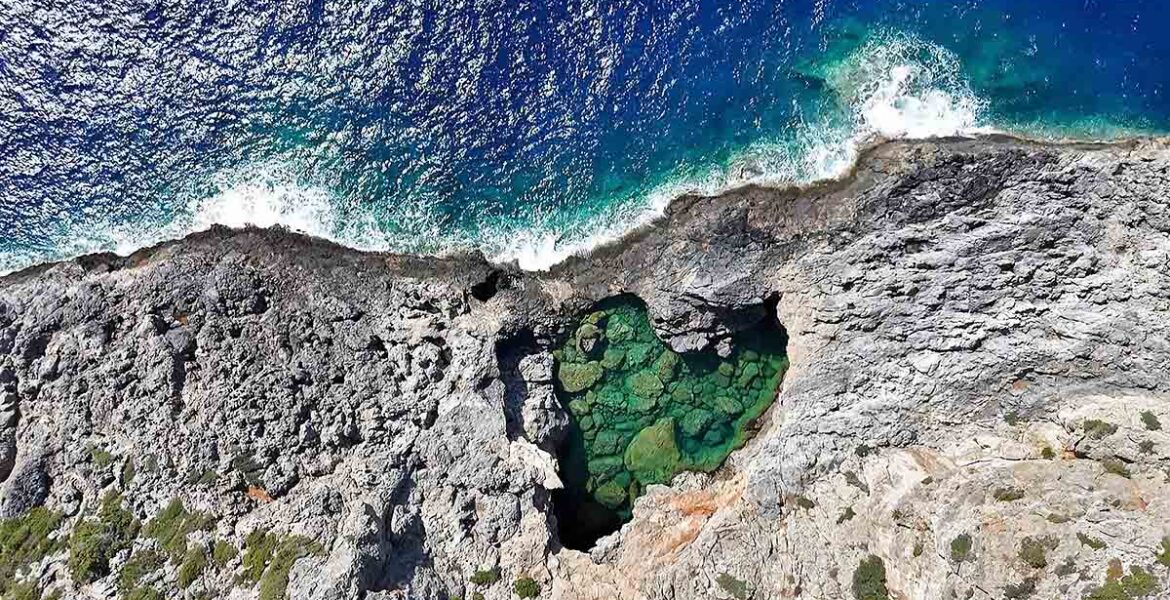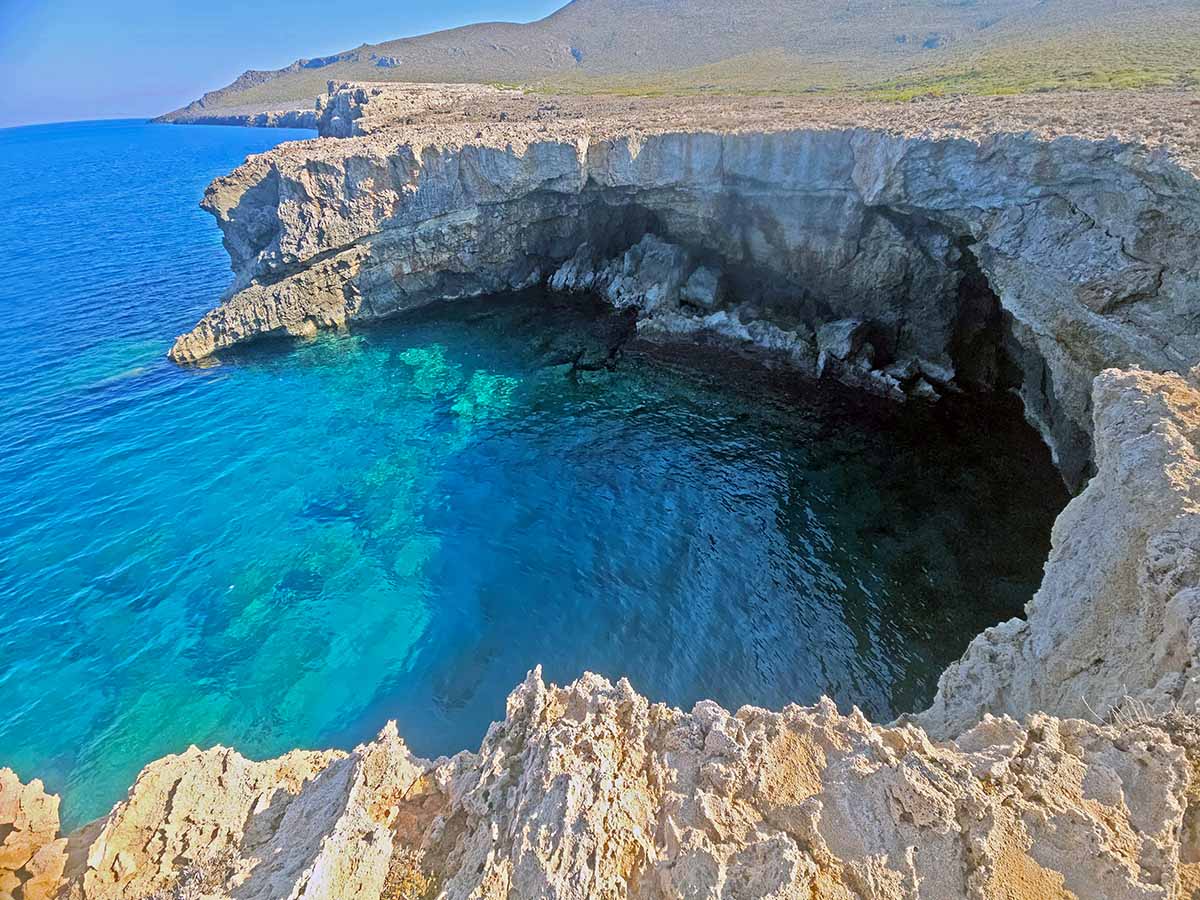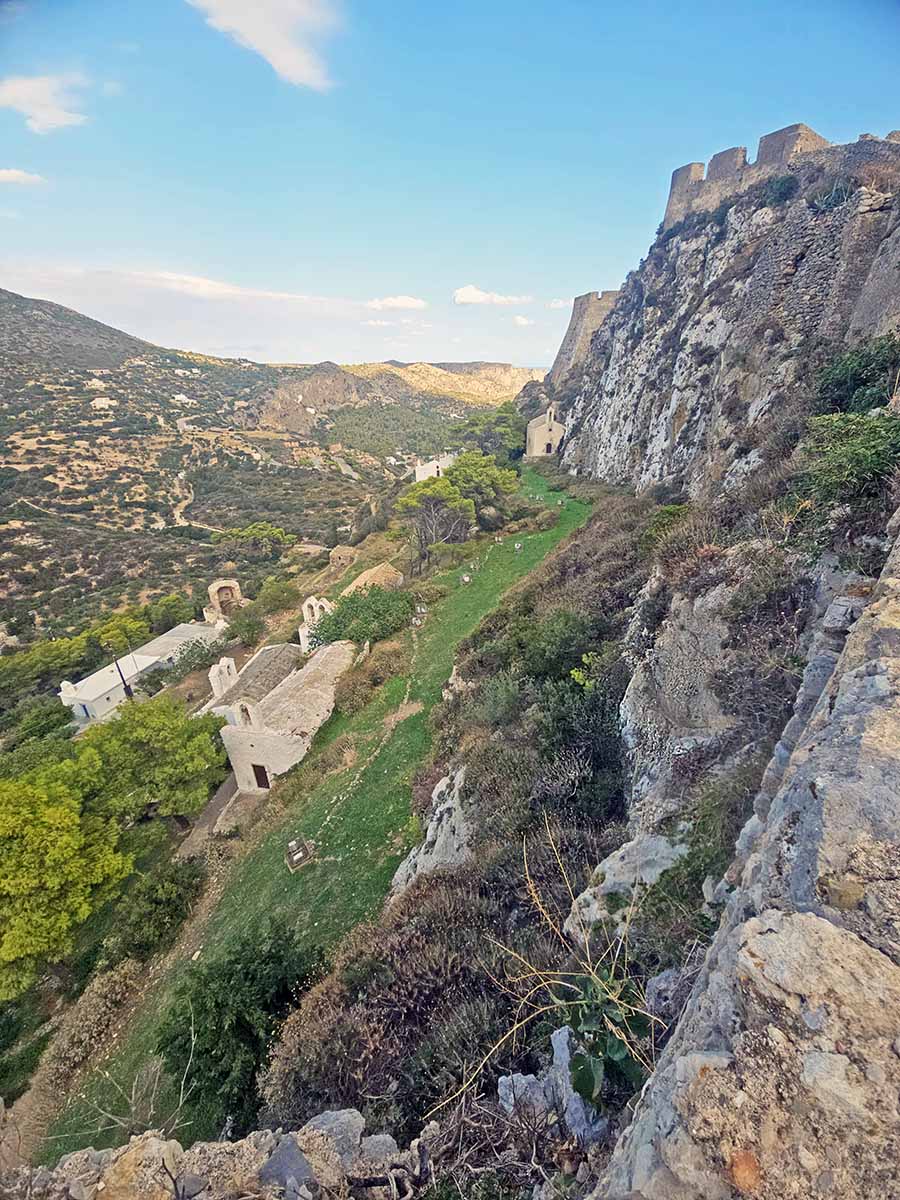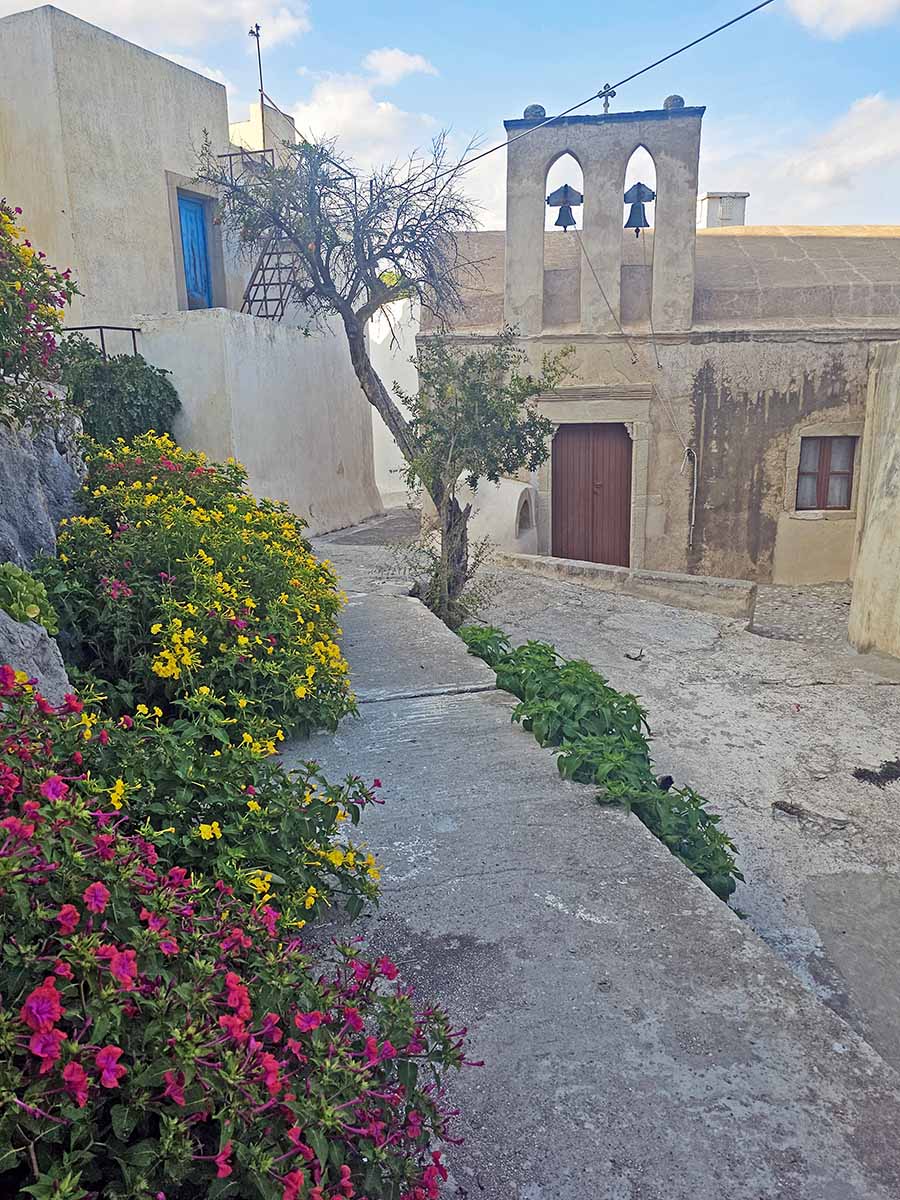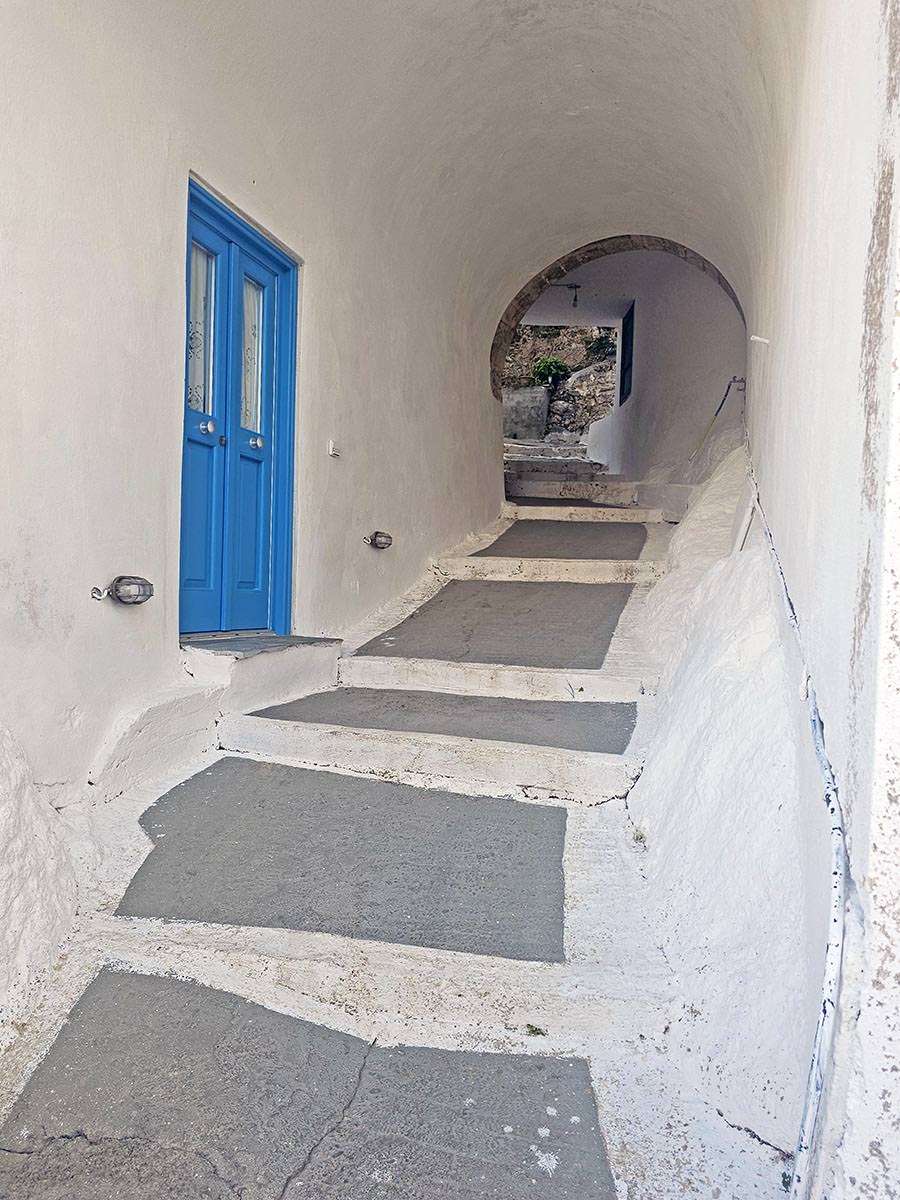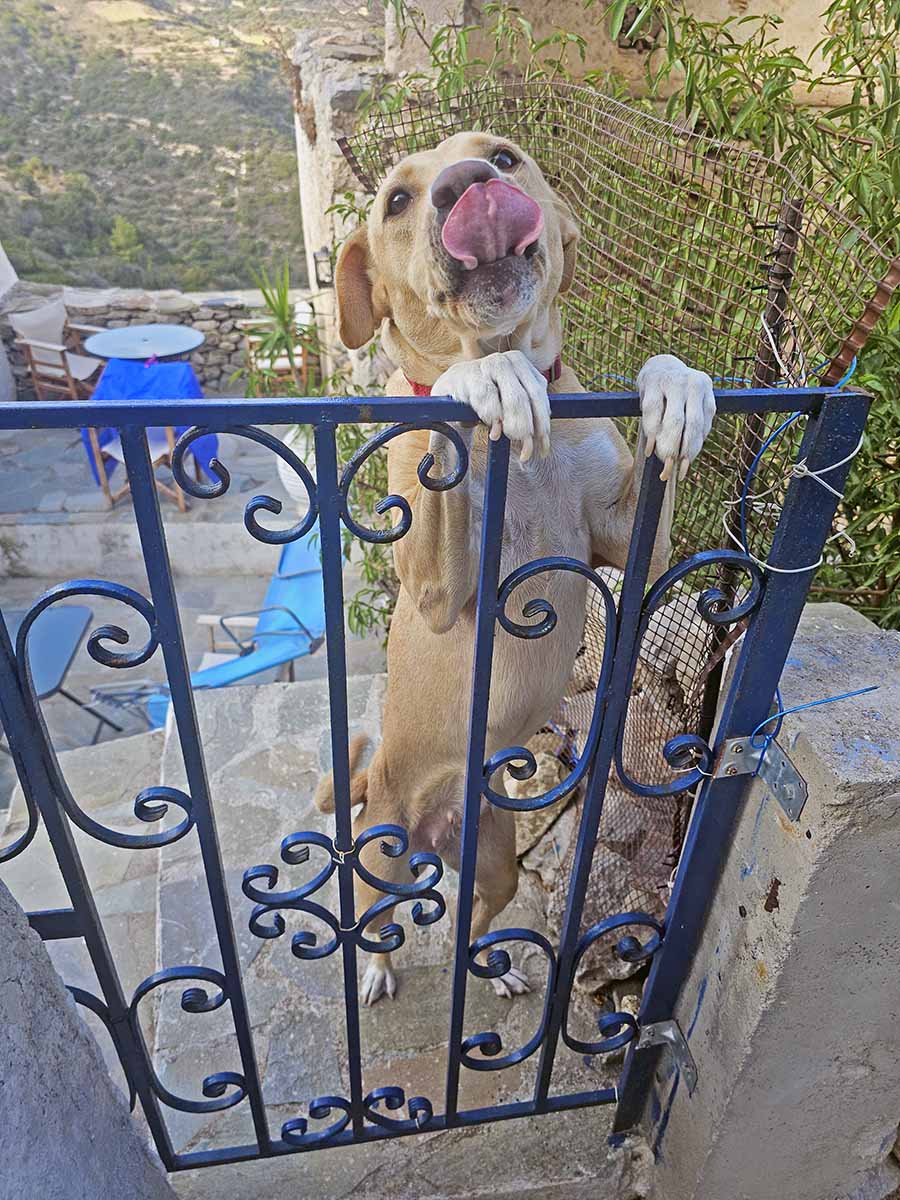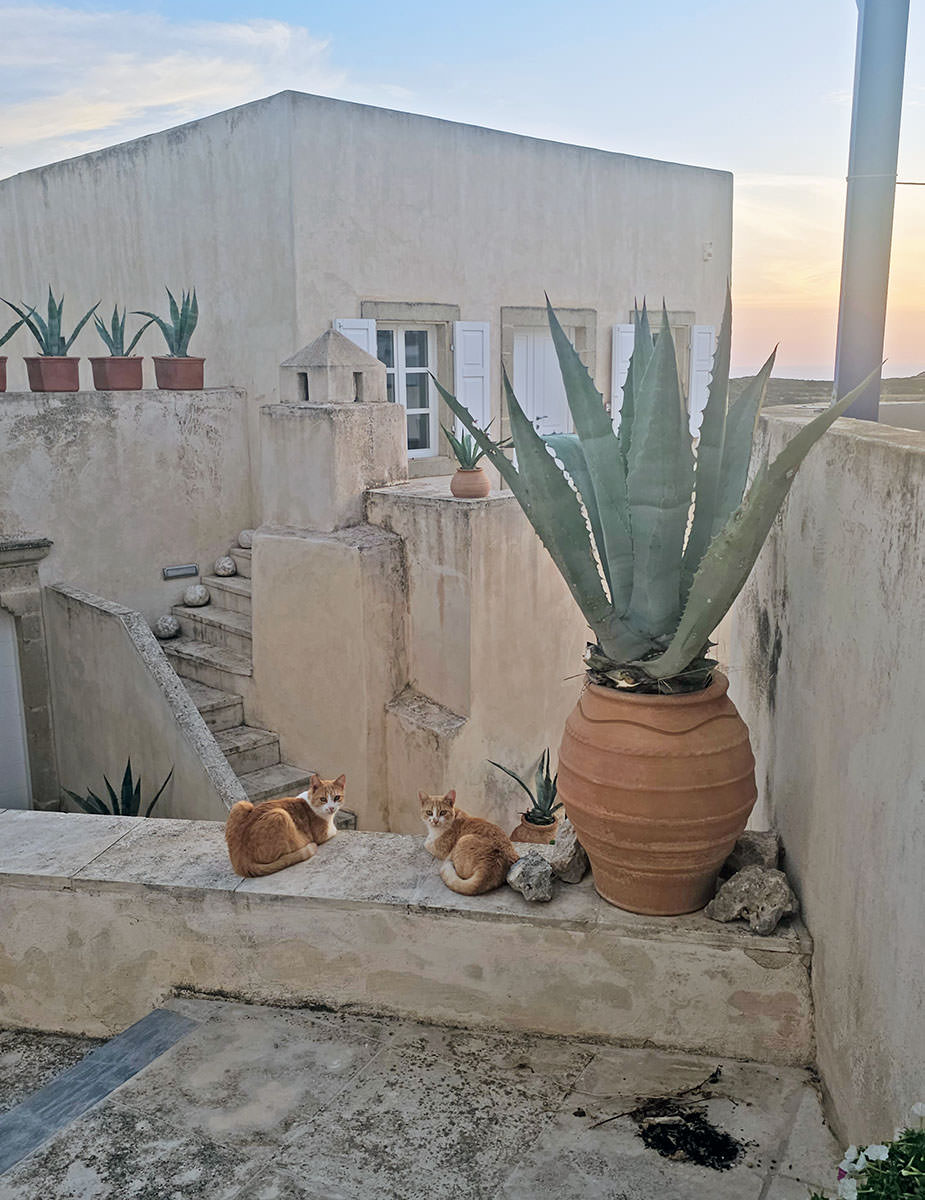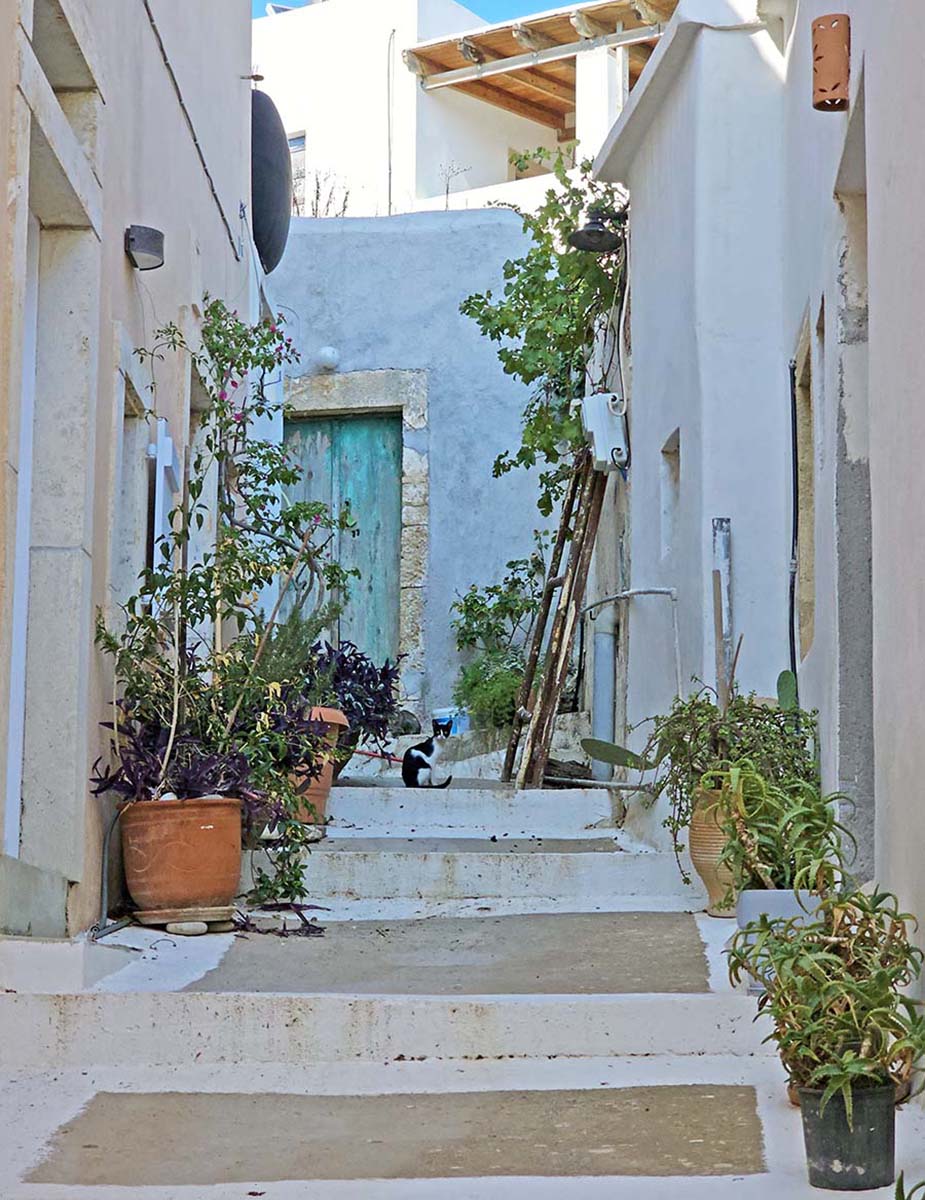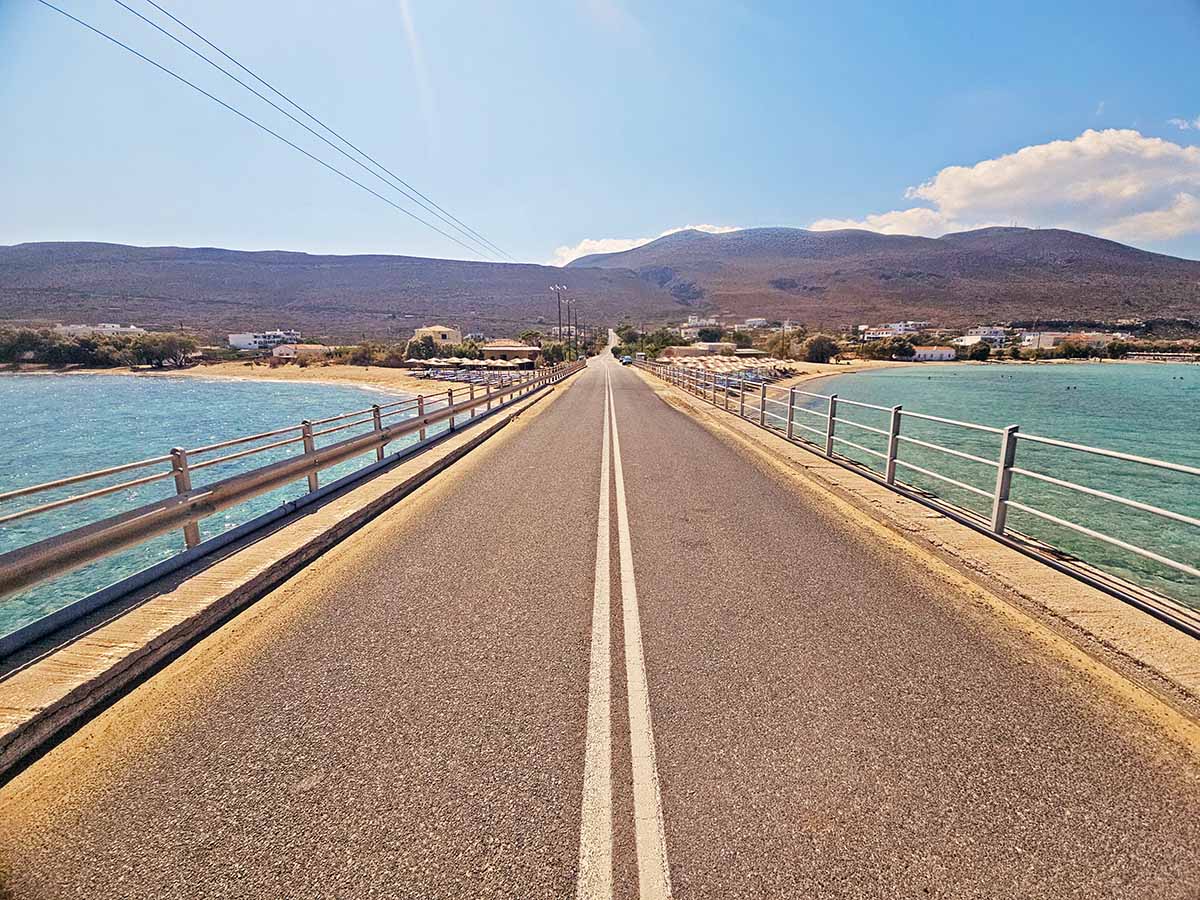Between the Peloponnese and Crete lies Kythira, one of Greece‘s lesser-known islands. Still, when summer tourists from the big cities, chasing the promise of an authentic Greek escape, pour into the depopulated Kythira, the heart of the island starts to beat faster. Legends come alive, and the idea that making love here can be a path to passion discovery turns solid. After all, Kythira is said to be the birthplace of Aphrodite, goddess of love, whose myth rolls within the foamy waves splashing against the island’s shores.
From Homer and Herodotus to Jean-Antoine Watteau and Charles Baudelaire, both Kythira and her celestial goddess acted as muses
Even Kythira’s name holds a secret. It comes from the Greek word keutho (κεύθω), meaning “to hide”, referring to the love concealed in one’s stomach, much like butterflies. Also spelled Kithira, Kythera, or Cythera, the island’s name invokes Kythereia, Cytherea, or Cytheria, all versions of literary epithets for Aphrodite, the ancient goddess of pleasure and procreation.
From Homer (who in in “The Iliad”, Book 14, called Aphrodite the Lady of Cythera) and Herodotus (who in Book 1 noted that Phoenicians built her first temple here) to Jean-Antoine Watteau (French Rococo painter who used a soft color palette to depict lovers in “The Embarkation for Cythera” and “Pilgrimage to Cythera”) and Charles Baudelaire (who in “Voyage to Cythera” recast the island of erotic pleasure as one of suffering and death), both Kythira and her celestial goddess acted as muses.
Even in the digital afterlife, an arid Greek island off the coast of Laconia, the Spartan homeland, appears as Kythera in the ‘Assassin’s Creed Odyssey’ video game. Its main settlement is dedicated to Aphrodite, the island has a lair of Cyclopes and Krokottas Hyenas, and one quest lets you flirt and smooch with the cultist Diona.
In today’s overview of Kythira Island, learn what to see, what to do, and where to stay when visiting this special Greek island of hidden love, where beauty meets desire!
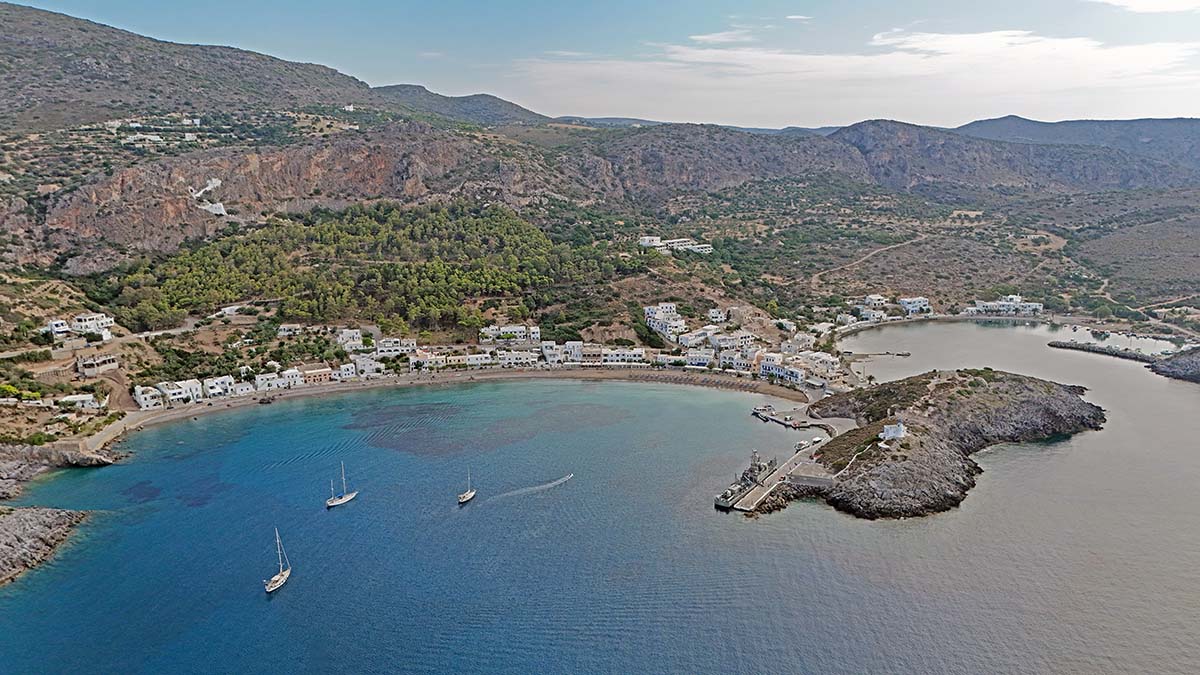
Kythira Travel Guide
Where is the island of Kythira situated in Greece?
Kythira lies just off the southeastern coast of the Peloponnesian Peninsula, where the Aegean, Ionian, and Cretan seas meet, at the entrance of the Laconian Gulf.
Geographically lonely, Kythira is officially counted among the seven main Ionian islands (alongside Corfu, Zakynthos, Kefalonia, and others), thanks to deep historical and cultural ties.
Far from the rest of the Ionian chain, Kythira Island’s location between mainland Greece and Crete has made it a crossroads of cultures for centuries. Aegean traders, Venetian nobles, and British administrators all left their marks here. Even today, it feels like a bridge between worlds.
How big is Kythira Island?
Kythira Island’s size is roughly 280 square kilometers (108 square miles). Some 29 kilometers long and 18 kilometers wide, this is a medium-sized Greek island. It is large enough to spend days exploring 90 kilometers of its coastline, forgotten villages, and castles, yet small enough to still feel intimate and unspoiled.
Based on the most recent census data (2021), Kythira Island’s population consists of 3.644 permanent residents living here year-round, scattered across a patchwork of small villages and coastal settlements. In summer, the numbers swell, with visitors and returning Kytherians from abroad, but the island never tips into chaos. It keeps its quiet, unhurried charm, even in the sunniest months.
Especially thanks to the 20th-century emigration, the Kytherian diaspora is strong in Germany, the United States, and Australia, where organizations such as the Kytherian Brotherhood in Sydney, founded in 1922 (today known as the Kytherian Association of Australia), became a vital thread of connection among Greek expats.
Kythira Mythology
Kythira’s story begins in the sea. Ancient poets believed this was the island where Aphrodite, goddess of love and beauty, first rose from the foam of the waves. Some say it happened on the sands of Paleopolis, others swear it was in the sheltered bay of Avlemonas. Wherever the truth lies, the myth gave Kythira an aura of sacredness.
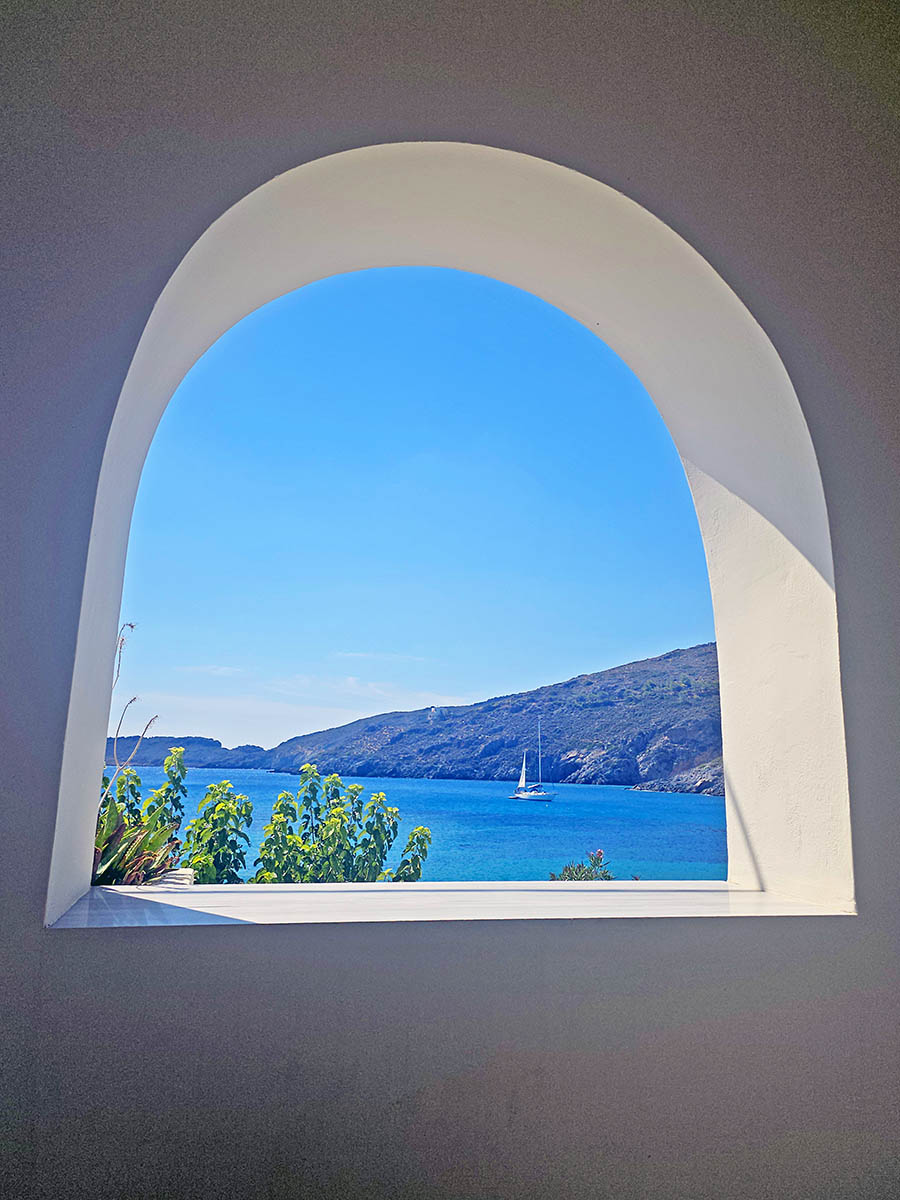 Hesiod, a poet active in the 7th century BC, was the first to record the tale of Aphrodite’s appearance. In “Theogony”, a poem tracing the origins of the gods, Hesiod wrote how Kronos seized and castrated his father Uranus. The Sky God’s severed genitals fell into the sea near Kythira, and from the churning foam (aphros, in Greek) emerged Aphrodite herself. The currents then carried her to Paphos, Cyprus, where her cult would later flourish.
Hesiod, a poet active in the 7th century BC, was the first to record the tale of Aphrodite’s appearance. In “Theogony”, a poem tracing the origins of the gods, Hesiod wrote how Kronos seized and castrated his father Uranus. The Sky God’s severed genitals fell into the sea near Kythira, and from the churning foam (aphros, in Greek) emerged Aphrodite herself. The currents then carried her to Paphos, Cyprus, where her cult would later flourish.
However, the very first temple dedicated to Heavenly Aphrodite (Sanctuary of Aphrodite Ourania) was said to have been built on Kythira, near Palicastro, in the 6th century BC. Inside stood a wooden statue of the goddess, armed and resolute. Pilgrims came from across the seas, bearing gifts and prayers for passion, fertility, and safe journeys.
Over time, Kythira became a symbol of love itself, a liminal place where sea and land, myth and reality, touched.
From that meeting point grew something extraordinary – an endemic flower that “never dies”. On the island’s wind-battered cliffs thrives the Sempreviva (Helichrysum italicum), a Kythira flower that remains bright yellow for years after being picked, without requiring water. This amaranth flower is mentioned even in the myth of Paris and Helen. When they stopped on Kythira (naturally, to make love), Helen, who was jealous of Aphrodite’s beauty, sought reassurance, so Paris compared her to the vivid flower, saying that her beauty would also live forever.
Kythira Island’s history
Beyond myth, Kythira’s strategic position at the crossroads of three seas made it a prize island coveted, conquered, and continually reshaped by many civilizations.
Ancient Times
Archaeological finds reveal traces of Minoan traders, Mycenaean settlers, and later Greek city-states like Sparta and Athens. Temples dedicated to Aphrodite drew worshippers from far and wide.
Byzantine Era
As Christianity spread, the island of Kythira transformed into a religious stronghold, dotted with chapels and monasteries, some of which still stand.
Venetian Rule (1207–1797)
Perhaps the most influential period, shaping Kythira’s fortresses, churches, and even cuisine. The Venetian castle of Chora, perched dramatically above the sea, still dominates the skyline.
Ottoman and British Periods
The island changed hands between the French and the Ottomans before falling under British administration in the early 19th century, leaving behind bridges, schools, and a peculiar fondness for orderly stonework.
Modern Greece
In 1864, Kythira was formally united with the modern Greek state, along with the other Ionian Islands.
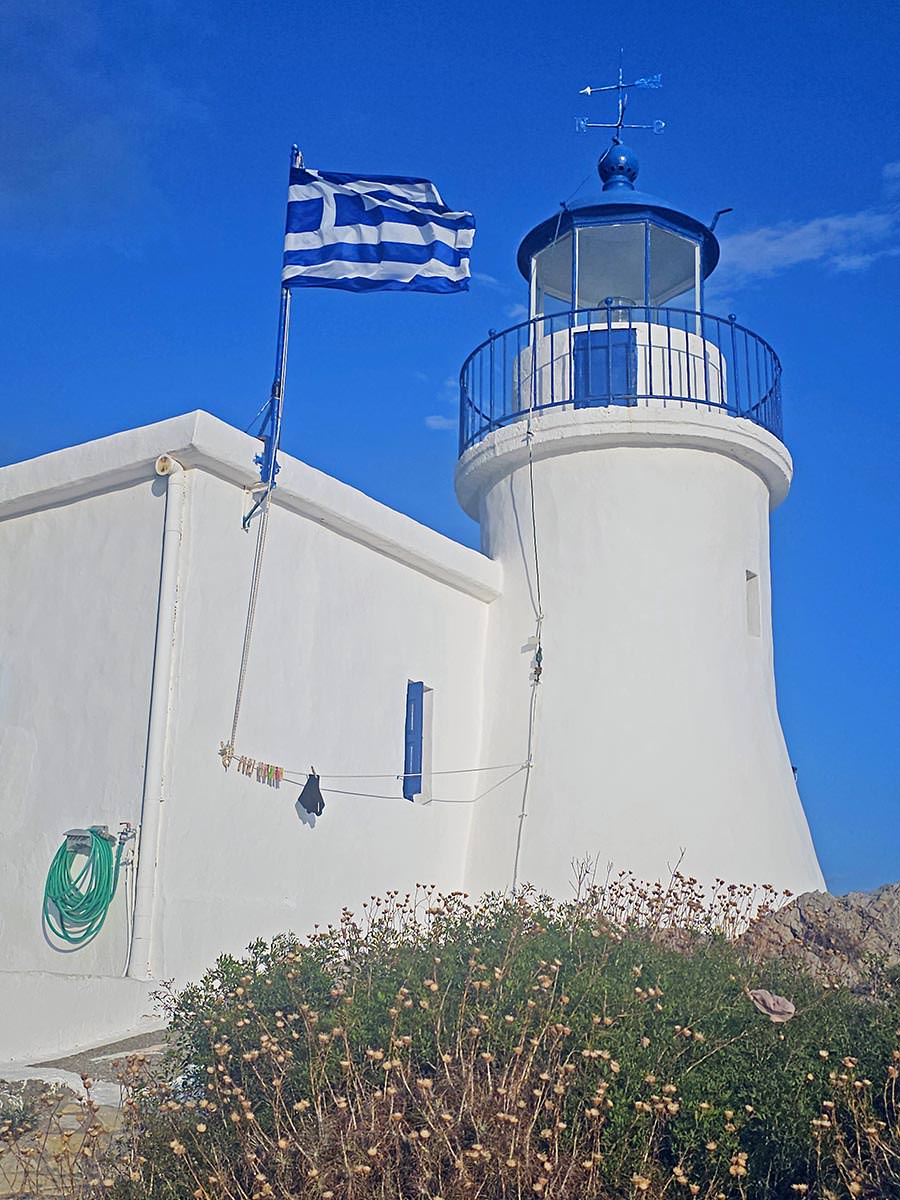
Today, the traces of this layered past are everywhere: Venetian fortresses rising from cliffs, Byzantine chapels painted with fading frescoes, abandoned watermills in green valleys, and quiet villages where Italian and Greek influences coexist.
Kythira Island – things to do
From remnants of ancient Greece to contemporary attractions, Kythira is a place that rewards curious travelers. Suitable for both sightseeing day trips as well as for longer, slow-paced holidays, plentiful mini destinations and activities are worth pinning on the map of Kythira Island.
Here are some of the best things to do in Kythira Island, Greece!
1. Rent a car at Kythira
If you’re asking yourself, “Do I really need a car in Kythira?” – the answer is short and definitive: YES.
Public transport on Kythira doesn’t exist. To explore this large and scattered island effectively, renting a vehicle is a must. For anyone planning to reach all those secluded beaches, remote scenic viewpoints, and charming villages off the beaten path, car hire is a crucial first step to do upon arrival at Kythira.
That’s exactly what I did. My ferry from Piraeus to Kythira docked at Diakofti Port, where a friendly staff member from Drakakis Rent a Car was already waiting. After a quick and efficient paperwork exchange, the keys to the Seat Ibiza were in my hand, and my Kythira adventure could begin.
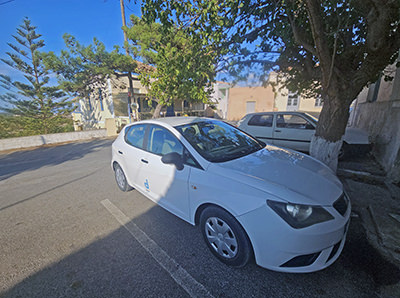
If you’re looking for a reliable car rental in Kythira, I can honestly recommend Drakakis. They have the largest range of car categories, competitive prices, as well as one of the newest and best-maintained fleets on the island.
My medium-sized car was perfect for navigating the island’s narrow, occasionally dramatic roads. But if your needs differ, you can go for something economical like a Citroën C1, or something bolder, like an SUV, 4WD, or even a 9-seat minivan for group trips.
Unless you plan to spend your entire stay in one village, renting a car or at least a scooter is absolutely essential on Kythira (well, as long as you haven’t brought your own vehicle, of course). Kythira Island has no buses, exploring it on foot would test even the greatest walkers, so trust me when I say that a voyage to Kythira is not the same without the luxury of a car.
Conveniently, Drakakis delivers its cars to the exit of Kythira Airport (Alexander Aristotelous Onassis Airport), too, so even flyers to the island can start driving just meters away from baggage claim.
If you plan to explore the rest of Greece, it is good to know that this is the only Kythira car rental company that allows you to return the car on the mainland.
Check out Drakakis’ car rental options here.
2. Visit Kythira Island beaches
Kythira’s coastline is as diverse as its myths: rocky coves with turquoise waters, long sandy arcs framed by cliffs, and quiet bays where time forgets to move. Each beach has its own personality, and if you listen closely, some still whisper Aphrodite’s name.
Now that your car keys are in hand, it’s time to chase the shoreline. Here are some of my favorite Kythira Island beaches!
Textile beaches of Kythira
Avlemonas Beach
Avlemonas isn’t a beach in the classic sense – it’s more of a natural swimming stage built right into the village. The sea forms small turquoise coves at the feet of whitewashed houses, with stone steps and ladders leading straight into the water. It feels like swimming inside a giant saltwater pool.
Local stories link Avlemonas to the myth of Aphrodite’s birth, with some saying the goddess first stepped ashore here, fresh from the foam. When the sun sets, and the sea glows in shades of gold and pink, it’s easy to believe the divine history of the beach.
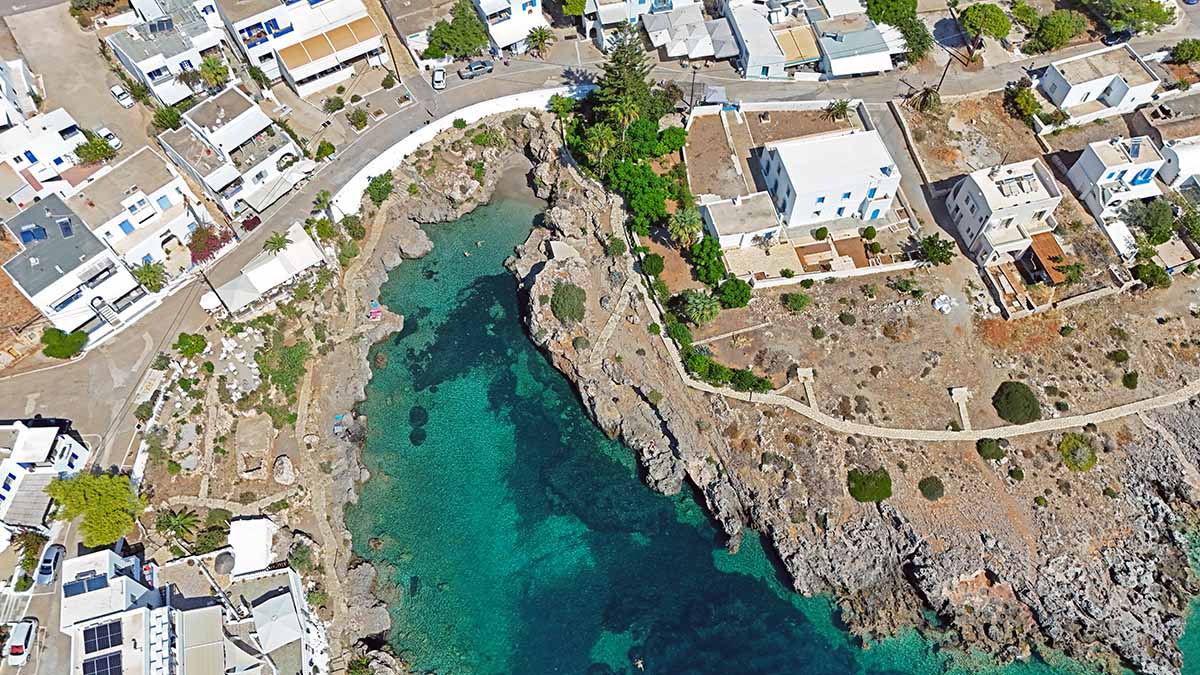
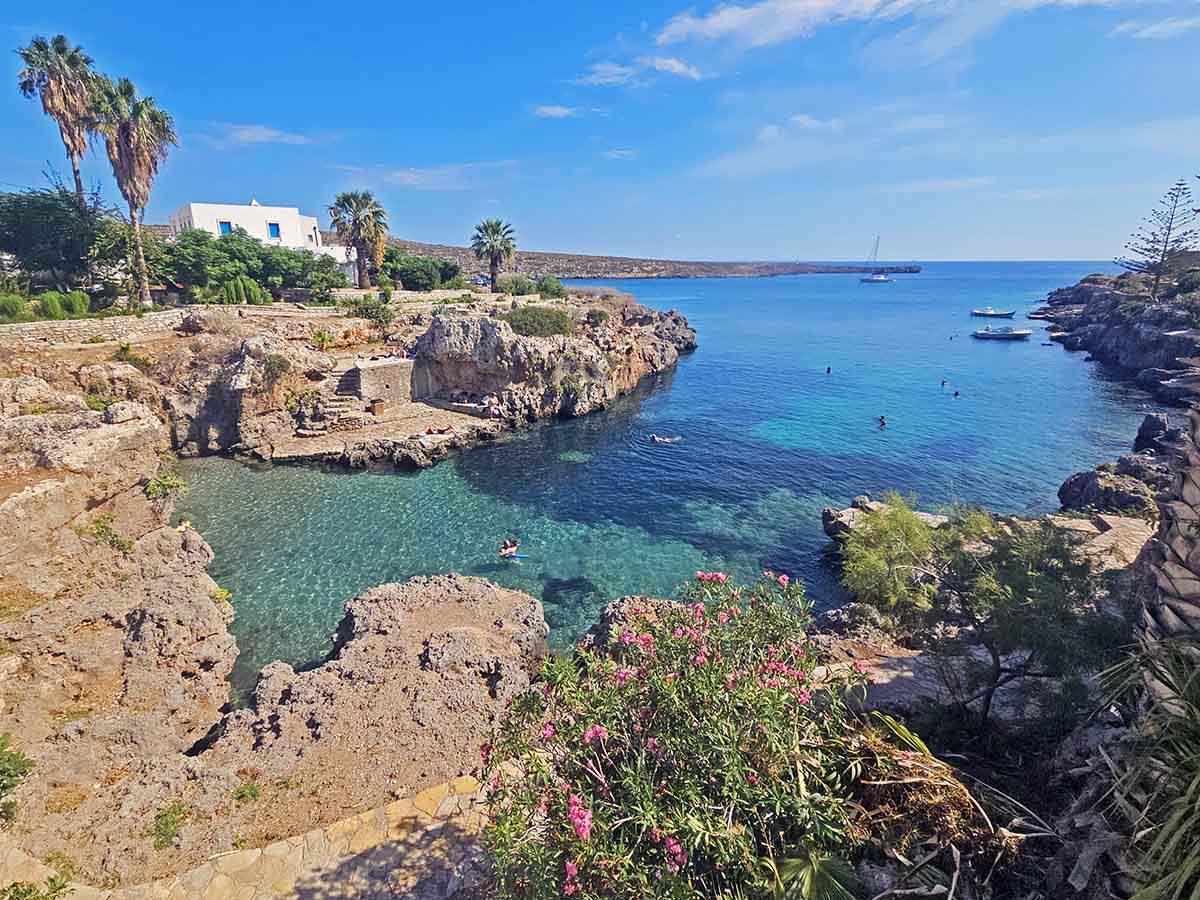
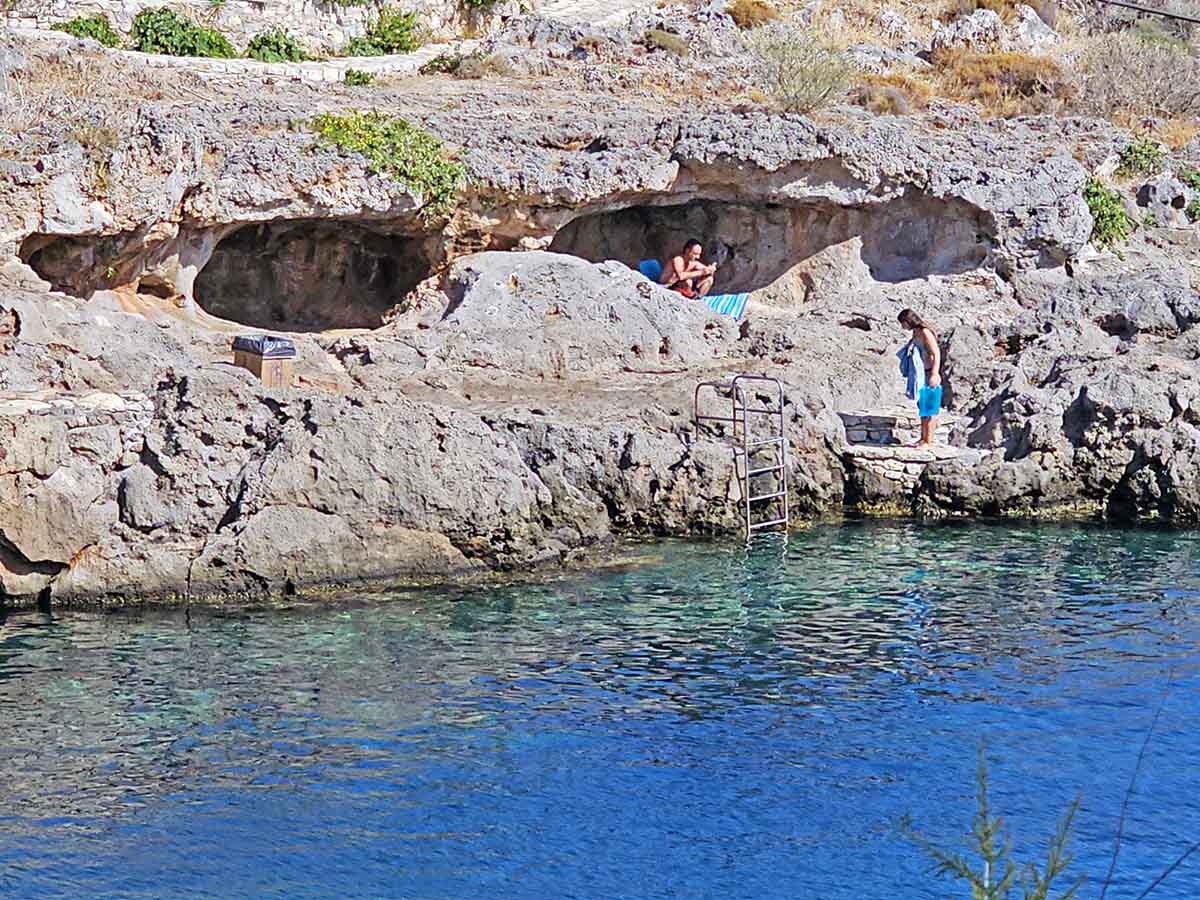
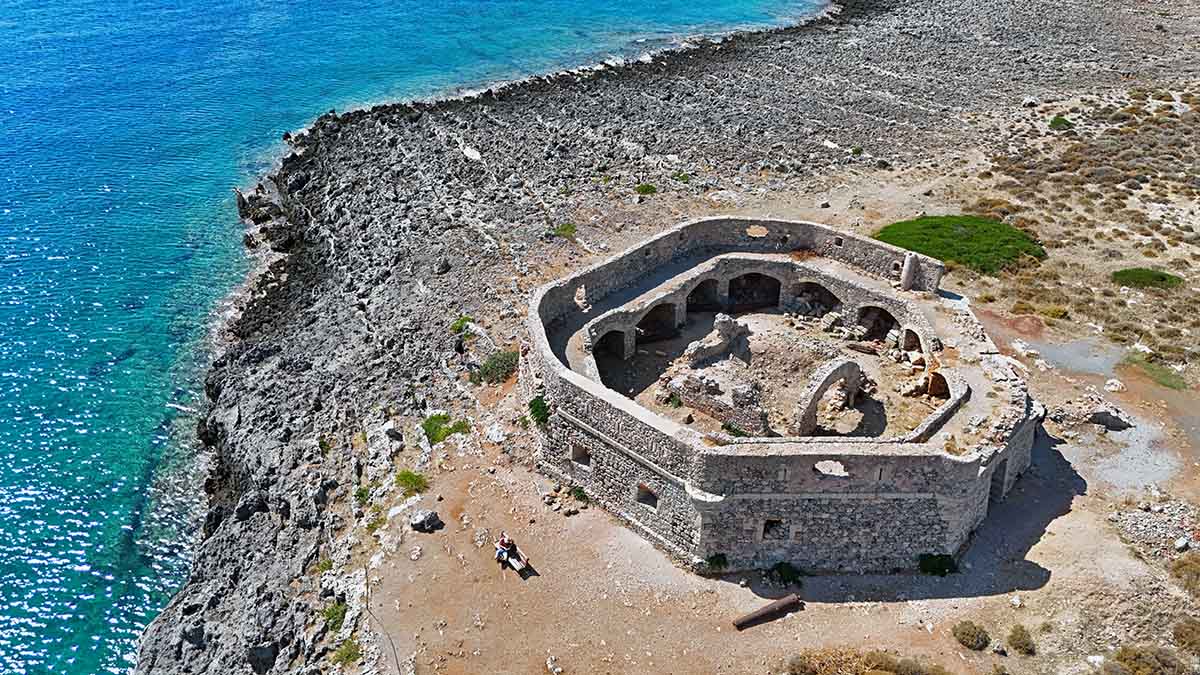
Since 1565, the back-then main port of Kythira was protected from pirate raids by a Castello. The Castle of Avlemonas is a small octagonal Venetian fortress you can still explore today – just enter through a “back door”, a hole in the wall next to a rusted cannon.
With local tavernas and cafés just steps away, it’s easy to spend a whole afternoon swimming, eating, and soaking in the atmosphere of this postcard-perfect village. Photographs truly don’t do justice to Avlemonas’ beauty.
💡 Tip: Avlemonas is ideal for families, thanks to its shallow, calm waters and safe swimming spots. If you want more peace and space to spread out, head to Paleopolis Beach nearby (one of Kythira’s longest), where, also according to the myth, Aphrodite first set foot on land.
Kaladi Beach
On Kythira’s eastern coast, perhaps the island’s most photographed stretch, Kaladi is a trio of coves linked by dramatic rocks. Two larger pebble beaches sit beneath steep cliffs, separated by a massive split rock (natural rock arch), while the path to a third, smaller beach leads through a small cave.
The turquoise water here is so clear it feels like liquid glass. Paired with colorful marine life, it provides excellent conditions for snorkeling.
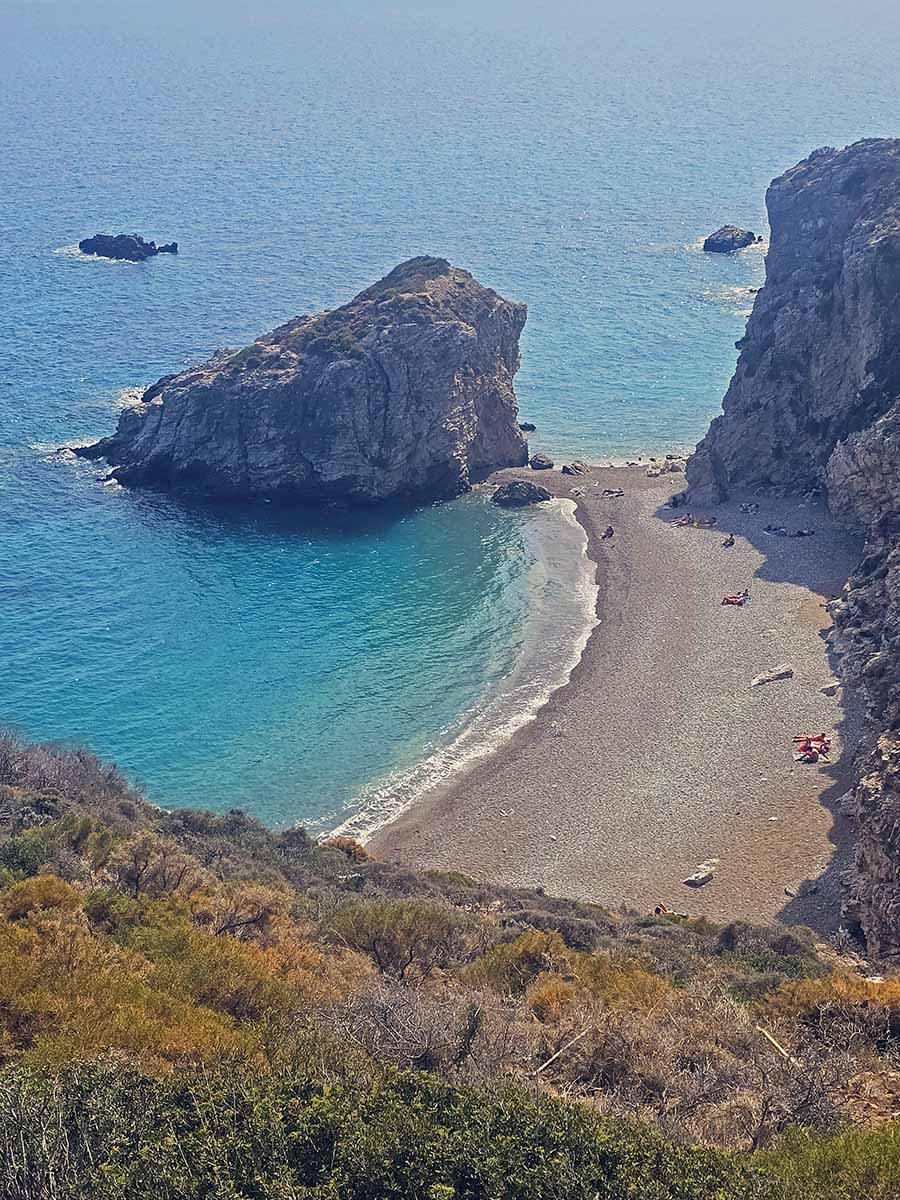
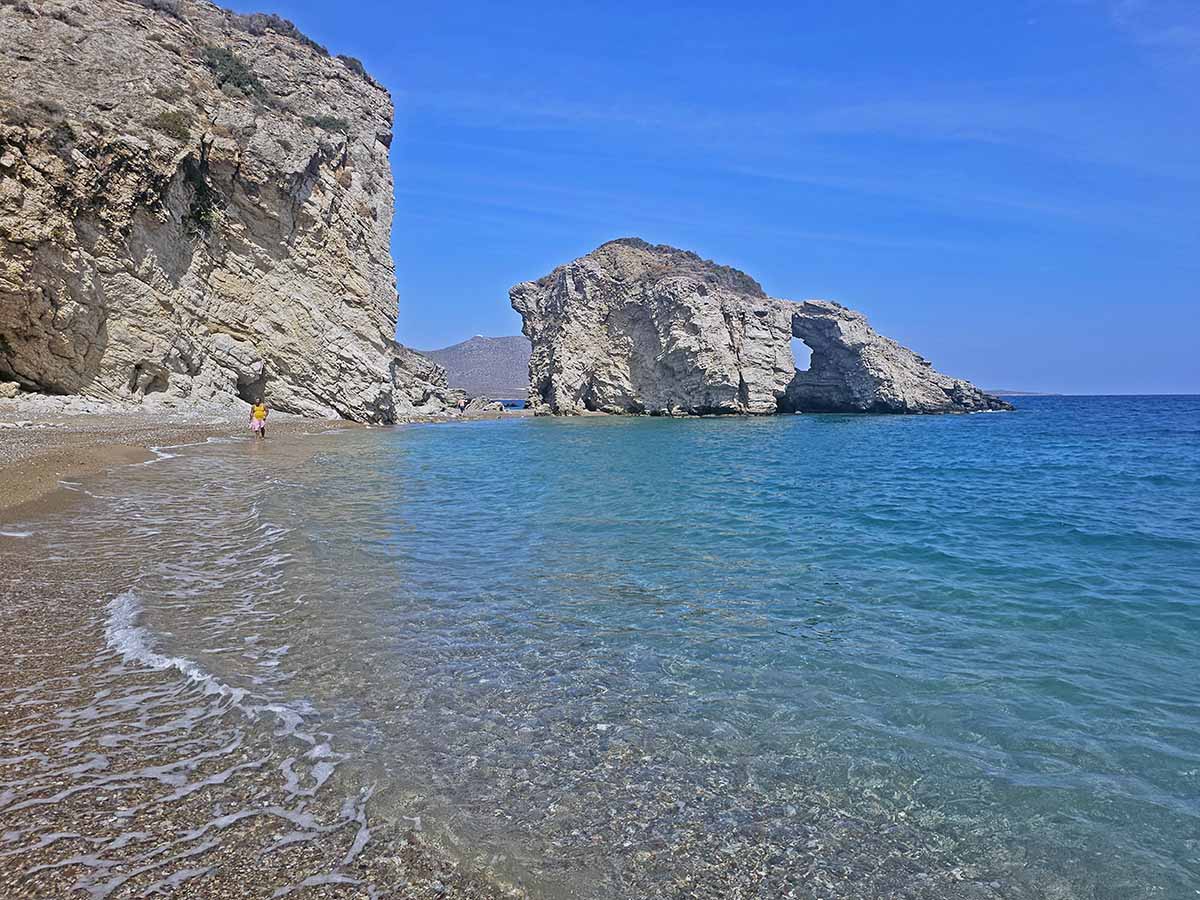
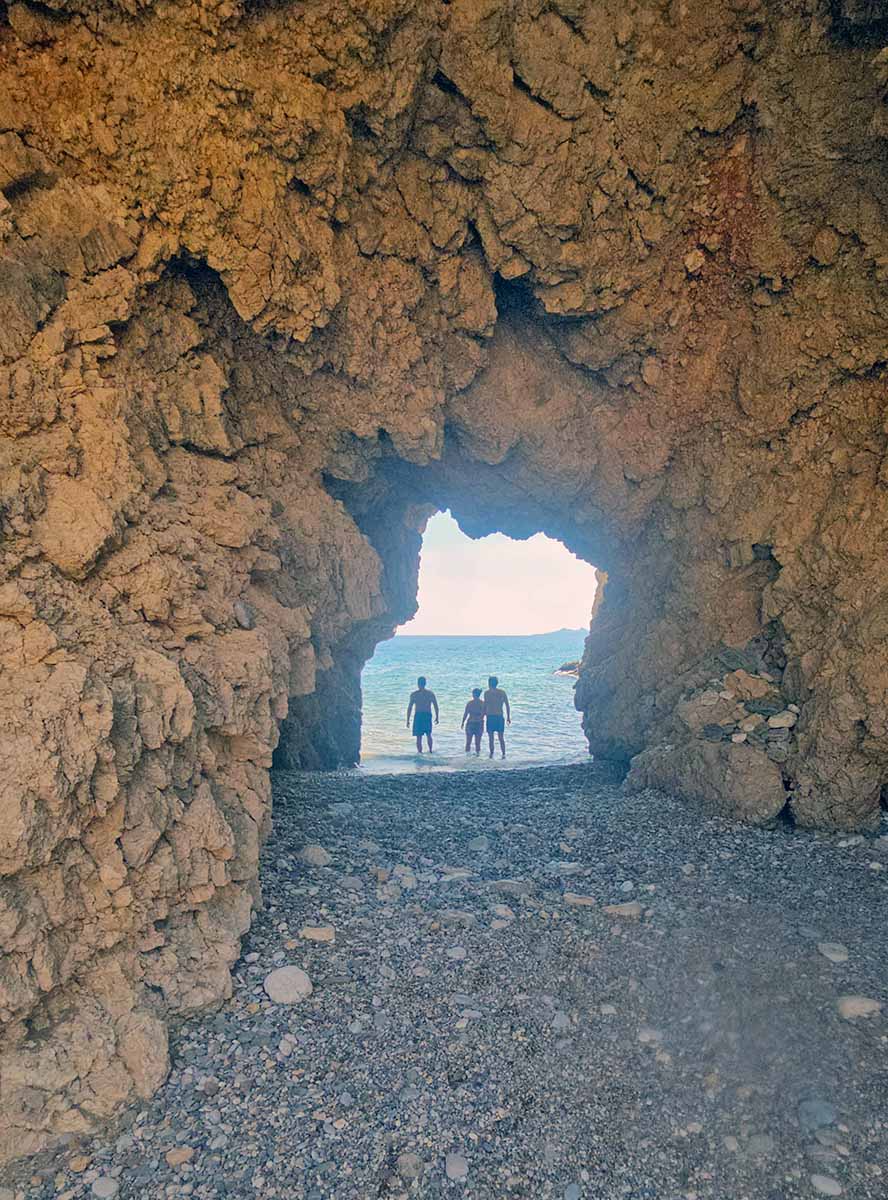
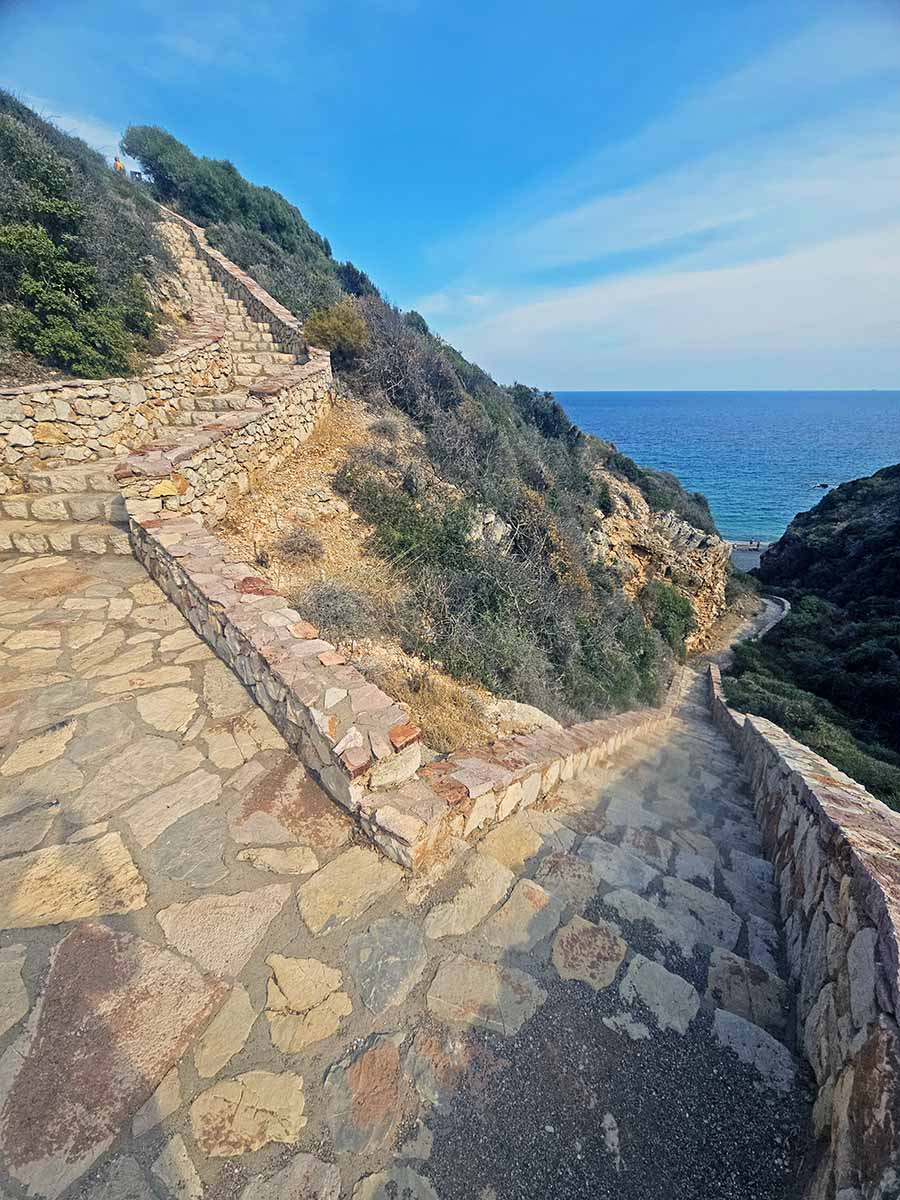
Access to this raw and rugged setting requires a bit of effort. You’ll park at the clifftop and walk down 162 stone steps. The isolation is part of Kaladi’s charm, keeping it from ever being crowded. It mainly attracts young travelers and adventurous swimmers.
💡 Tip: Bring solid shoes (even water shoes), drinking water, snacks, and shade – there are no facilities here. Visit early or late for soft light and solitude.
Diakofti Beach
If Kaladi is wild and dramatic, Diakofti is its sun-soaked opposite – a slice of the Caribbean dropped into Europe. It’s a broad stretch of fine white sand lapped by shallow, turquoise waters so clear they almost look unreal. Indeed, you don’t get to see this kind of beach near an island’s main port every day!
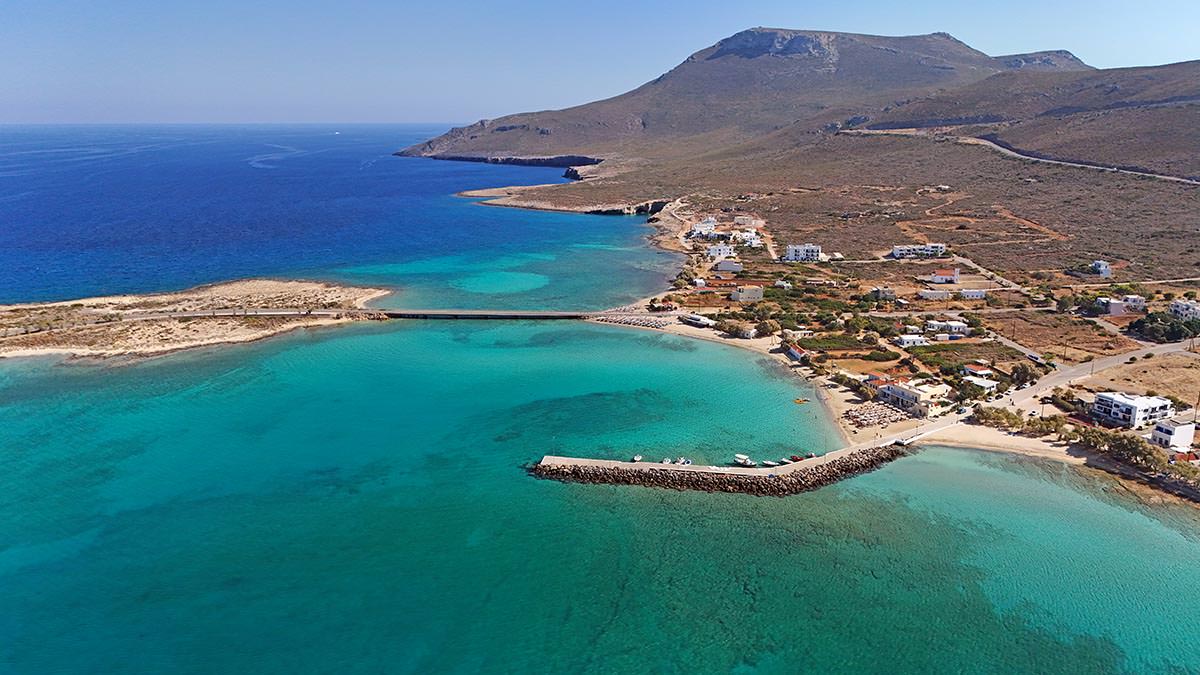
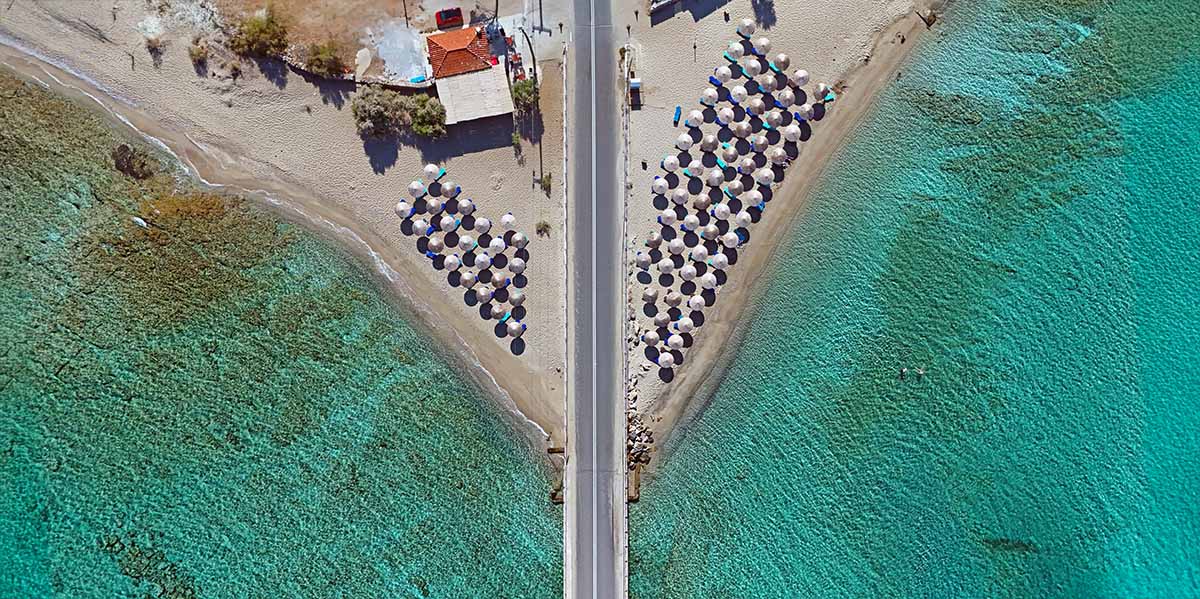
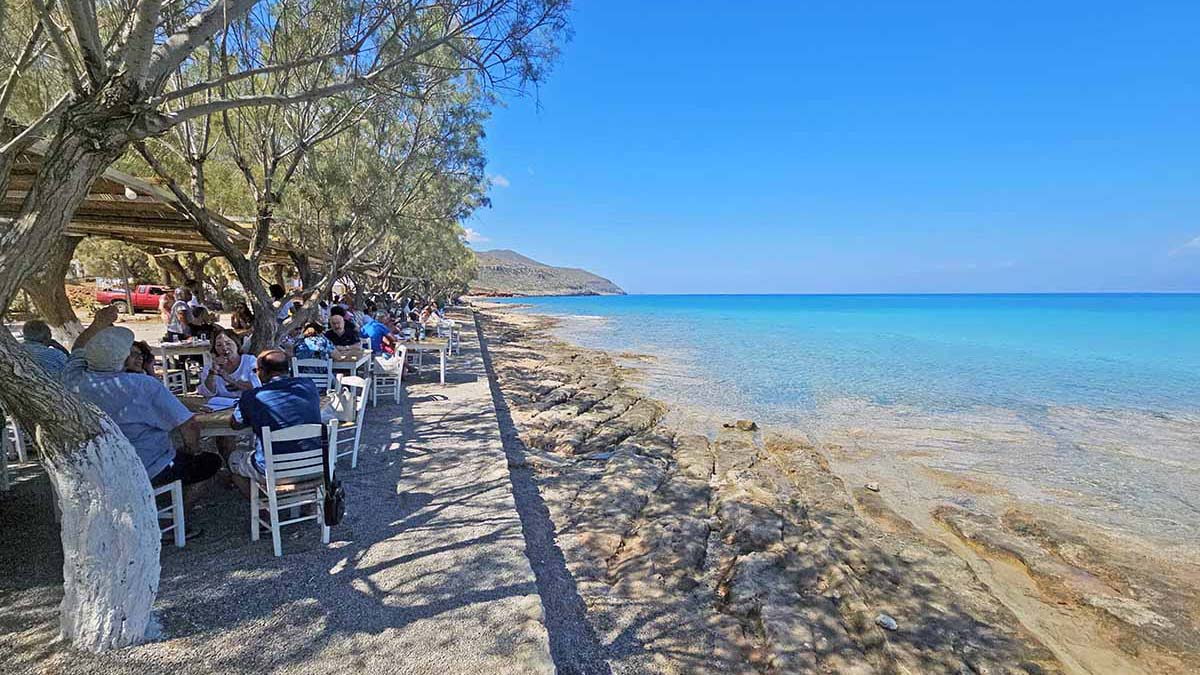
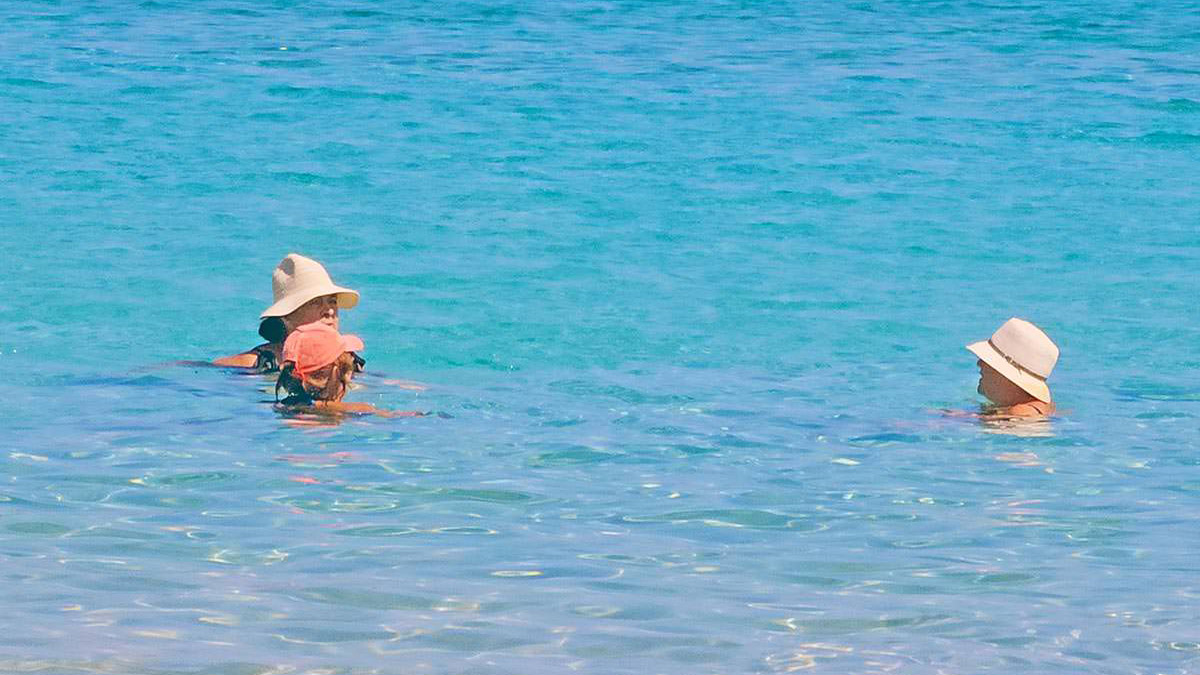
Families love it because the sea stays shallow for a long distance, making it safe for children and perfect for long, lazy swims.
Unlike Kythira’s more remote beaches, taverns and cafés line Diakofti Beach, serving cold beer and fresh calamari right where your towel ends. No need to pack supplies!
💡 Tip: Diakofti is particularly stunning on windless days, when the sea turns glassy and the intense colors look almost photoshopped.
Kapsali Bay
Just below Chora, the island’s capital, Kapsali Bay is where Kythira comes out to play. It is the island’s social heart – two lively crescent-shaped bays perfect for swimming, water sports, or simply lounging with a coffee in hand.
The views are spectacular. You can swim with the Venetian castle of Chora watching from above, or with a glimpse of Crete on the horizon, on a clear day.
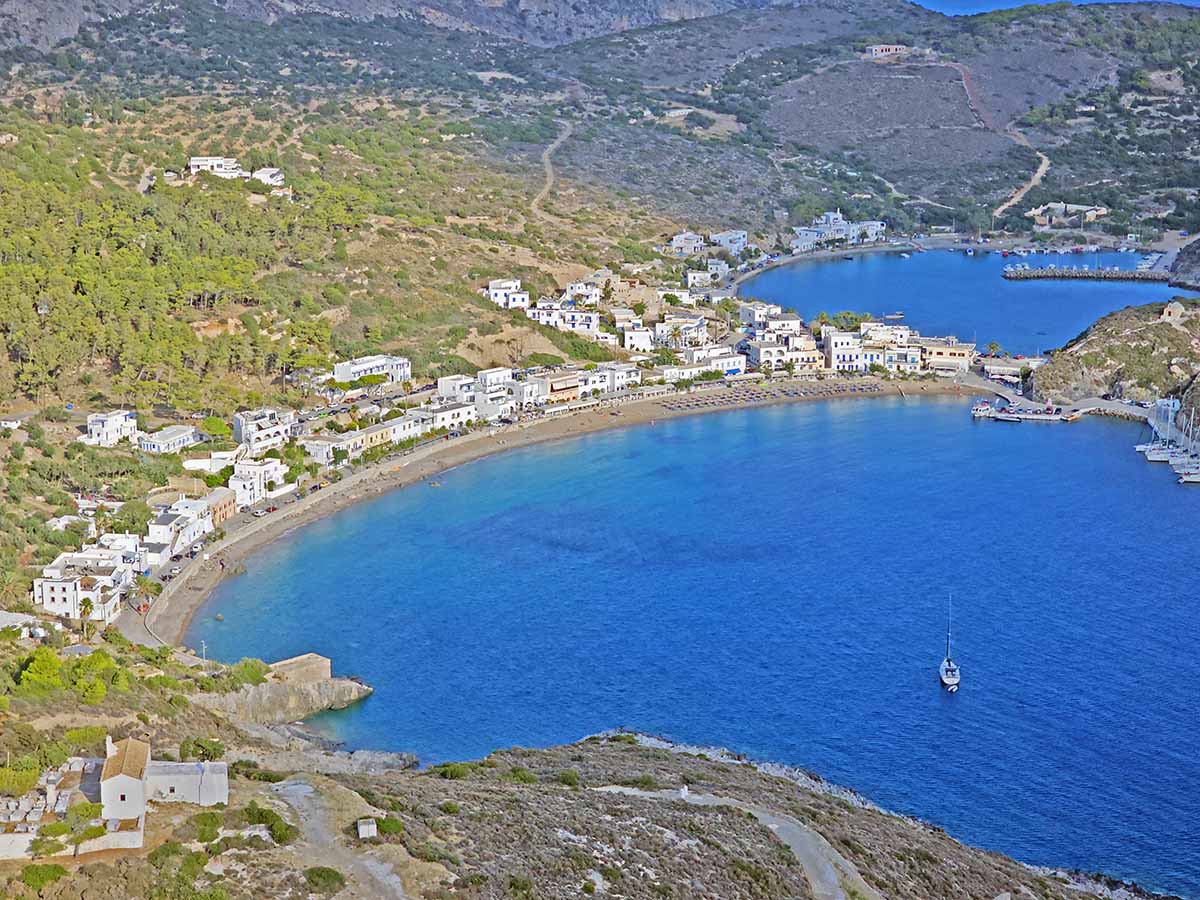
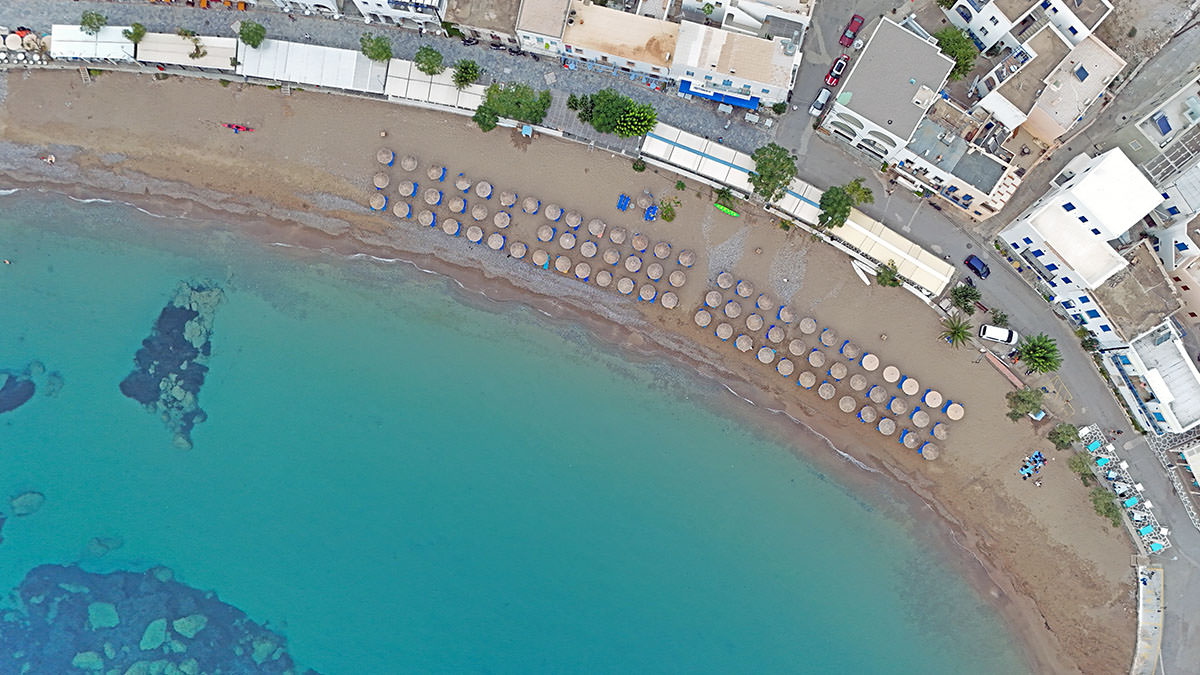
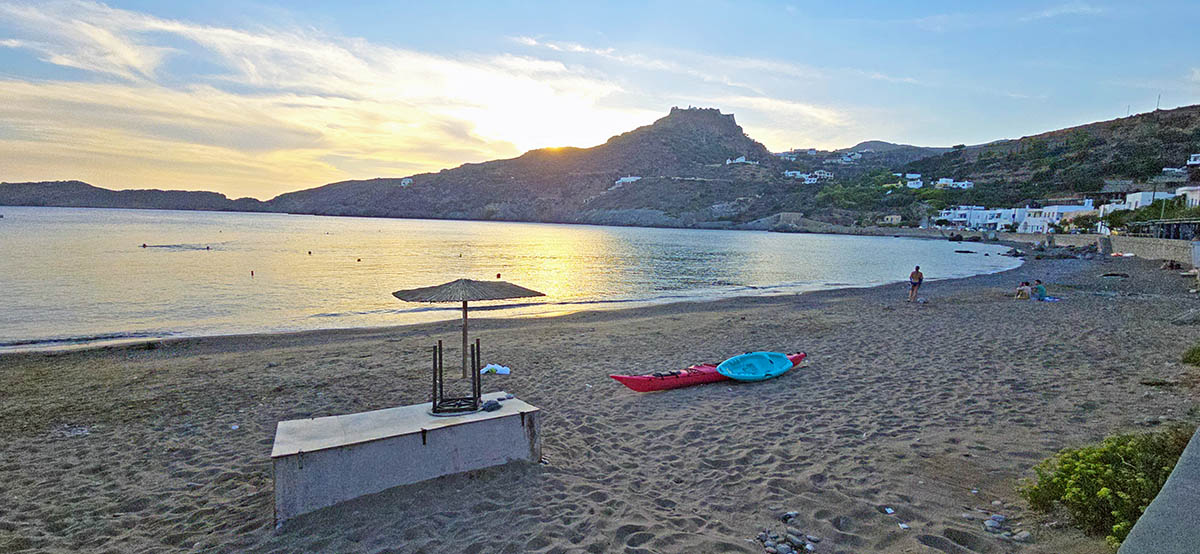
The first of the twin bays is more developed, lined with beach bars, cafés, and tavernas, where you can go straight from a swim to a plate of grilled octopus or a sunset cocktail. The second bay keeps a quieter tone. Both are great for swimming, thanks to their calm waters.
💡 Tip: If you’re staying in Chora, you can easily walk down to Kapsali in 15–20 minutes (though the uphill return is a bit of a climb). It’s the most convenient spot on the island if you want both swimming and nightlife without getting behind the wheel.
Agia Pelagia Beach
On the northern coast of Kythira, Agia Pelagia Beach is one of the island’s most organized and accessible stretches of shoreline.
The village of Agia Pelagia sits right along the waterfront, giving it a lively, holiday feel with laid-back tavernas, cafés, and small hotels just steps from the sea.
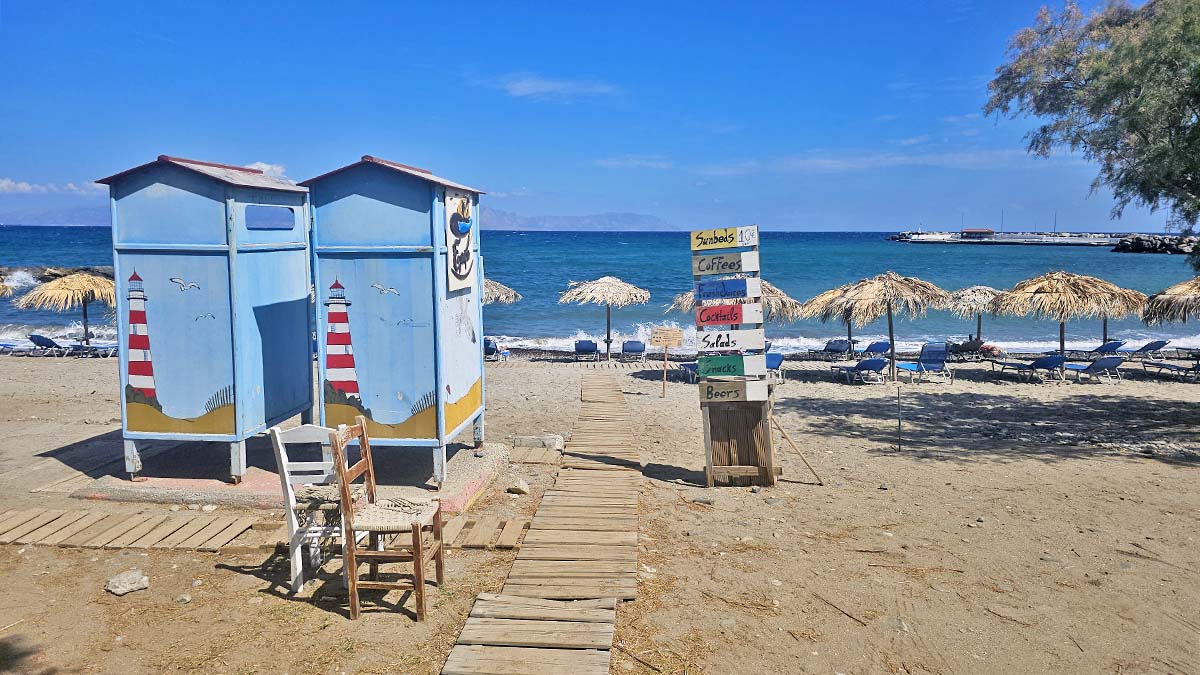
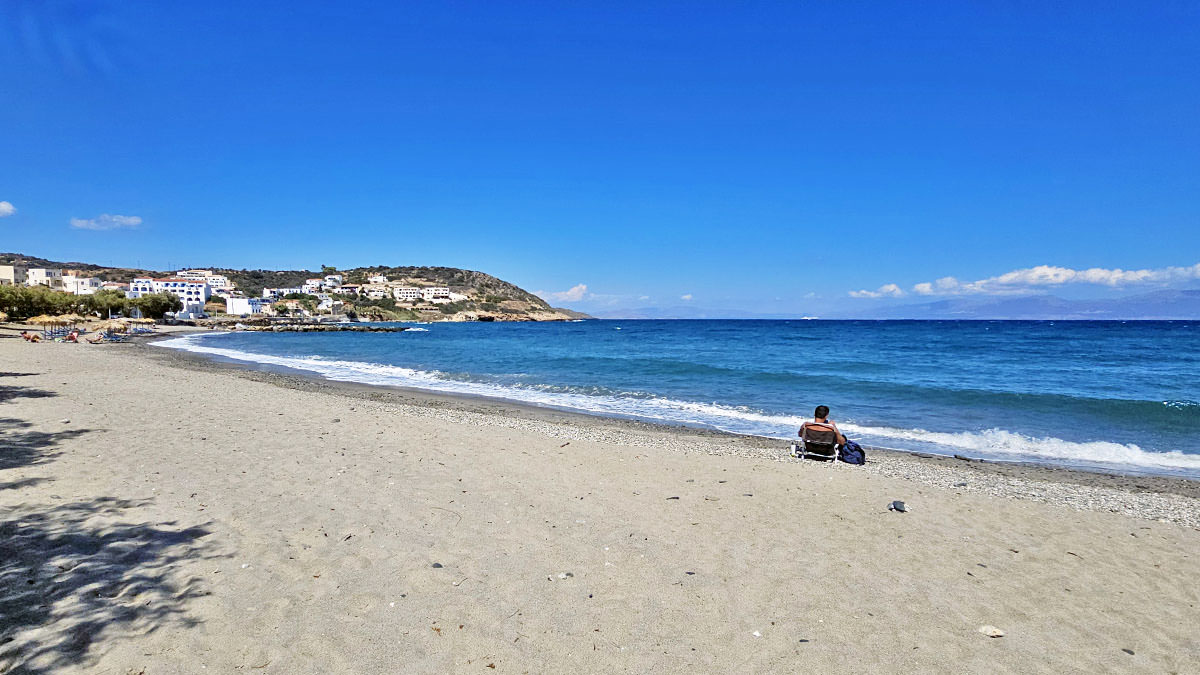
The beach itself is a mix of pebbles and sand, keeping the water crystal clear, ideal for those who prefer comfort over adventure.
Families love it for its convenience, while couples enjoy evening strolls along the promenade.
💡 Tip: Stay until evening – the bay glows beautifully as the sun dips behind the horizon. If you crave quiet and wilderness in northern Kythira, check out Platia Ammos Beach, just a short drive away in a northern direction. For an even more relaxed and easygoing atmosphere, drive southward, toward Lorenzo Beach, a true off-grid gem.
Nude beaches of Kythira
As Sandro Botticelli suggests with his iconic Renaissance painting “The Birth of Venus”, Aphrodite appeared on the land naked, only partially covered by her long hair. It feels appropriate that Kythira, the mythic birthplace of the goddess, has beaches where you can follow her lead – naturally.
While one can sometimes dodge the clothes even in Kaladi, Lorenzo, or remote stretches of Paleopolis, the safest FKK havens are these!
Sparagario
Tucked away just behind Kapsali Bay, Sparagario Beach is one of Kythira’s unofficial naturist-friendly spots. Its seclusion and lack of facilities make it attractive to those looking for freedom and privacy.
Surrounded by rugged cliffs and accessible only on foot or by kayak, the small cove feels far removed from Kythira Island’s busier beaches. The path from Kapsali is not the easiest one, but the effort of hiking pays off with a beach that feels wild and secluded.
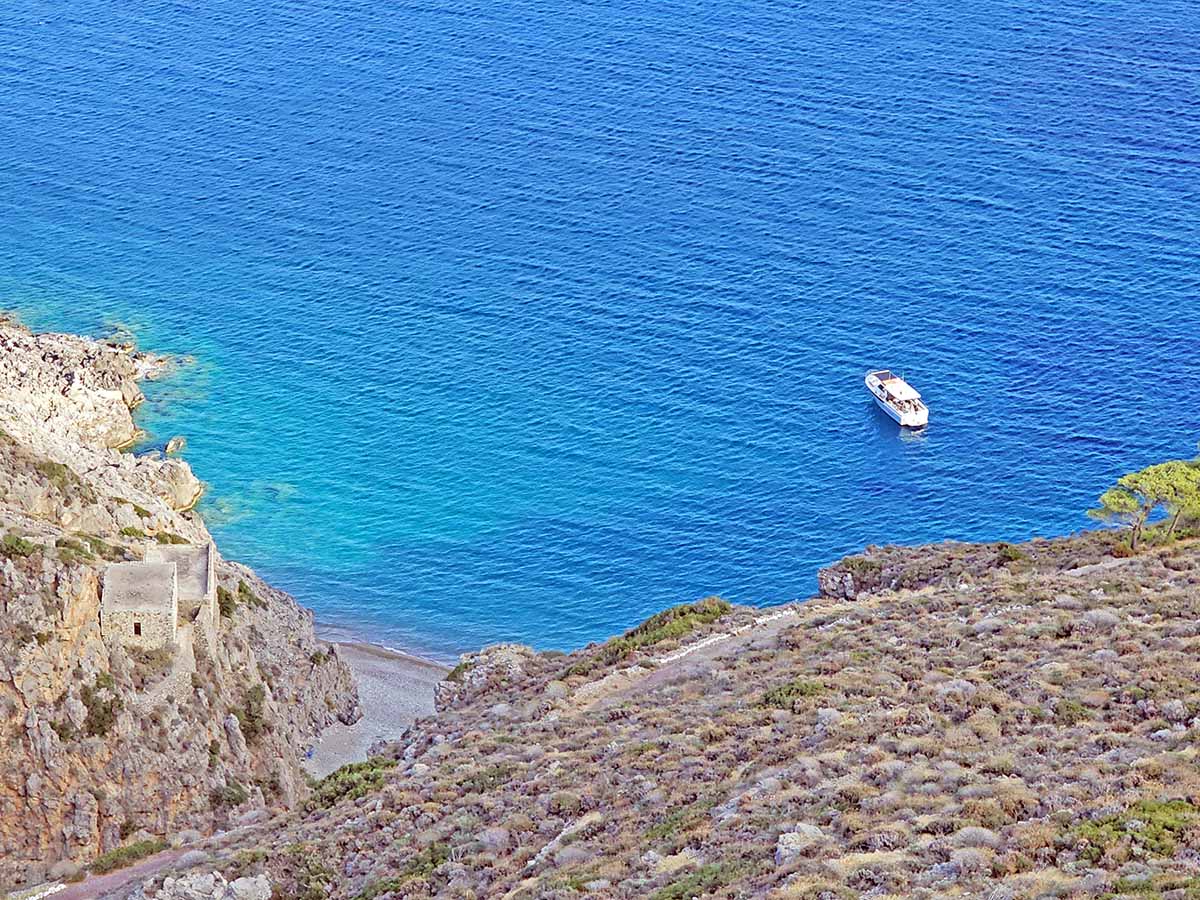
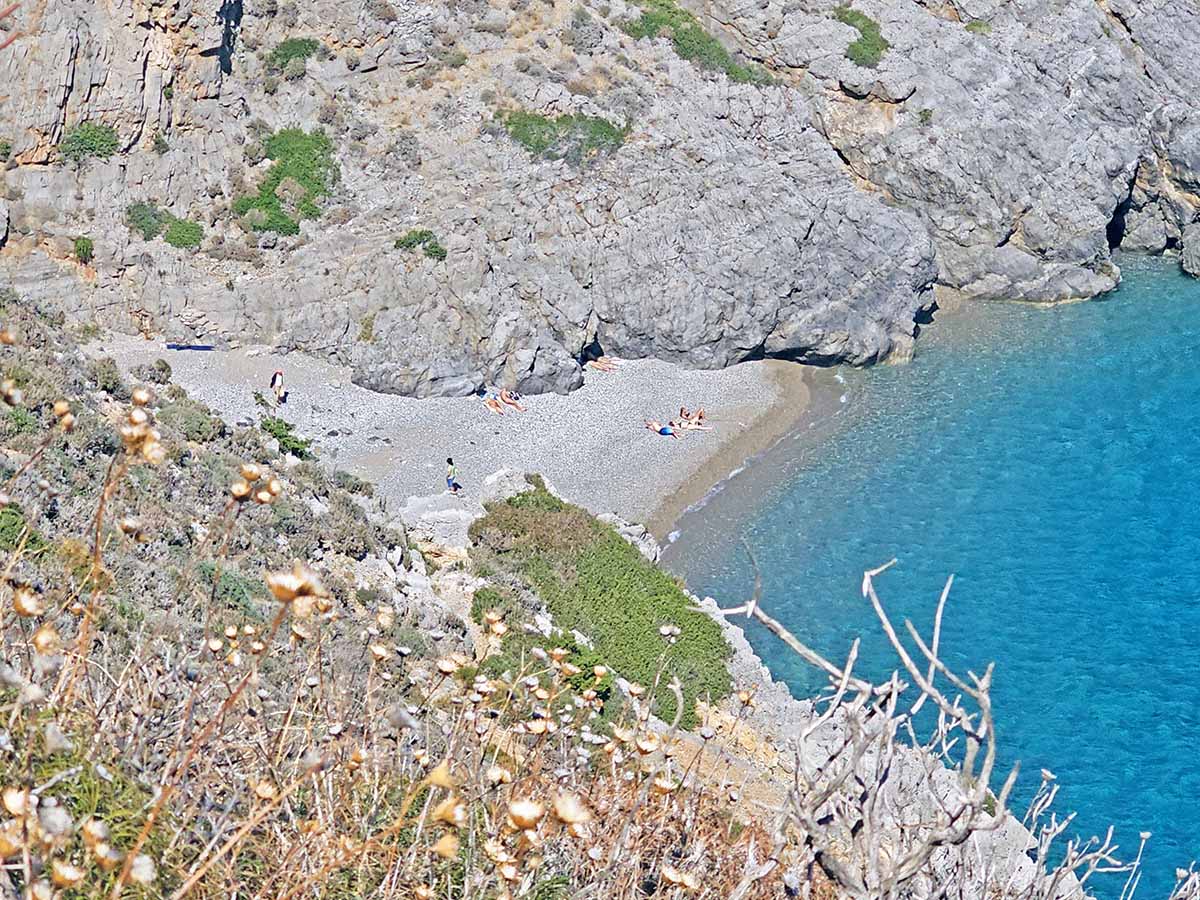
Sparagario’s setting is dramatic, but the vibe is relaxed and respectful. The beach is especially loved by those staying in Kapsali. After a morning coffee by the lively bay, you can paddle or walk over and escape into solitude within minutes.
💡 Tip: Bring water, shade, and sturdy shoes if hiking. The path is rocky, but the swim at the end feels heavenly.
Limni Beach
Quite large and spacious, Limni Beach on the eastern coast of Kythira provides plentiful shelter for naturists and those who prefer untouched beaches.
Its sand-and-pebble mix provides a perfect nesting ground for local turtles, so mind the marked egg-laying zones.
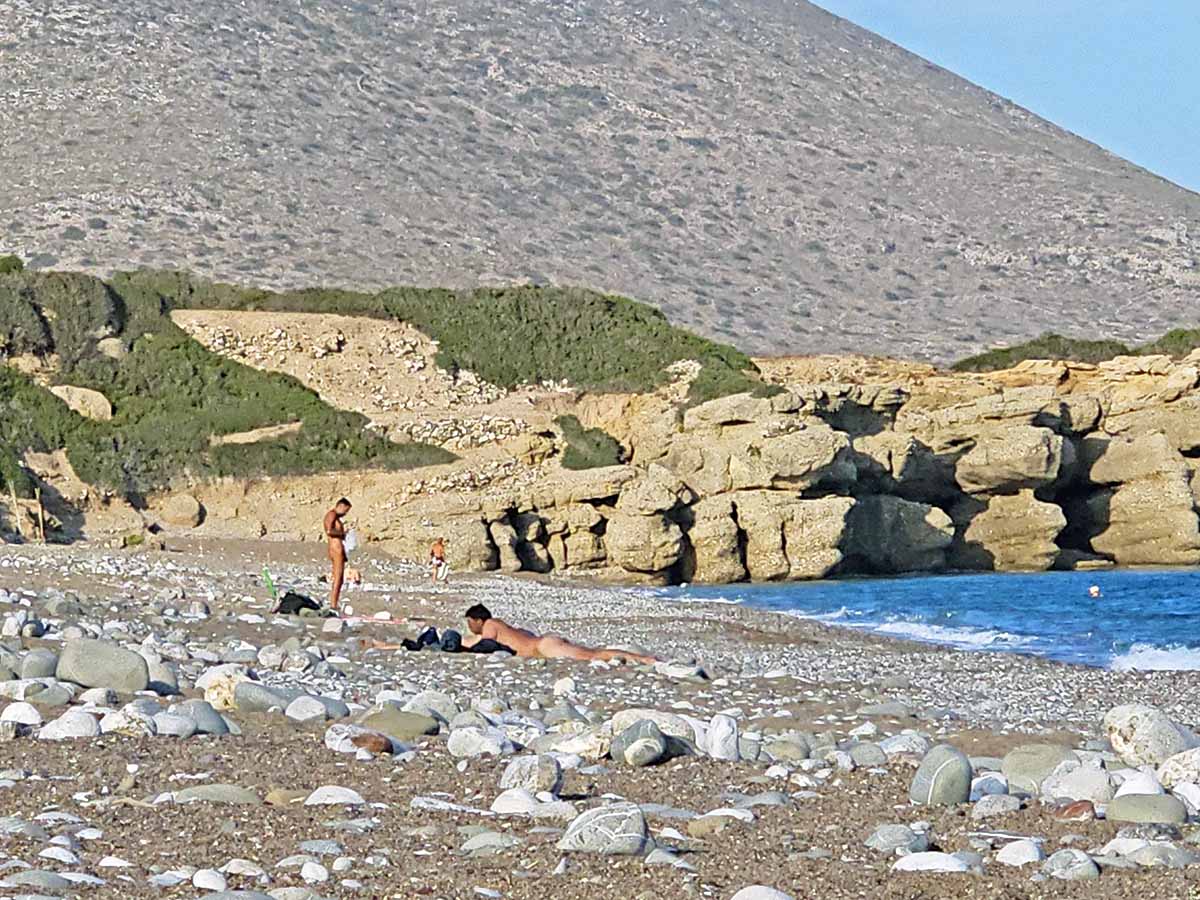
Limni is easily accessible by car. When coming from the direction of Avlemonas, turn left just after Hotel Skandeia, onto a dirt road that follows a dry riverbed. Park at the end, and step into a peaceful, clothing-optional world.
💡 Tip: Bring everything you’ll need for the day – there are no tavernas or much shade, just raw nature and the sound of the sea.
Fyri Ammos Beach (Southeast)
On Kythira’s southeastern shore lies Fyri Ammos (not to be confused with Firi Ammos near Agia Pelagia). This wild beach is a long sweep of reddish sand and pebbles, bordered by steep cliffs and open sea.
Due to its size and location, it rarely feels crowded, even in summer, and visitors can always find a quiet stretch to themselves.
The sea here is crystal-clear and deep, making it ideal for strong swimmers.
View this post on Instagram
💡 Tip: Stay until late afternoon. When the sun sets the reddish sand aglow, it gives the whole beach a warm, otherworldly blush.
If you want to get naked in Santorini, Mykonos, Syros, Amorgos, Naxos, and the rest of the Cyclades, check out these nudist beaches in Greece!
3. Look for the Heart-Shaped Green Lake
On Kythira’s wild west coast, not far from Limnionas Beach, hides one of the island’s most magical secrets: the Green Lake or Prasíni Límni. This natural seawater lagoon, carved right into the cliffs above the Aegean, can only be reached by a rocky trail.
Nothing is accidental in the mythic birthplace of Aphrodite. From above, this emerald pond takes on the shape of a heart (don’t get overexcited, as you’ll need a drone, or a very tall friend, to truly see it).
The rock pool itself is fed by the sea, yet sheltered from its waves, creating a calm, glassy surface perfect for a cooling dip after the trek (unless stagnant water gives you trust issues).
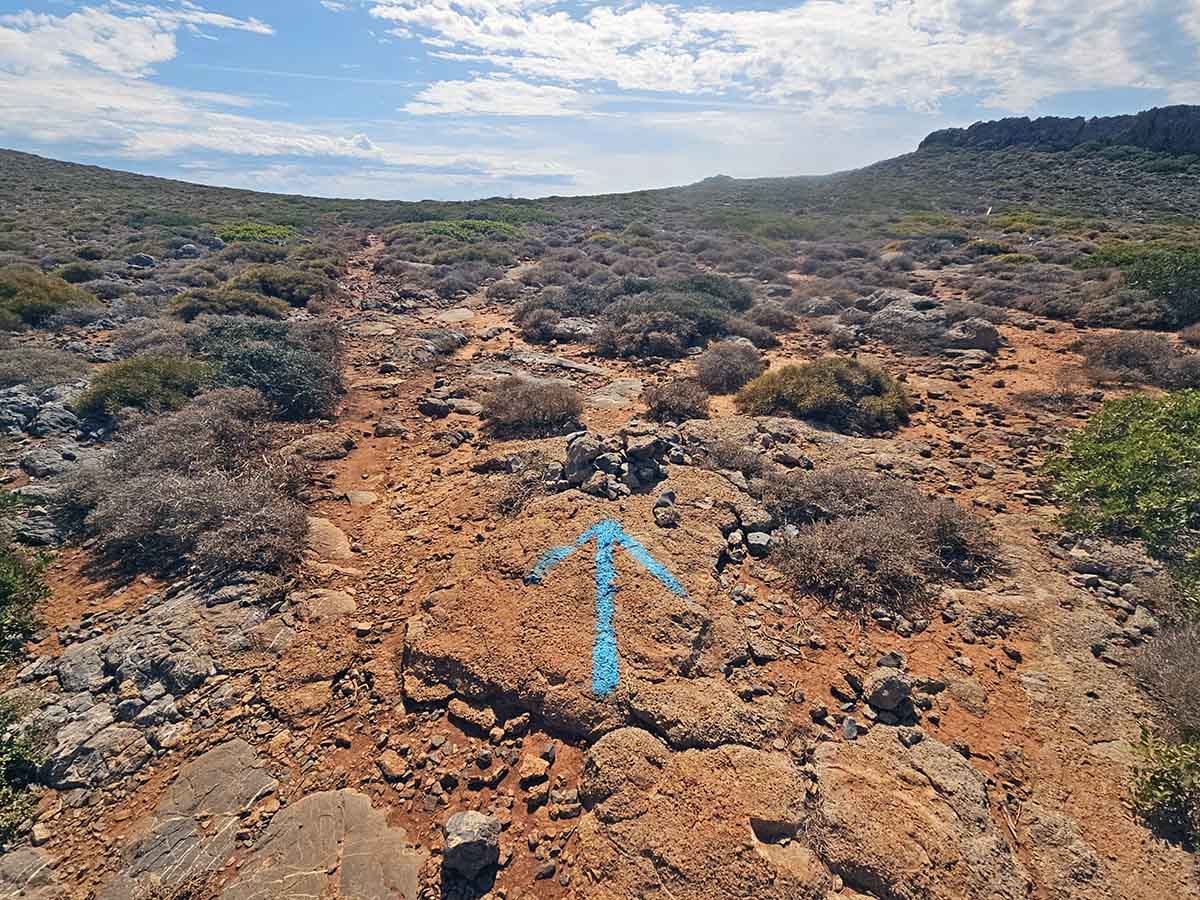
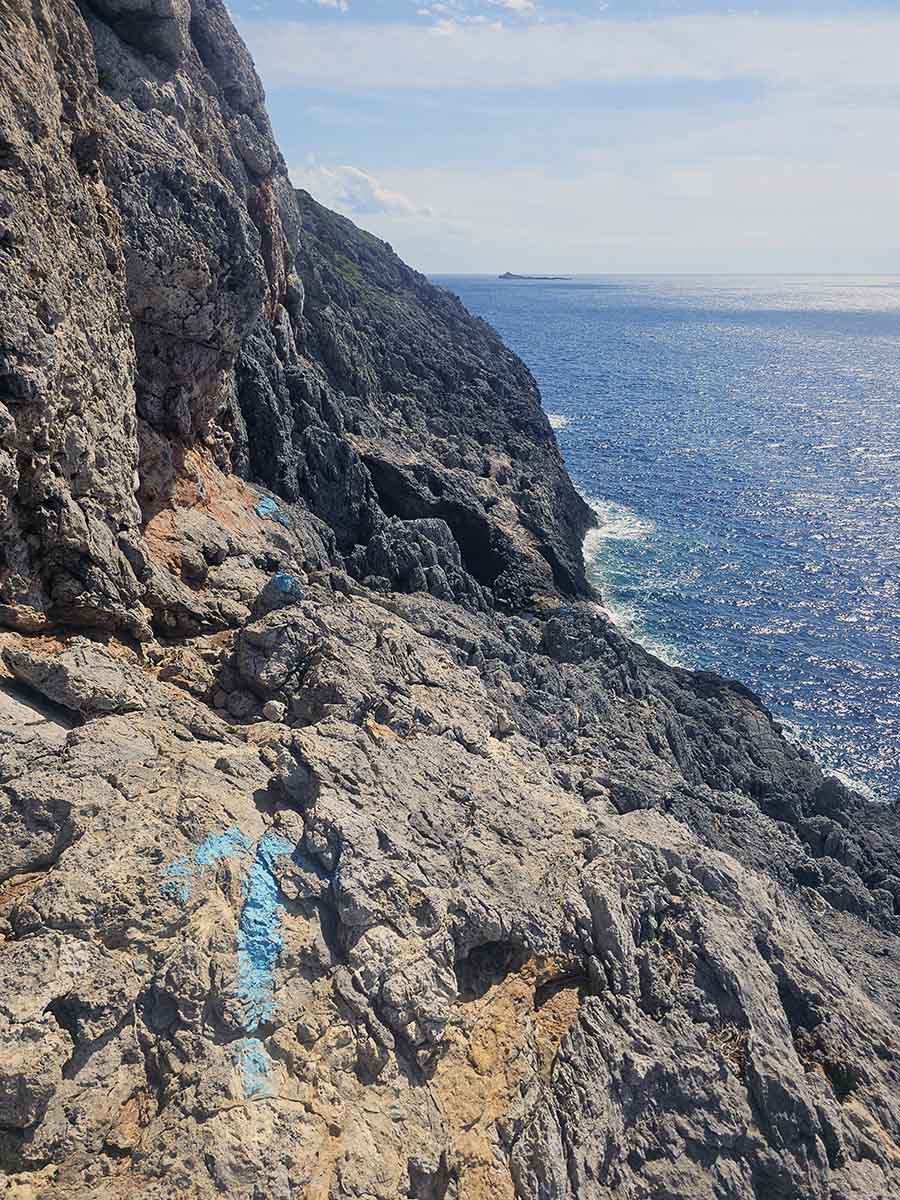
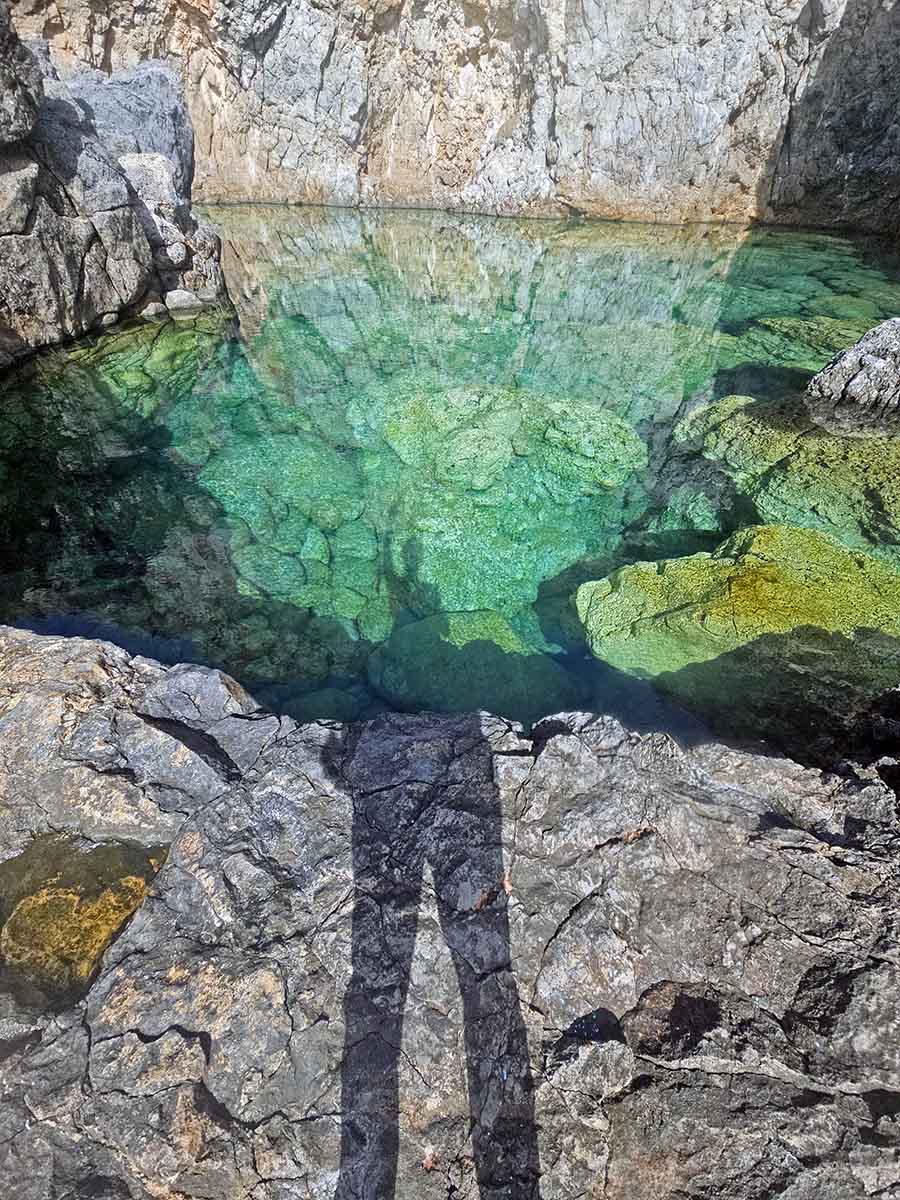
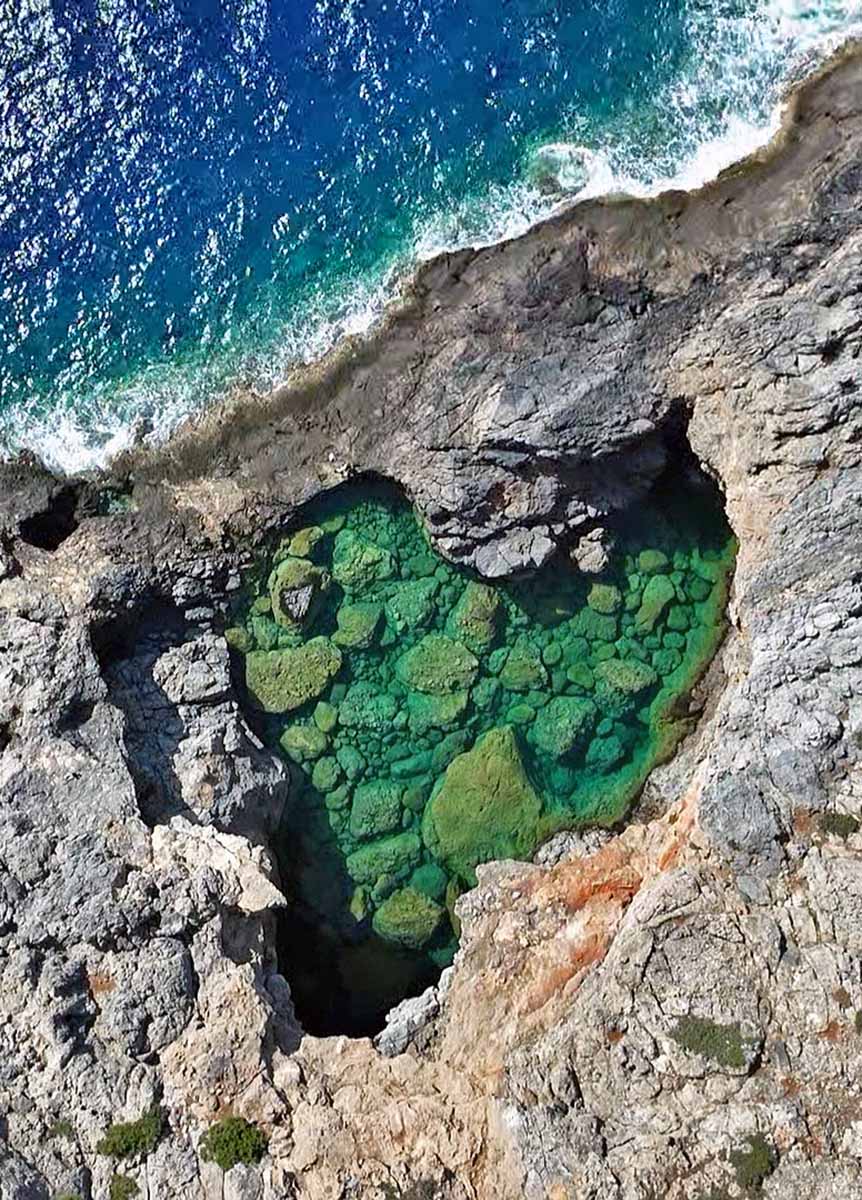
Hiking from the tiny fishing village of Limnionas (where you can park your car) to the Green Lake (sometimes also called Blue Lagoon, or Loutra Afroditis – Baths of Aphrodite) takes about 45 minutes. Assuming you don’t get lost (a bold assumption).
There are some markings on the trail, such as cairns and blue arrows sprayed on the rocks, but you’ll still have to rely on instinct when navigating this geography dominated by short prickly bushes.
Once you pass a larger, also heart-shaped, cove (is Kythira just showing off?), keep descending over the rocks. You’ll need all four limbs for the last stretch, scrambling past cave-like openings in the cliffs before the hidden lagoon finally appears: a gleaming green heart tucked into the stone.
💡 Tip: Wear sturdy shoes for the hike, and bring plenty of water. For the most romantic scene, time your visit for late afternoon, when the sun slants low and the heart-shaped lagoon glows golden-green.
There are plenty of islands of hearts all around the world, but you can find the most heart-shaped islands in the Adriatic Sea. Check them out!
4. Hike the Kakia Lagada Gorge
Another Kythira coastal attraction is a body of water just meters away from the sea. Limni (the lake) is a pond formed by the mouth of Kakia Lagada or Paleochora Gorge, and marks the spot where the infamous pirate Hayreddin Barbarossa began his brutal invasion.
You’ll have to be in a great physical condition when deciding on a challenging Kakia Lagada hike. The trail can start either from Trifillianika village or directly from the ruins of the medieval castle city of Paleochora, and then follows the bed of the gorge, nested between the large vertical walls, requiring the use of rope (abseiling) at a few sections.
At the northern coast of Kythira, just east of Agia Pelagia, the trail finishes at the Kakia Lagada Beach, a stretch of pebbles and rocks separating fresh water from the salt.
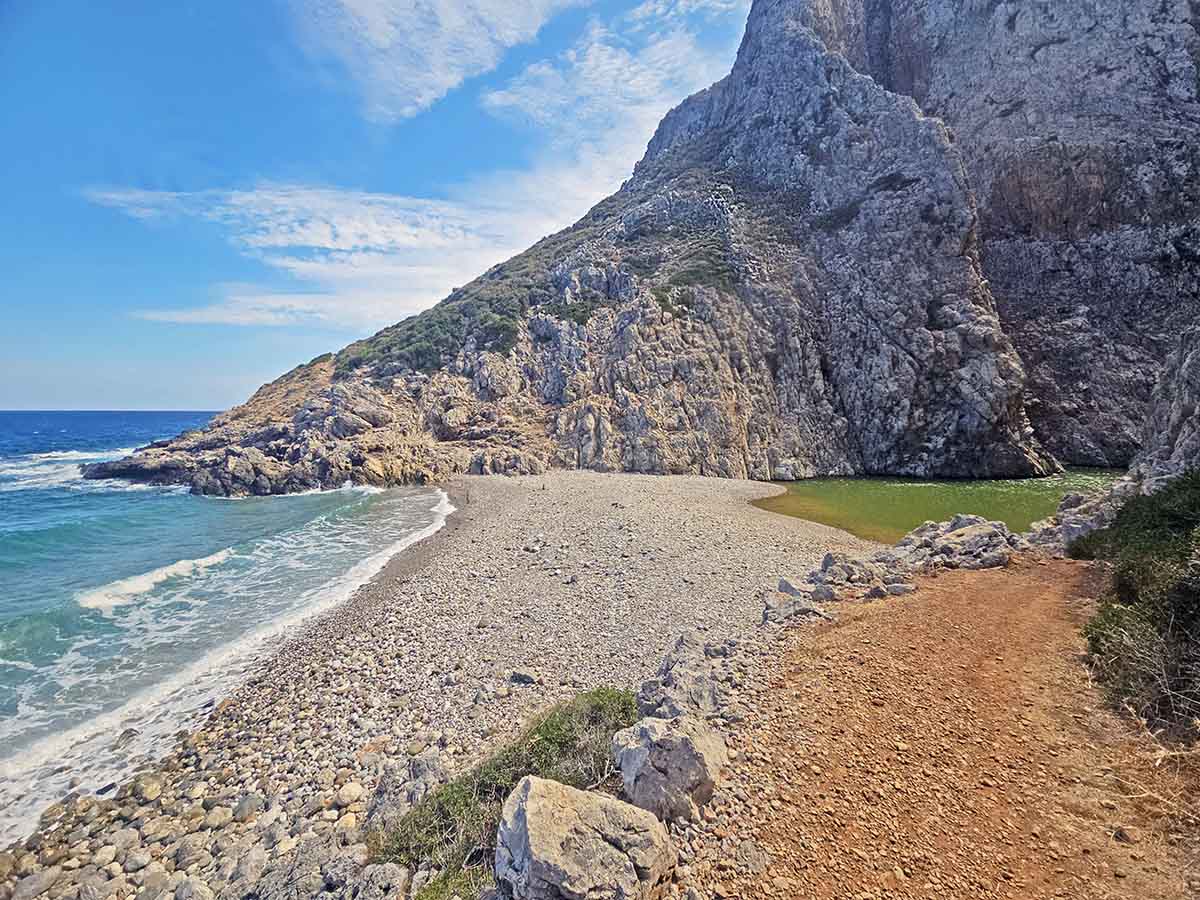
Roughly translated as Ravine of the Wicked Woman, Kakia Lagada Gorge is Kythira Island’s most dramatic canyon, recommended only to advanced mountaineers in excellent physical condition and accompanied by a local guide.
💡 Tip: Wear proper hiking gear, bring water, and check the weather – the gorge can be dangerous after rain.
5. Explore the Ghostly Kythira ruins of Kato Chora
Between Limnionas and Mylopotamos lies Kato Chora (Lower Town), Kythira’s abandoned village built by Venetians in the 16th century. Hidden among olive groves and quiet valleys, these Kythira ruins are remnants of a defensive outpost against pirate raids, a ghost town deserted in the 1950s.
Behind the weathered winged Lion of St. Mark, the emblem of the once-mighty Republic of Venice, the fortified outpost of Kato Hora Mylopotamou once thrived with two-story stone houses, narrow lanes, tiny chapels, and a small fortress clinging stubbornly to the hillside, in poetic but haunting silence.
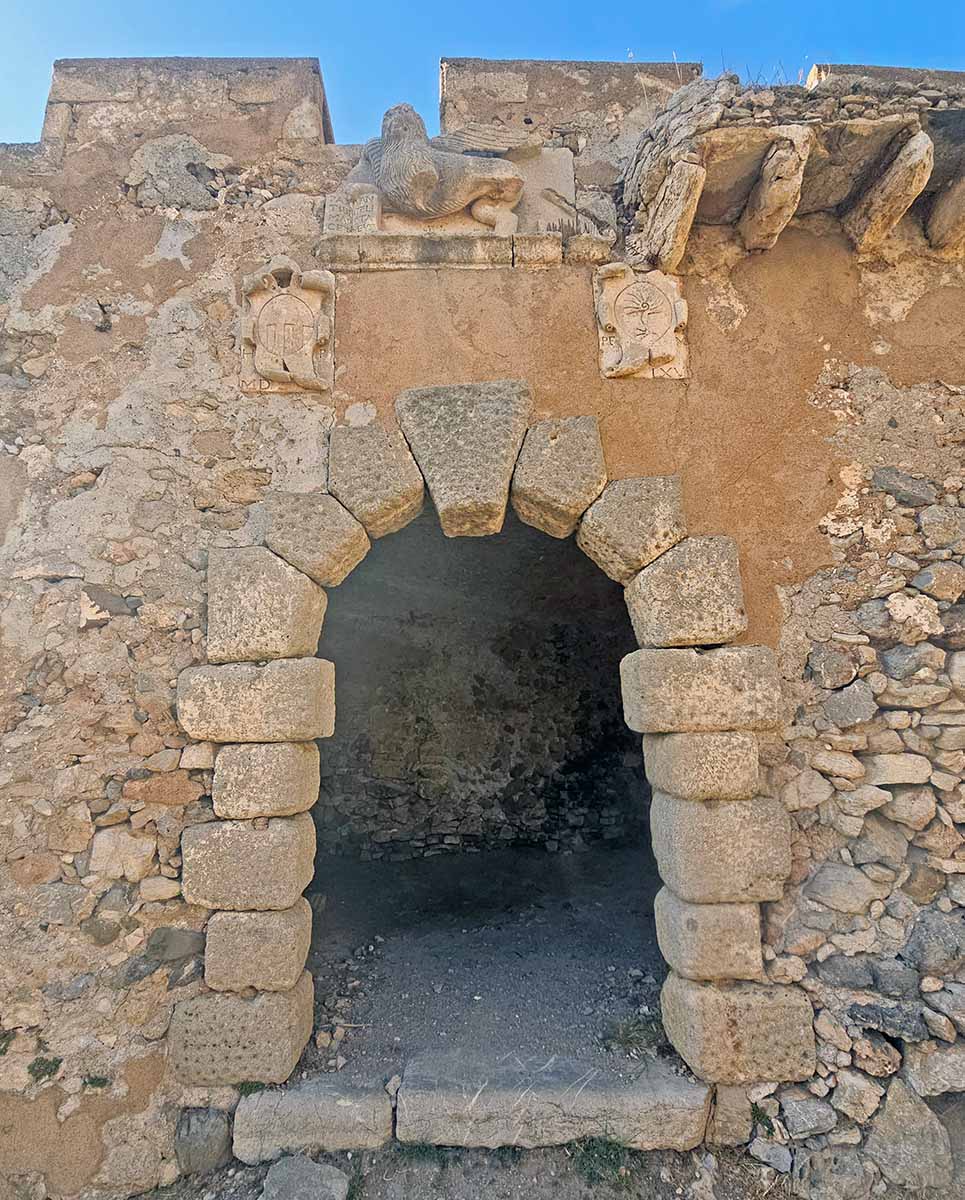
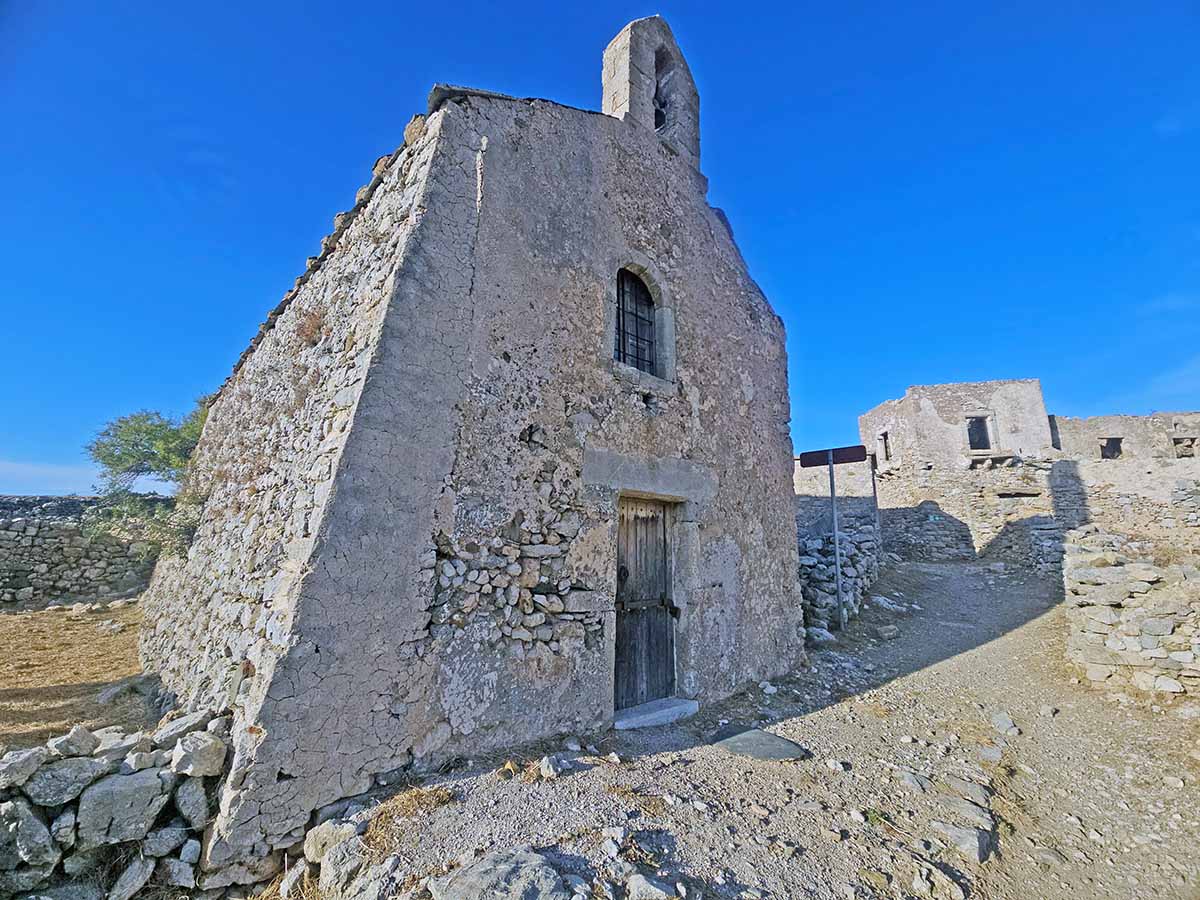
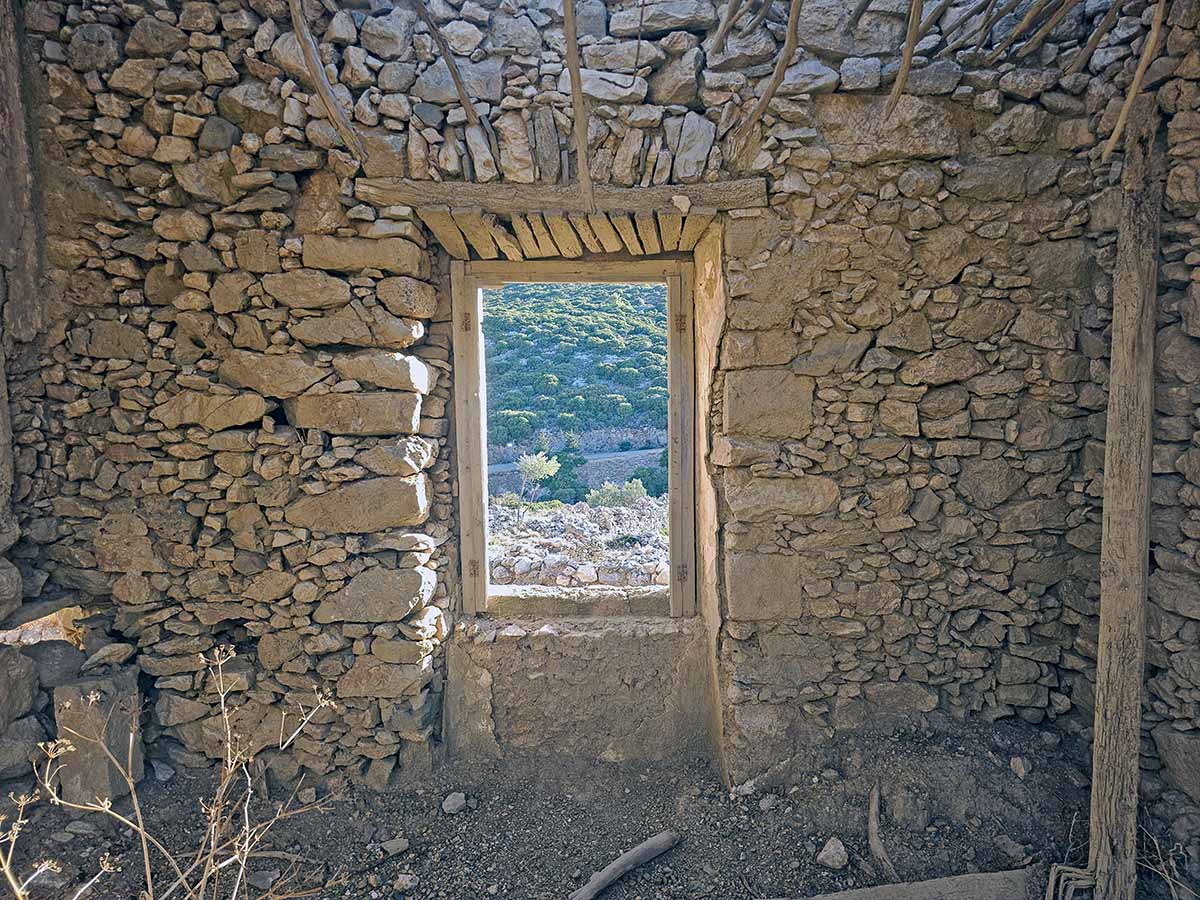
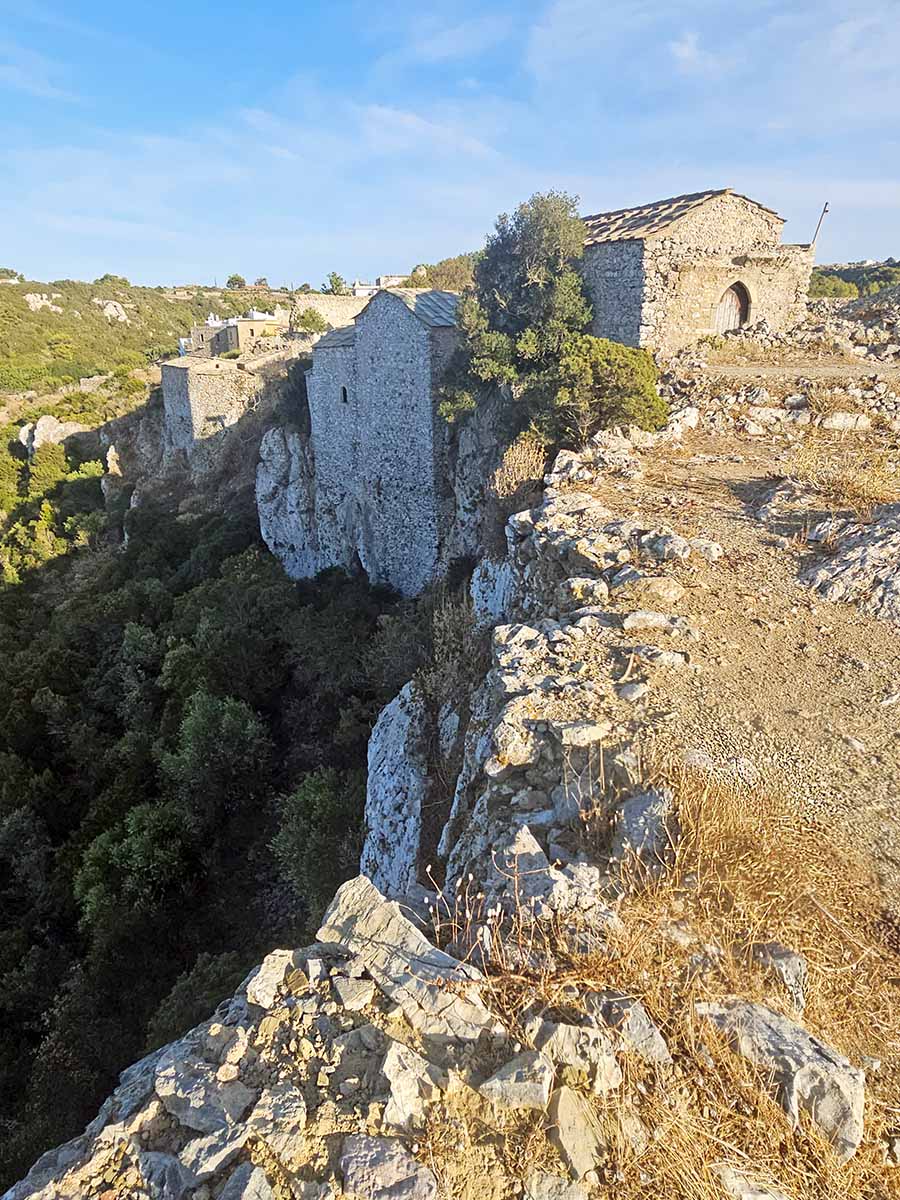
Wandering through the crumbling arches and weathered walls of the medieval Castle of Mylopotamos, fragile traces of a defense system gone by, you might realize how, unlike the timelessness of Aphrodite, human ambition is not permanent. Empires rise and fall.
💡 Tip: Visit in the late afternoon when the light softens over the olive trees. Bring a camera, but more importantly, time – Kato Chora rewards slow exploration and quiet reflection.
Explore Kato Chora Mylopotamos Castle in this Pipeaway Walks video!
6. Hike the Valley of the Watermills to Kythira’s waterfalls in Mylopotamos
If there’s a single walk that captures the soul of inland Kythira, it’s the hike through the Valley of the Watermills near Mylopotamos (trail M41). This lush ravine feels worlds away from the island’s sunburnt hills and rocky coasts: shaded by plane trees, laced with streams, and echoing with birdsong.
After a fulfilling lunch in the natural shade of Platanos Restaurant in the heart of the village (I enjoyed a hearty portion of pasticcio, and was sent off with an ice-cream as a farewell gift), continue on the footpath winding gently downhill along the stream, passing by the watermills that gave Mylopotamos its name (translatable as the river of mills).

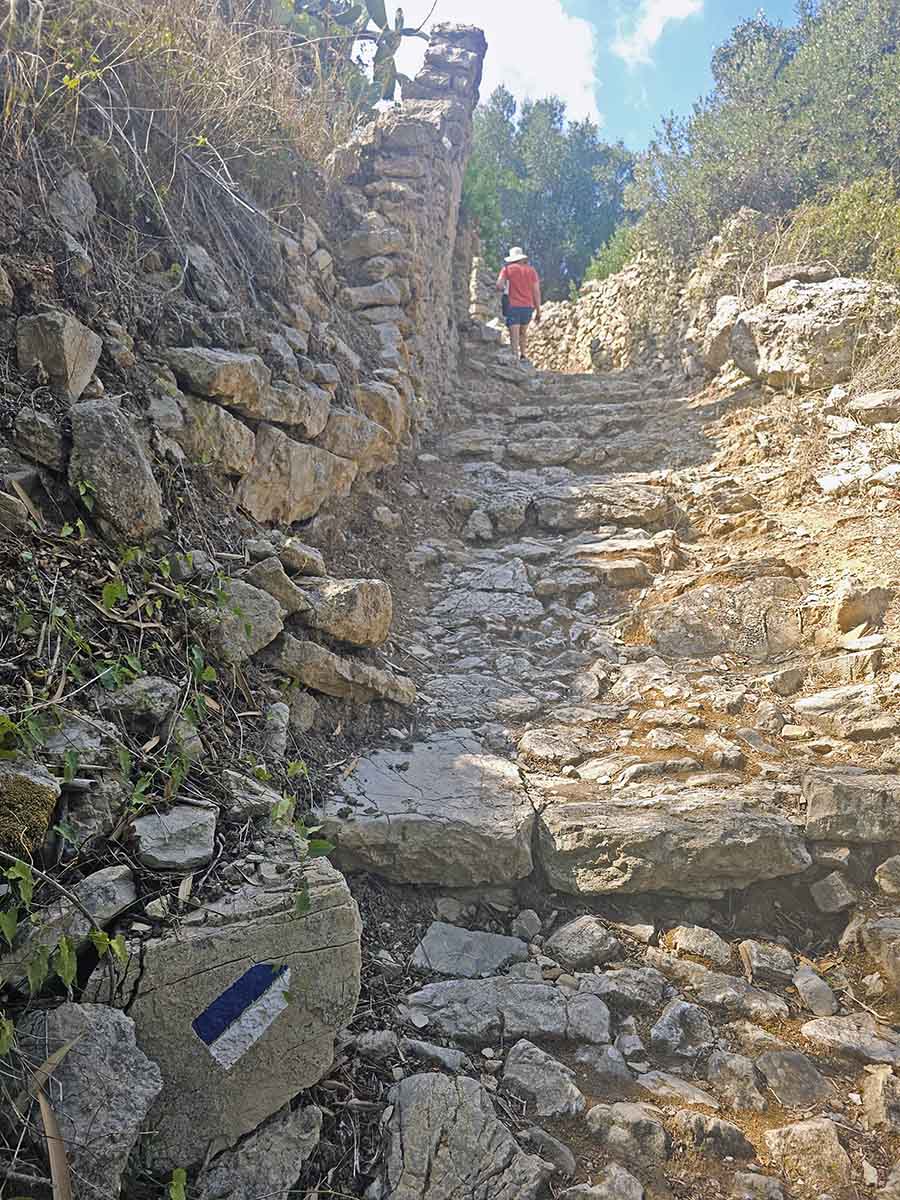
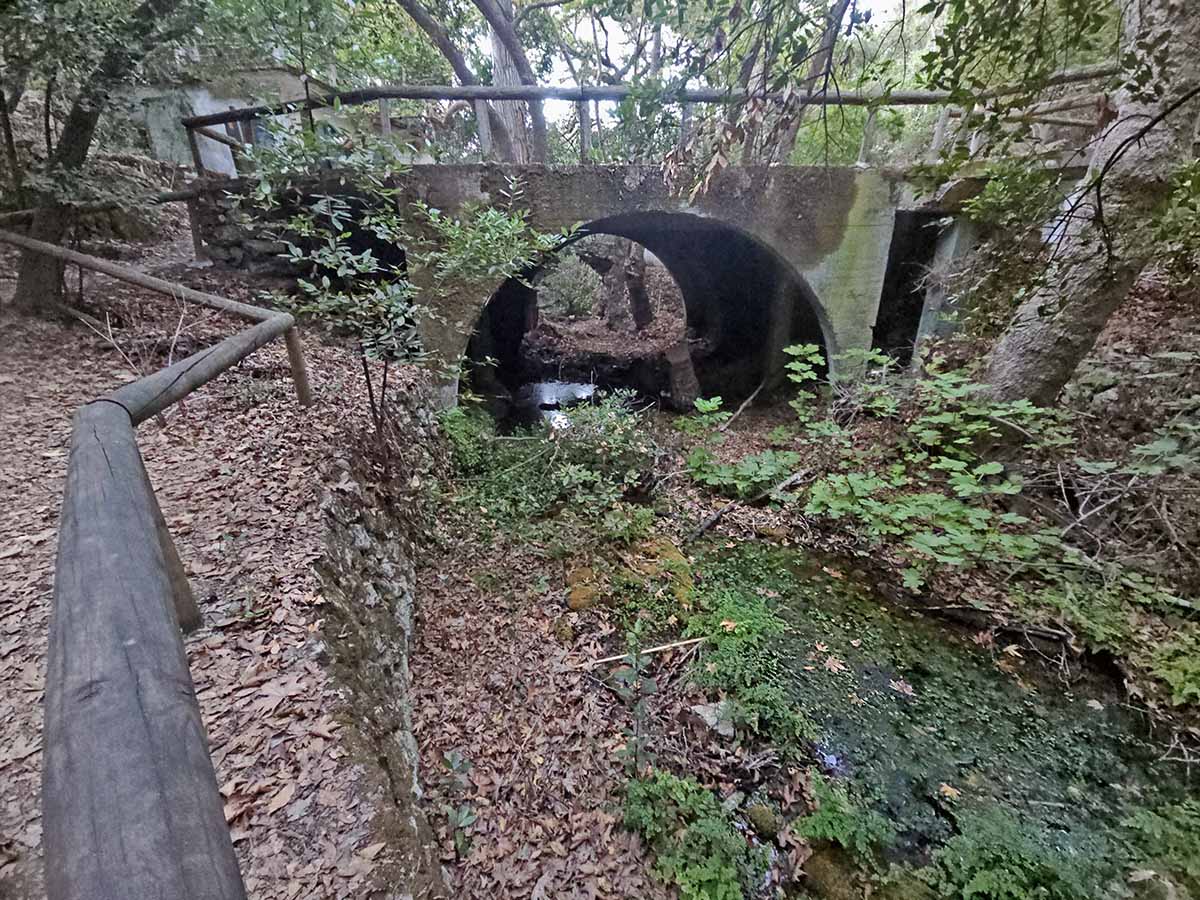
View this post on Instagram
The route passes the remains of over a dozen Venetian-era watermills, once the beating heart of local life. Moss-covered stone walls and ivy-wrapped mill houses whisper of a time when flowing water powered Kythira Island’s bread and trade.
At the heart of the valley lies Fonissa or Neraida Waterfall, tumbling into a natural pool, at least in spring and early summer. By late summer or autumn (July-October), Kythira’s waterfall may dry up, especially during drought years. Even if the waterfall wasn’t active during my September visit, this path through the cool, shaded glen was one of the most enchanting Kythira walking trails.
7. Wander Through Kapsali Bay’s Trail of Wonders
The M12 circular trail will take you through some of the greatest wonders written in stone of the twin Kapsali Bay. To follow the entire route of 4.2 kilometers, set aside at least two hours.
Start on the hills that separate the double bay, one dominated by the solitary Kapsali Lighthouse (built by the British in 1853), the other marked by the Church of Agios Georgios (the whitewashed chapel honoring the dragon-slaying patron saint of courage and defense).
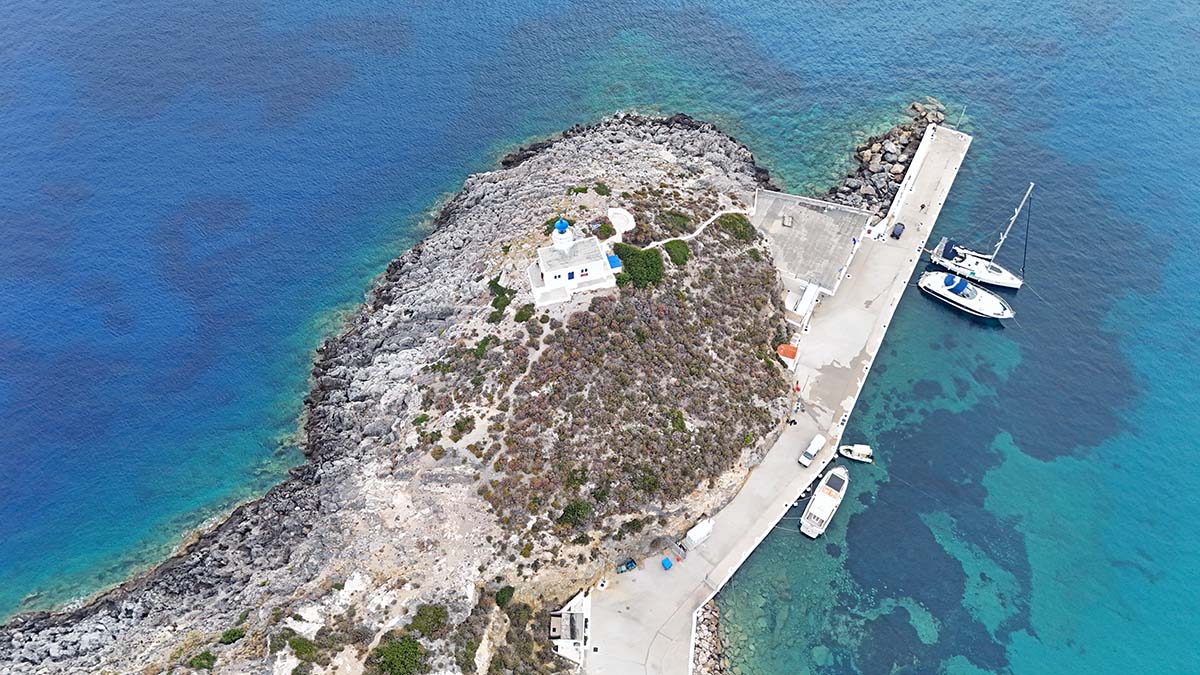
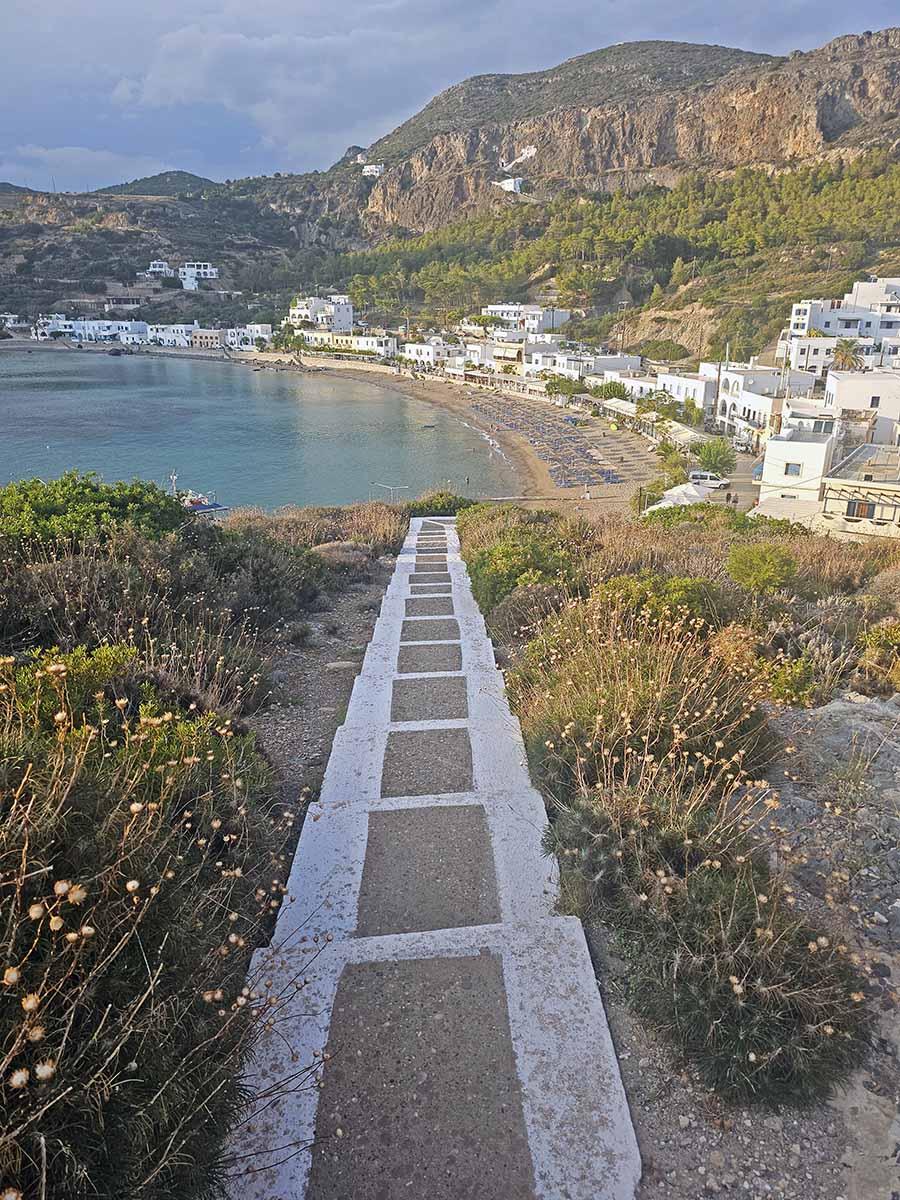
The trail dips down to Kapsali Beach and winds northwards through a pine forest. Follow the stone steps leading to Agios Ioannis En Krimno (Saint John on the Cliff), a church built into the rock face, around the cave claimed to be a place where Saint John the Theologian, fleeing Roman persecution, began writing the Apocalypse.
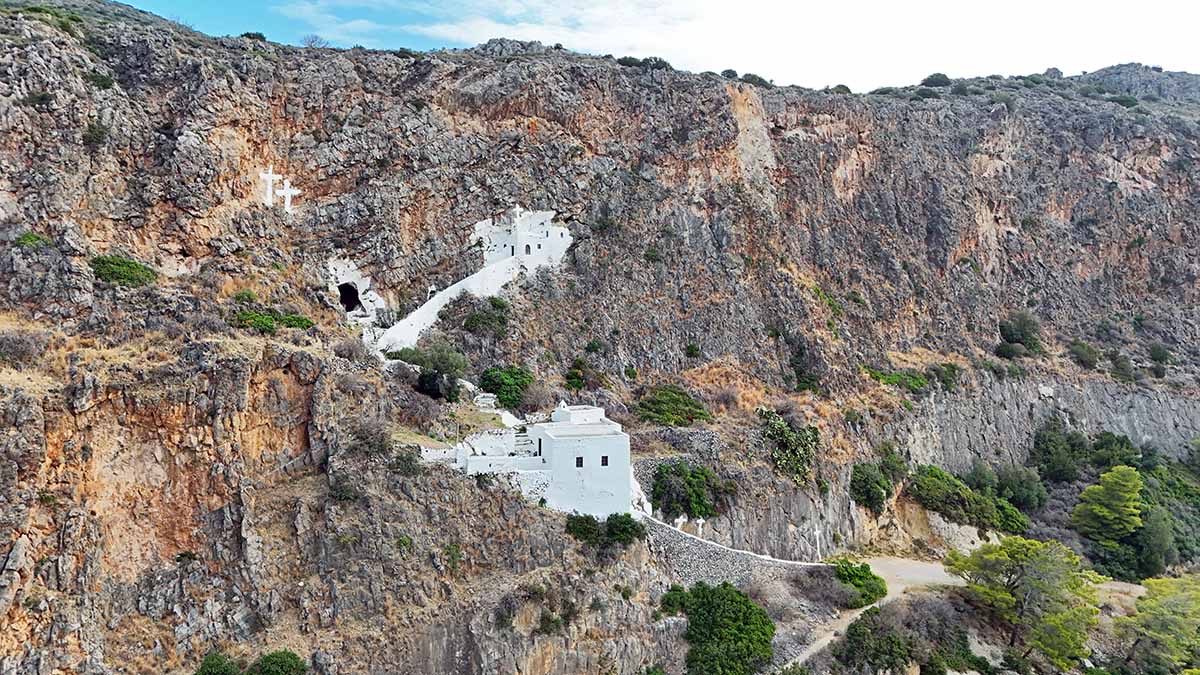
The church is technically open July-September (Mon–Fri 8 am – 2:30 pm, Sun 5:30 pm – 8:30 pm). While I did arrive in those advertised hours, I still only managed to kiss the locked door. Your best chance to see the church from the inside is on June 24 (the Nativity of St. John the Baptist) or August 29 (his beheading day).
After passing the pine forest, Agios Nikolaos Chapel, olive groves, and fields, you reach the cliffs of Sgouritsi cove.
The rocky peninsula east of Kapsali hides a few of its own surprises. In the landscape known as Apokleistra (literally the place of seclusion), you’ll first come across – a cross. Some unknown hand, long ago, perhaps, laid stones into a giant plus sign visible from above, a reminder of human presence. No local map or official guide explains its origin – whether a navigational mark, private memorial, artistic gesture, pirate’s treasure trove, or ancient symbol remains unknown.
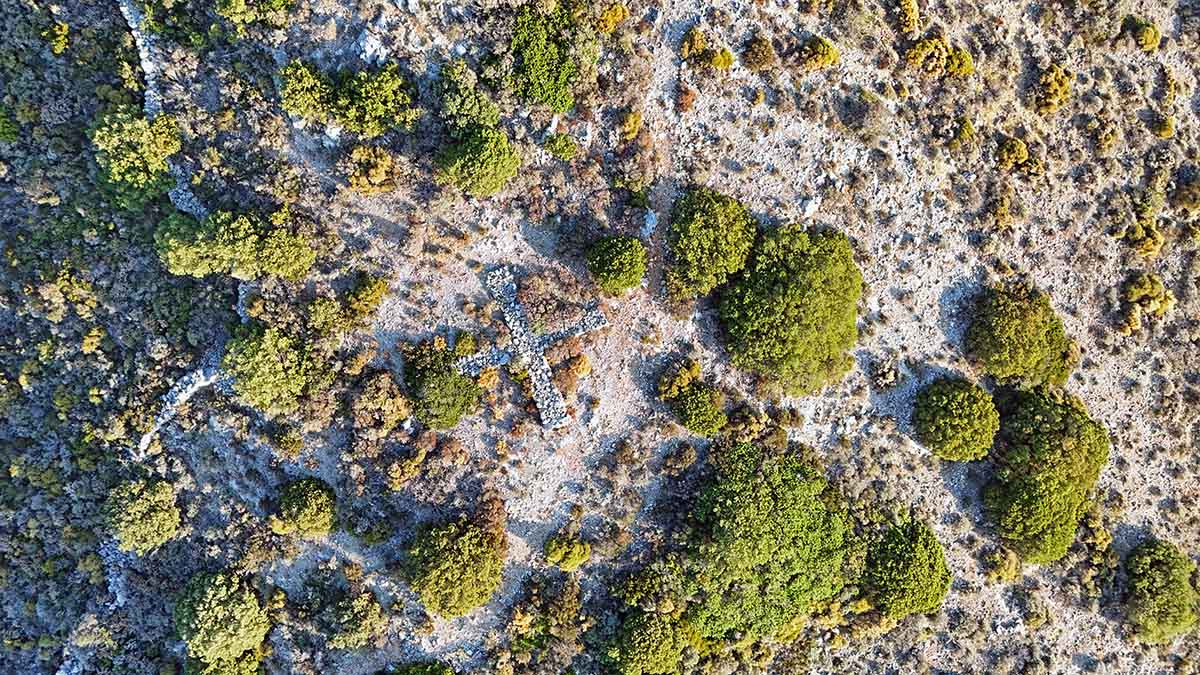
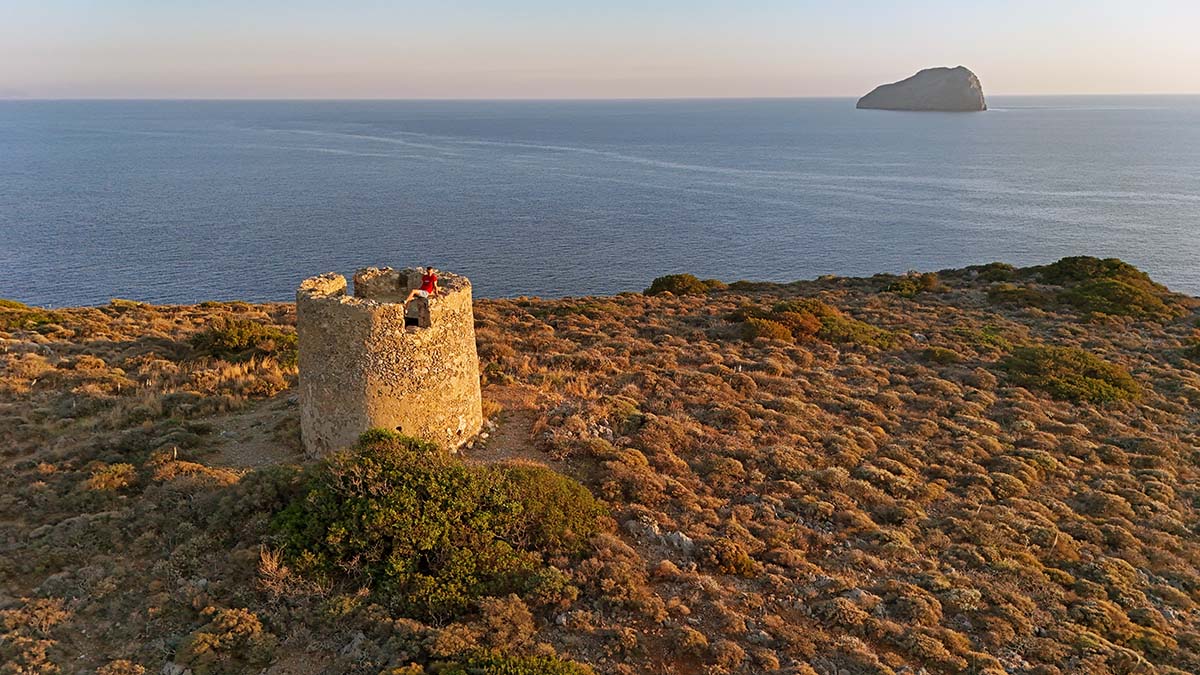
Some 500 meters further south, the ruins of an abandoned windmill still crown the headland, a hollowed-out circle on the bare ground. Seen from above, the circular form of the windmill and the cross made of stone may be just abandoned monuments to the past, a Tic-Tac-Toe combination of forgotten markers. But one could also, coincidentally, see a broken symbol of Venus (♀), the planet of love and beauty, and the celestial sign of Aphrodite herself, the goddess who famously rose from Kythira’s sea foam.
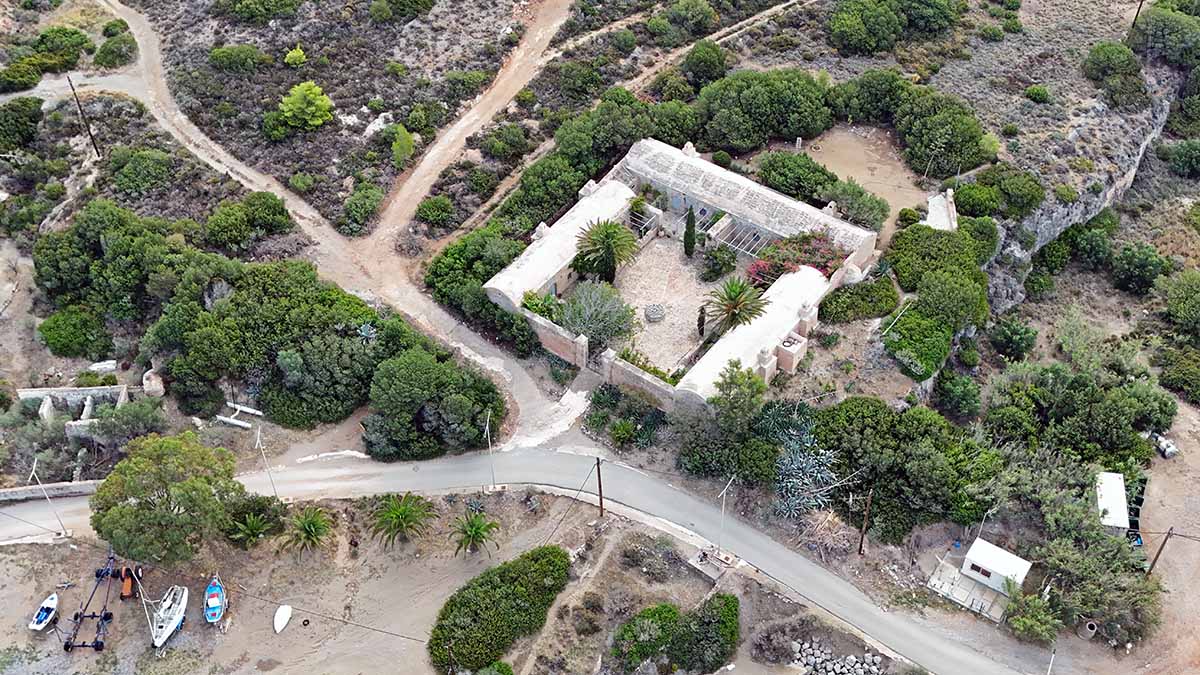
End your M12 exploration at Lazareto, the British-built quarantine station at Piso Gialo Bay, once used for seamen visiting the island of Kythira.
💡 Tip: Start early or late in the day to avoid the heat. Bring a hat, water, and curiosity.
8. Fall in Love With the Cats of Chora Kythira
Another walk worth your sweat in Kythira is the M1 trail from Kapsali to Chora and back.
Start from Kapsali Bay, following the narrow coastal path marked by blue-and-white markers toward Sparagario Beach. From there, the trail climbs steeply uphill, merging with a cliffside macadam road. At the Bridge of Kapsali, another relic of British engineering (1825), join the road that twists its way toward Kythira Town.
You can cut the hairpin turns by following meses, the shortcuts maintained by constant local footwork. The resting pavilions along the route offer a welcome excuse to pause.
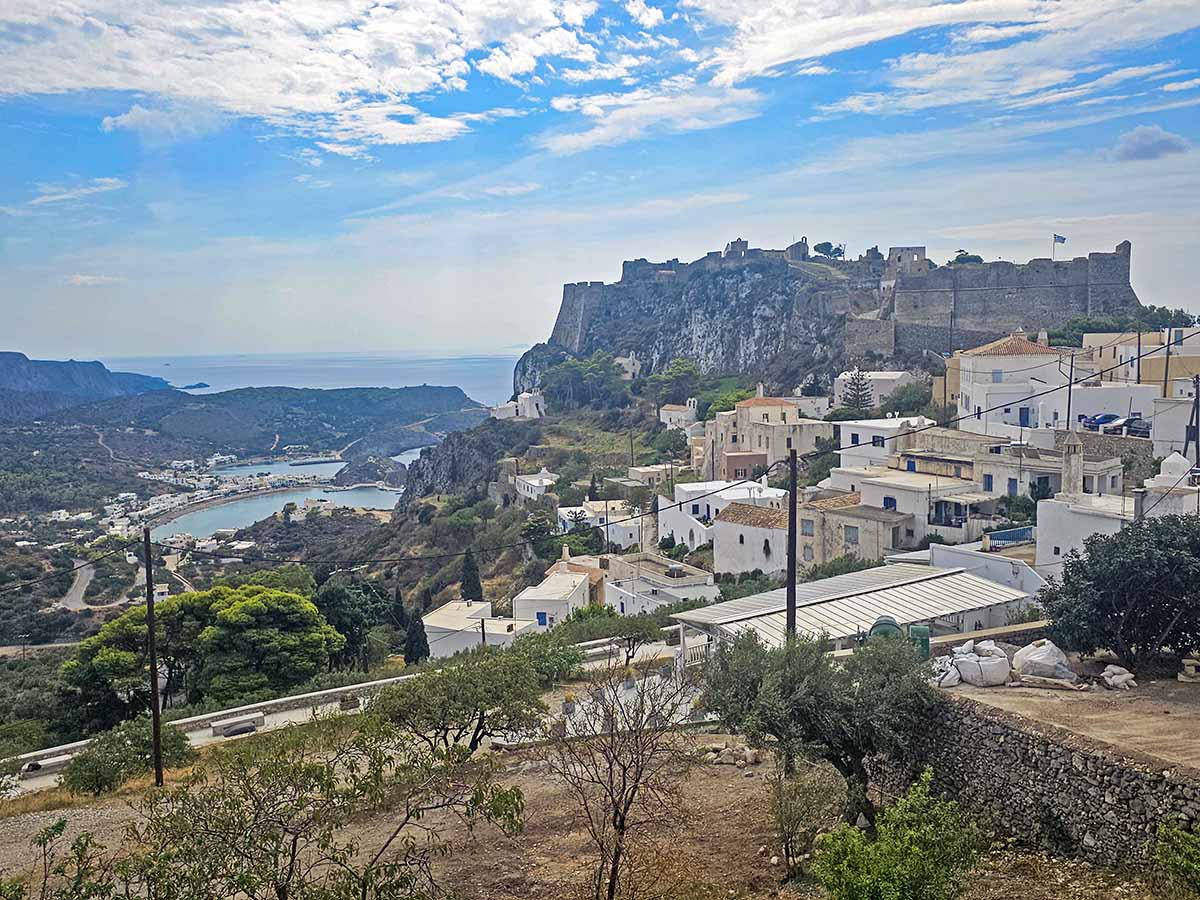
Before reaching the Secondary School, enter Mesa Vourgo, a historic neighborhood where 14 Byzantine churches nestle among old mansions and courtyards. In one of these, a friendly dog will insist on a head rub before allowing you to pass.
Pet lovers will also love exploring the alleys of Chora, where local cats take over the story. Sleek, collared, and perfectly at home, these feline citizens, as is the case in many Greek islands, rule the town. They stretch across marble doorsteps, nap on café chairs, and watch humans hurry about their business with an air of amused superiority.
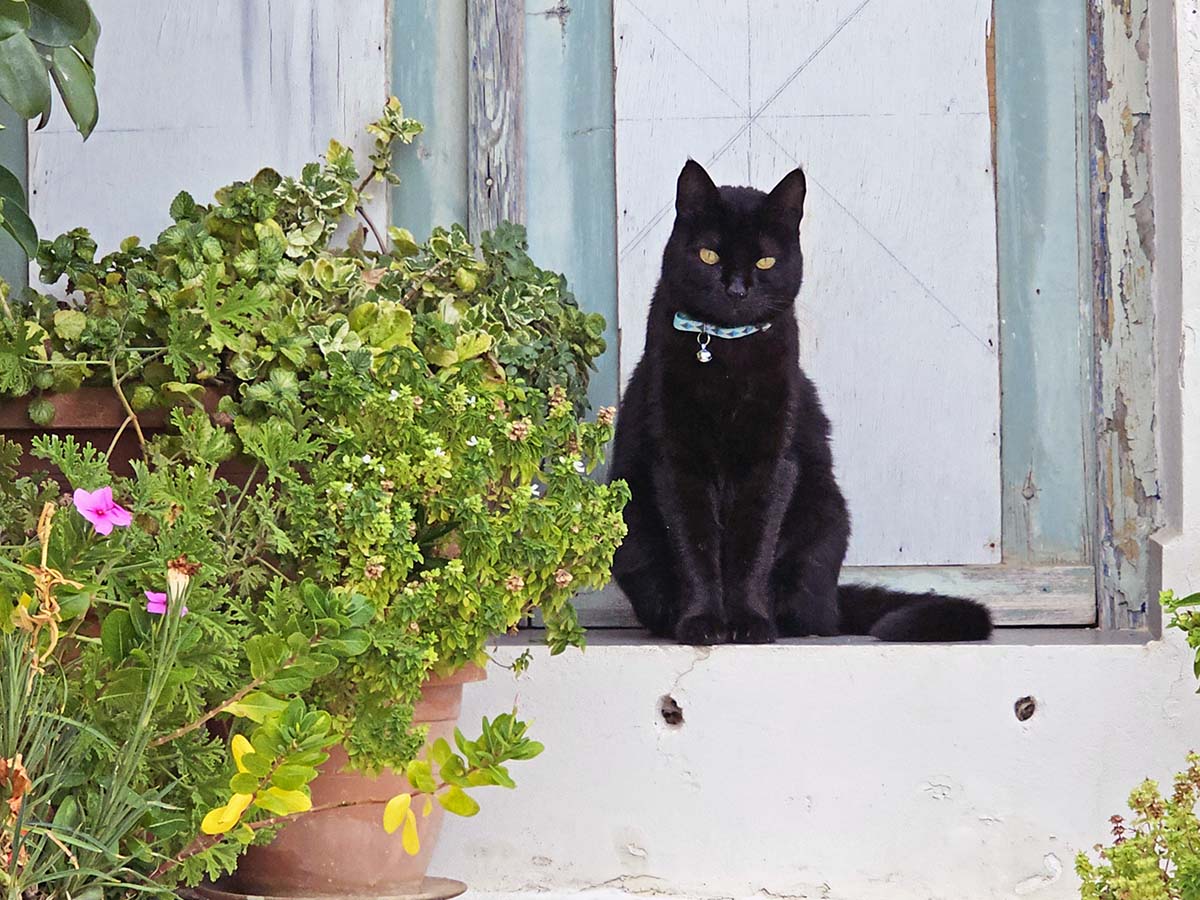
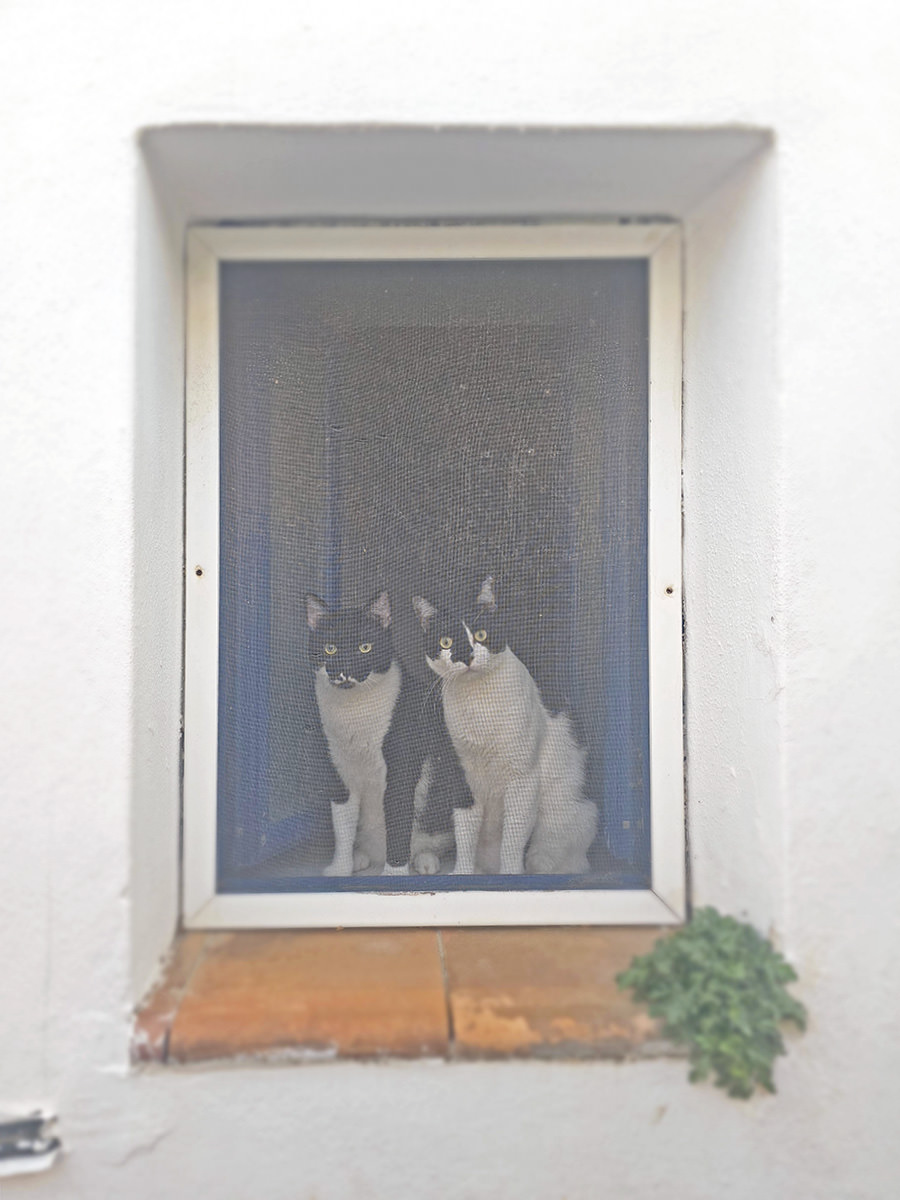

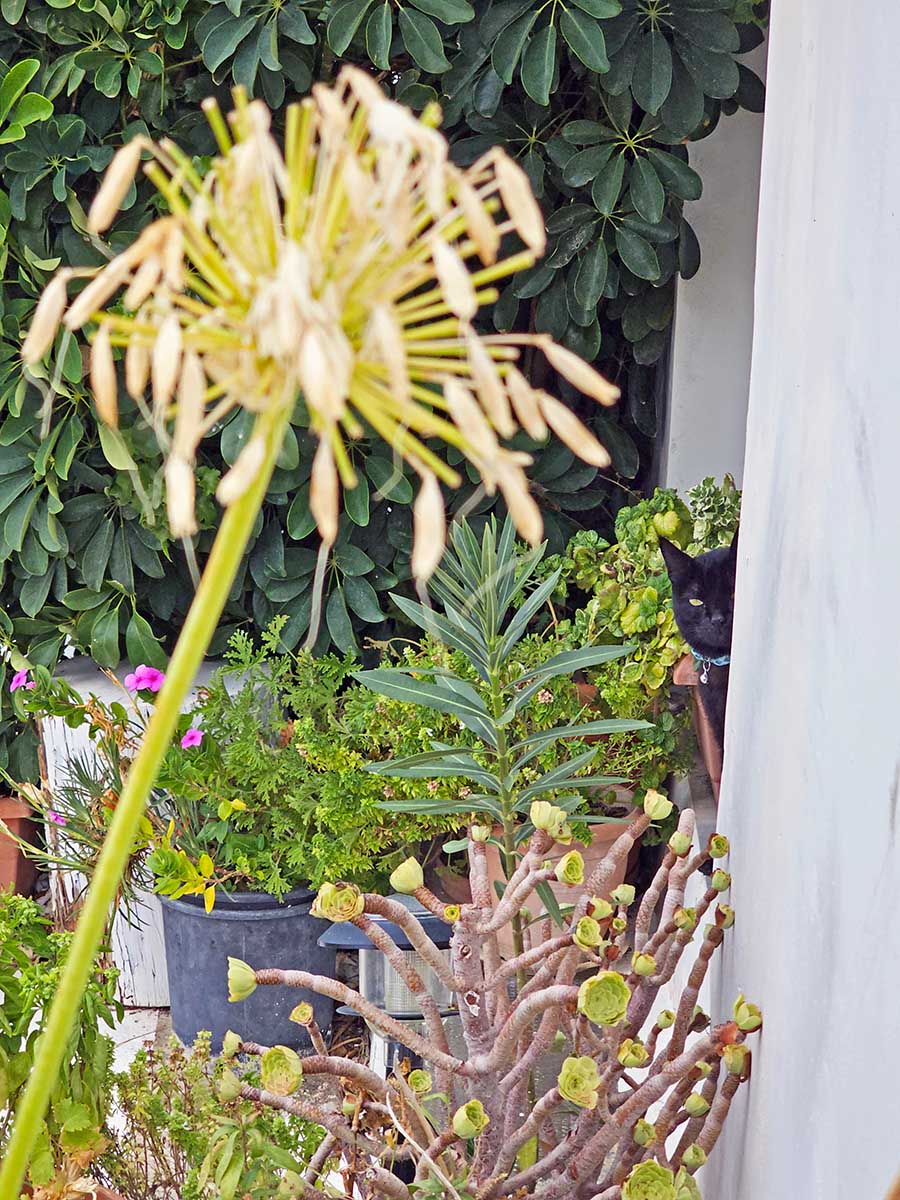
At the entrance to the settlement, you’ll find Kythira Archeological Museum, home to the famous archaic marble lion of Kythera, as well as Renaissance-era statues of Aphrodite and Eros – a reminder that love has always been the island’s best export.
A great place for a break is a café called Fossa. I visited it many times and tried every single cake, hoping to recommend the favorite, but I gloriously failed. Loved them all! If you have a sweet tooth, you’ll make a pilgrimage to Chora your daily Kythira routine just because of Fossa.
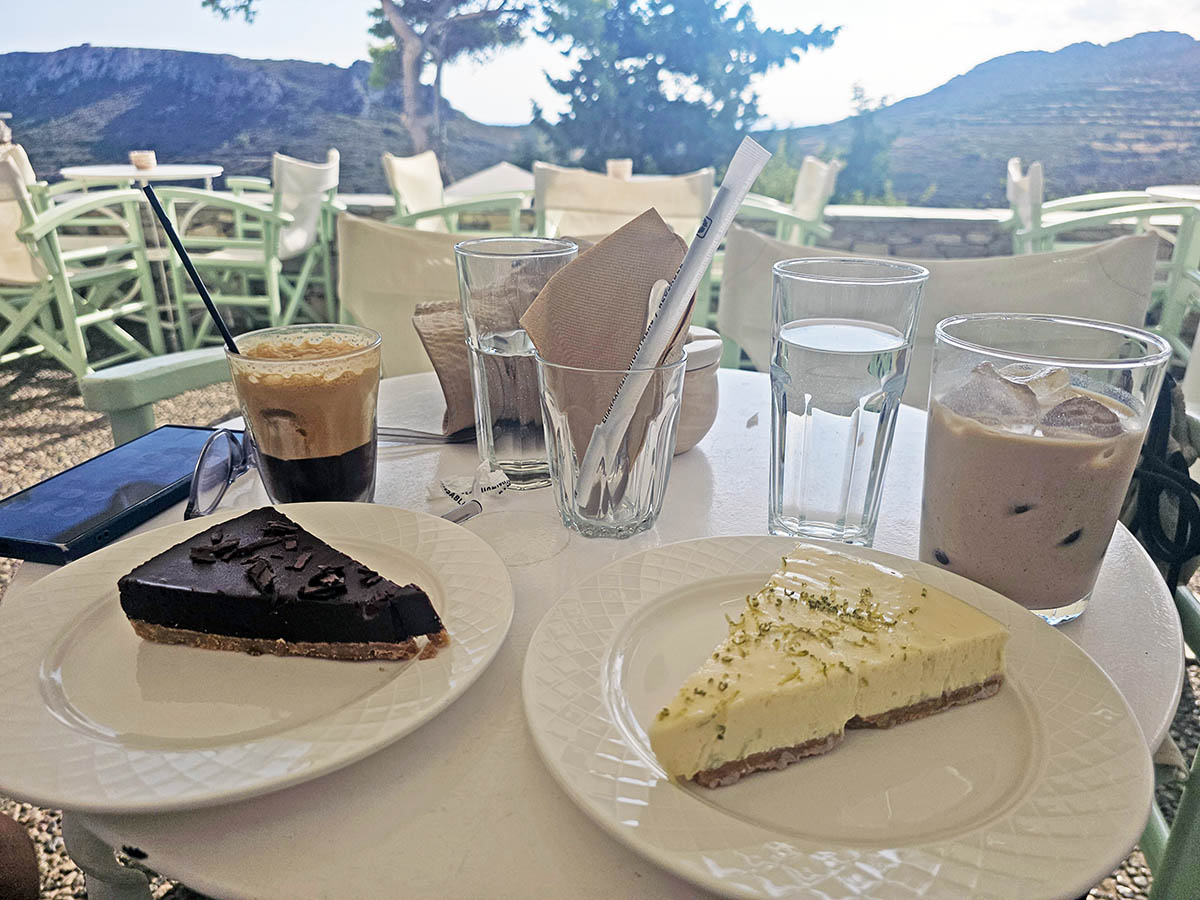
End your Chora visit at Kythira Castle, the Venetian fortress on Byzantine foundations, dominating the skyline and commanding sweeping views over the Aegean Sea (on a clear day – reaching all the way to Crete). Since it guarded vital sea routes, the strategically-located Kastro, the seat of the Venetian Governor of Kythira, has been known as the “Eye of Crete”.
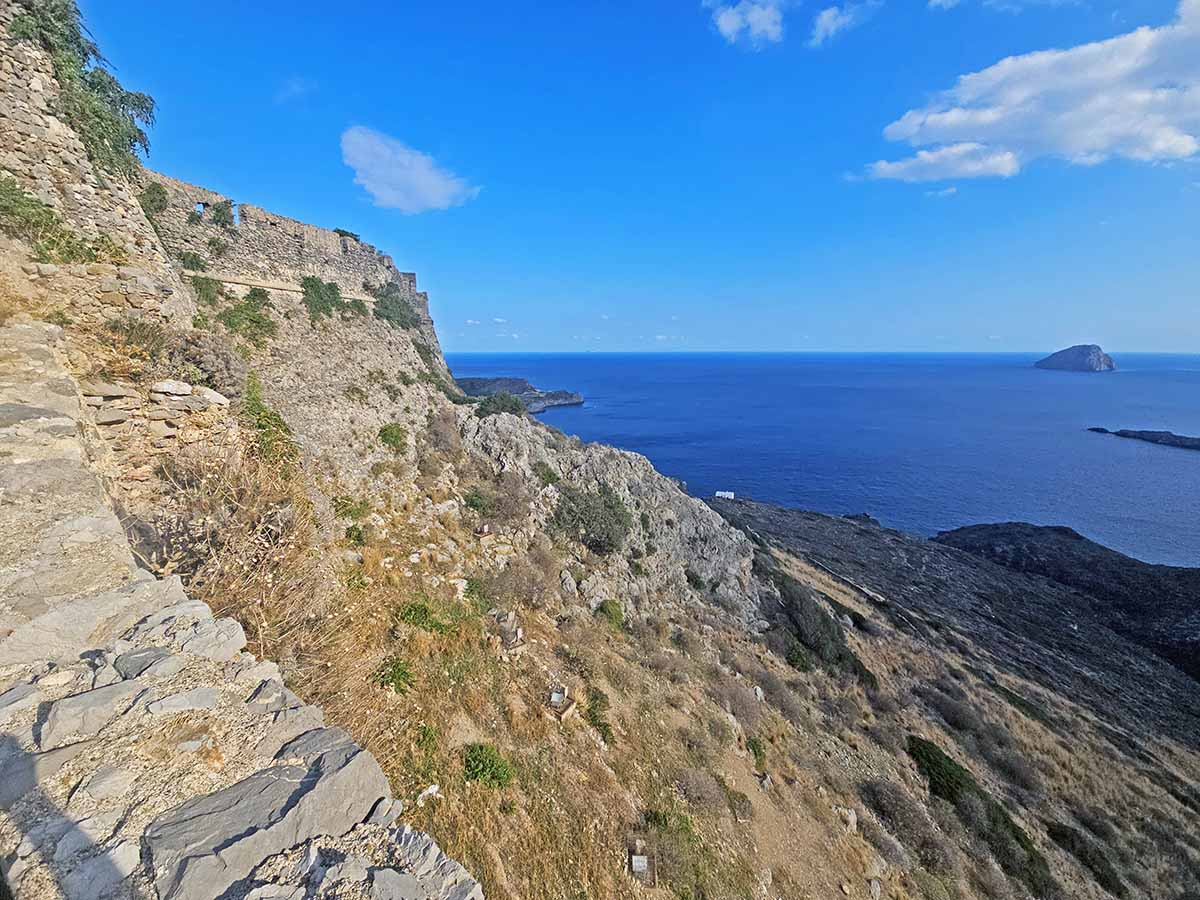
On your way back down to Kapsali, descend via the footpath along the western side of the Castle’s massive stone walls, rejoining the trail toward Sparagario at the cave church of Agios Pavlos.
9. Admire the British Stone Bridge of Love
Besides the Bridge of Kapsali, there is a handful of elegant stone bridges on Kythira dating back to the period of British rule in the 19th century.
Potamos Bridge, in the village of the same name, was constructed in 1823. Stretching 60 meters in length and 7 meters in height, it’s resting on seven arches.
Katouni Bridge near the town of Livadi was completed in 1826, officially, to link the island’s capital of Chora with the port of Avlemonas.
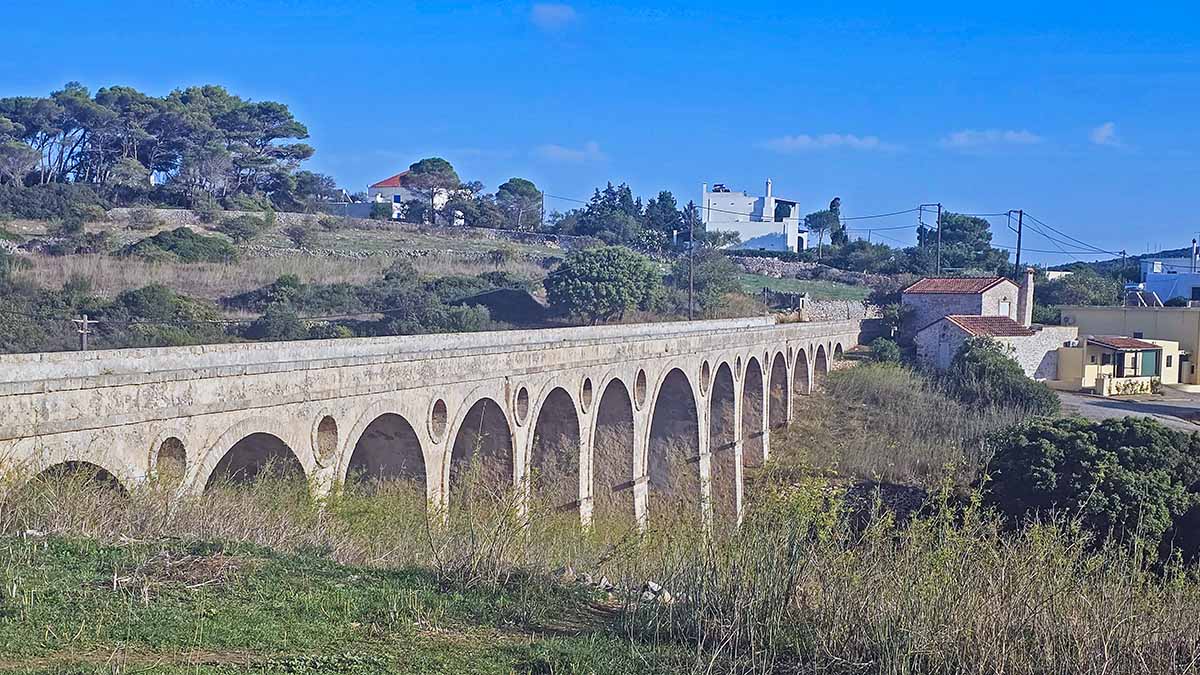
Unofficially? It was a labor of love. The British engineer John McPhail (or MacFale in some versions of the legend) commissioned the construction out of desire, so he could more easily visit his young mistress in the village of Katouni. The result of this amorous effort was a bridge resting on 13 arches, reaching the height of 15 meters, and stretching over 110 meters, making it the longest stone bridge in Greece.
Fact or folklore, the story endured and became a part of the bridge’s identity, a symbol of Kythira’s romantic charms that even colonial administrators couldn’t resist.
For more fascinating stone work, check out these ancient Greek bridges, all located in Zagori villages in the north of the country.
10. Hang Out With Ducks at Amir Ali Springs
In Kythira’s northern wilds lies a village called Karavas, where water flows even when the Valley of the Watermills falls silent.
In this verdant, fairytale setting, the spring of Portokalia (Greek for ‘oranges’) supposedly adopted its name from a legendary tree so large it was bearing thousands of oranges every year, and took an entire family for a proper tree hug.
The legend behind the springs’ other name – Amir Ali Springs – is a bit more sinister. During Ottoman rule, a Turkish supervisor named Amir Ali is said to have demanded the right to sleep with every newlywed bride. But a local named Giorgis had other plans: disguised as his own wife, he awaited the tyrant on his wedding night. In some versions of the story, the angered Amir Ali cut off the man’s head by the spring. Others say it was the despot who got beheaded. In a gentler retelling, Amir Ali fell from his horse when he fell in love with a woman from Karavas.
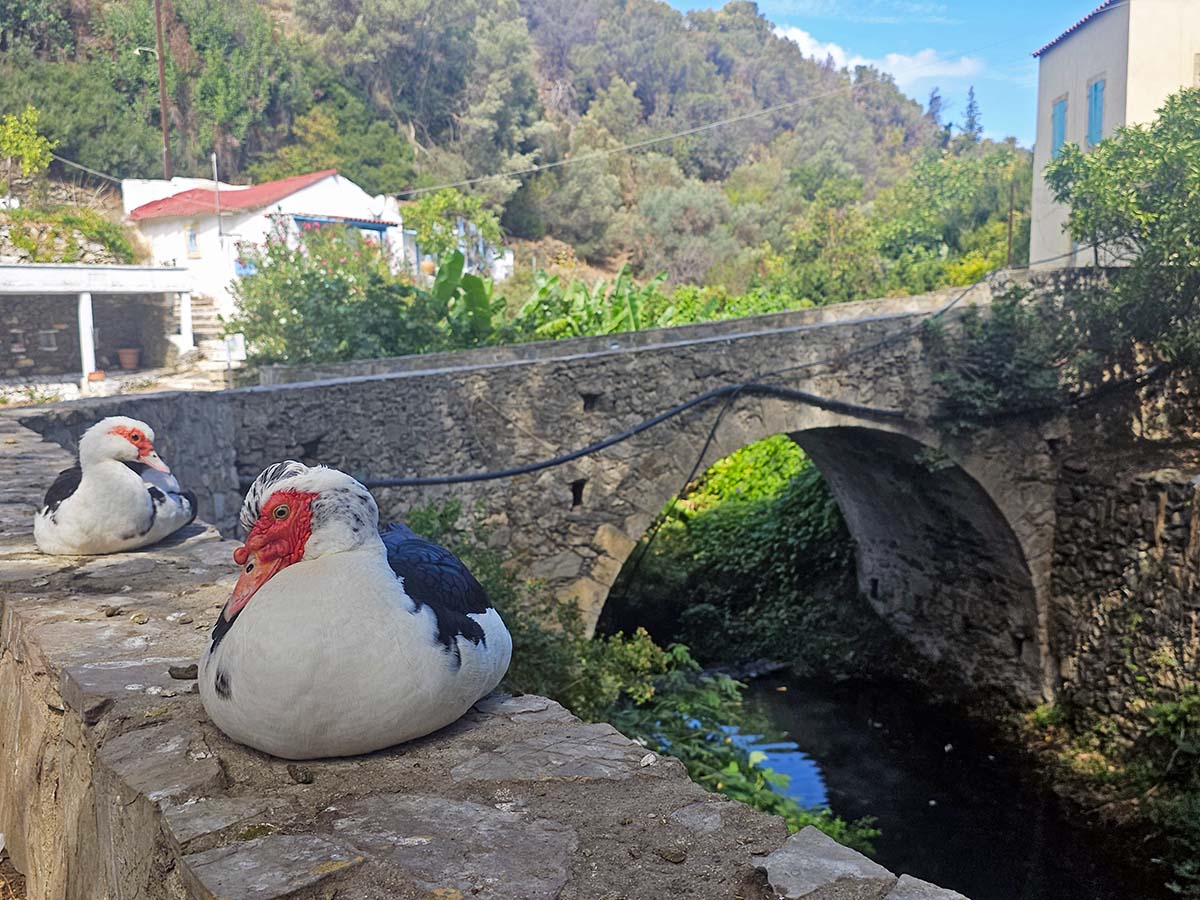
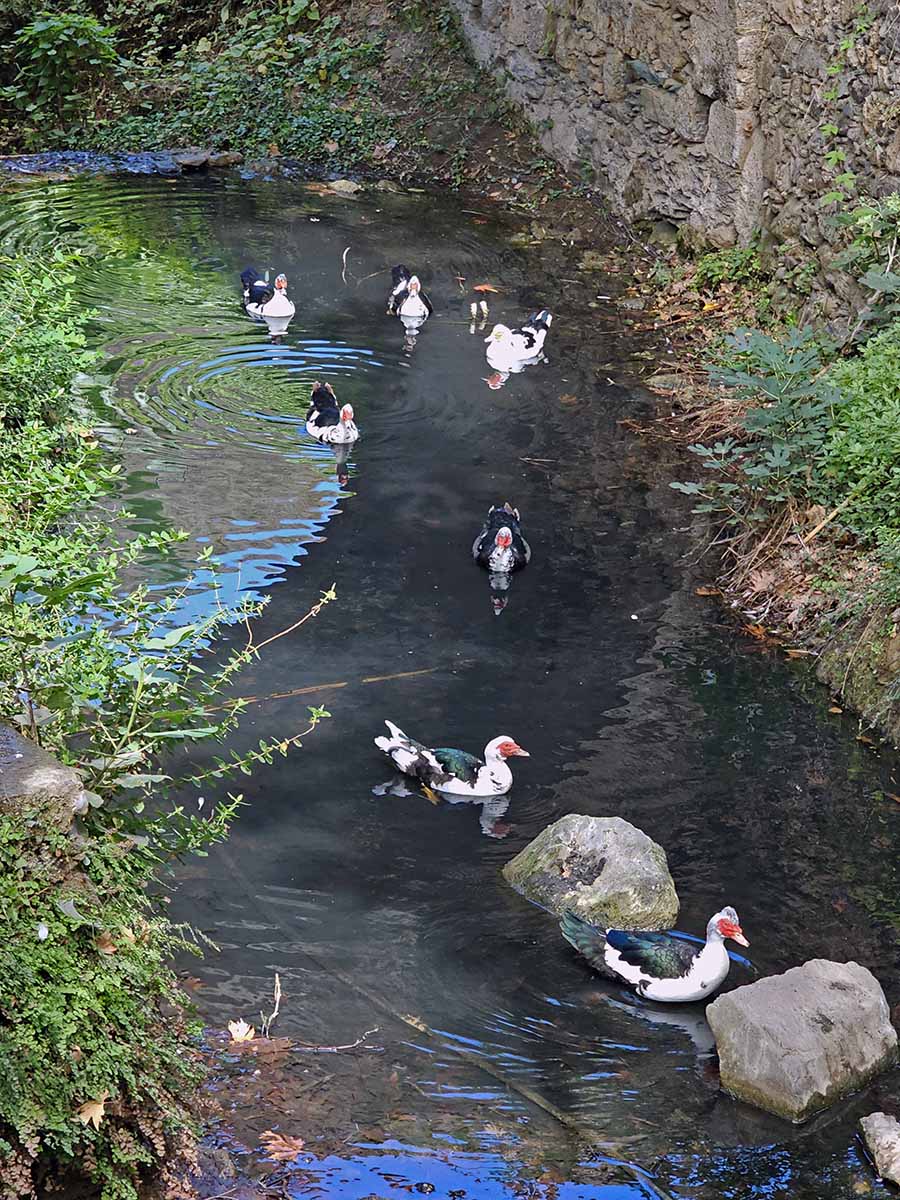
This lush ravine today looks less like a crime scene and more like a peaceful oasis of plants (plane trees, laurels, myrtles) and animals (ducks, cats). Only when a dog passes by, the serenity of coexistence gets shattered, with startled ducks flying into the spring, and cats leaping to safety in the trees above.
Springs of Amir Ali are a stop on the M49 and M49a walking trails, but can be easily accessed from the village of Karavas for a short visit. Its ever-flowing waters echo the fertility of the goddess of love, Aphrodite’s power often symbolized by timeless springs and rivers.
This place is a great pick for a picnic. For supplies, stop at Karavas Bakery. Come early, though. By the time I arrived at 1 pm, only two Philadelphia cheese pastries remained (2.40 euros each).

This family bakery, operating since 2006 in a converted 1963 olive oil factory, is also home to the famous Kythira rusks (ladopaximada). To discover the best of these crispy local treats, try the classic olive oil version first. Of course, other savory (spicy, sundried tomato & thyme, olive & oregano) and sweet versions (almond & honey, orange, cranberry) are also worth sampling – a 300g pack costs 4.50 euros.
11. Discover Kythira shipwrecks
When, in October 2022, a ship carrying over a hundred asylum seekers on the Route of Calabria, from Turkey to Italy, crashed into the rocks near Diakofti, it became the latest of accidents in Kythira shipwreck history – reminding us that even the goddess of love can’t calm every sea.
The most visible wreck today is that of the Nordland, a half-submerged Russian cargo ship lying just off the coast of the island’s main port. In August 2000, the vessel’s drunken crew managed to run it aground on the islet of Prasonisi. Bound for Turkey, the massive steel ship’s voyage ended abruptly on Kythira’s reefs, its stern sinking 30 meters below the waterline while the bow still juts from the shallows – visible all the way from Diakofti. It is a rusty magnet for experienced wreck divers.
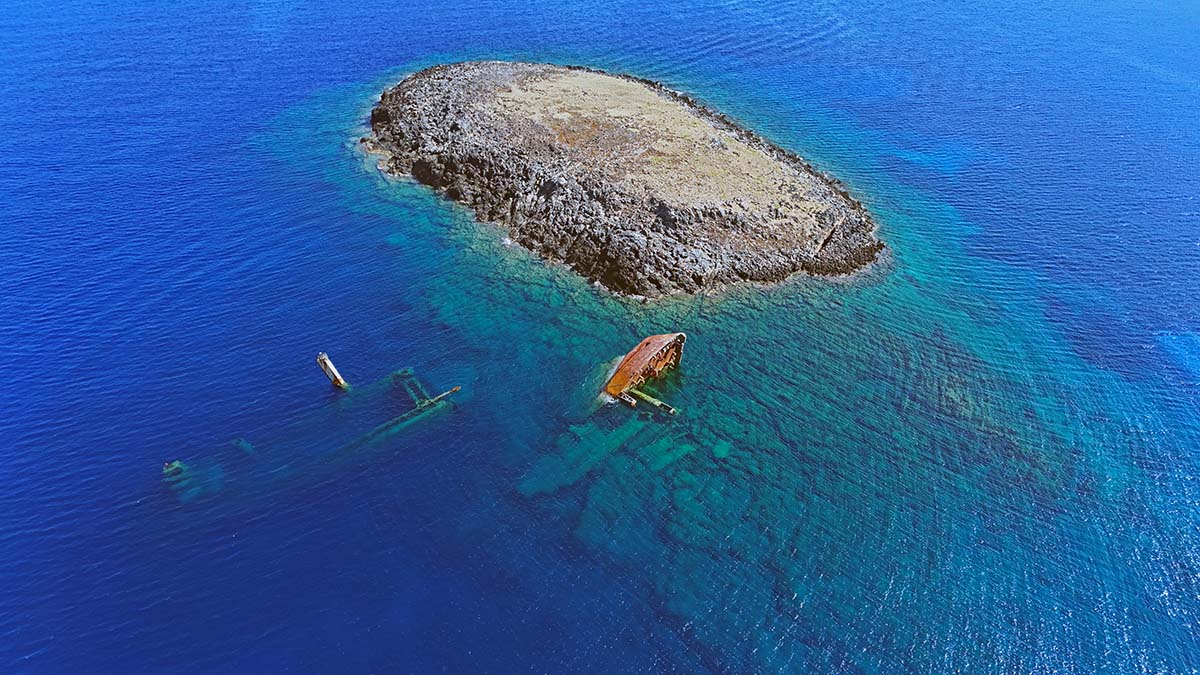
Another famous Kythira shipwreck lies in the Agios Nikolaos Bay, just outside the charming harbor of Avlemonas. In September 1802, the Mentor, a ship owned by Scottish collector Lord Earl Elgin, set sail from Athens to Malta, loaded with marble sculptures looted from the Parthenon and other ancient sites. Caught in fierce winds, the ship met its fate on the rocks that gave birth to the goddess of love. The stolen antiquities sank as if summoned by Aphrodite herself. It took two years and the help of local sponge divers to retrieve the treasures from a depth of 22 meters.
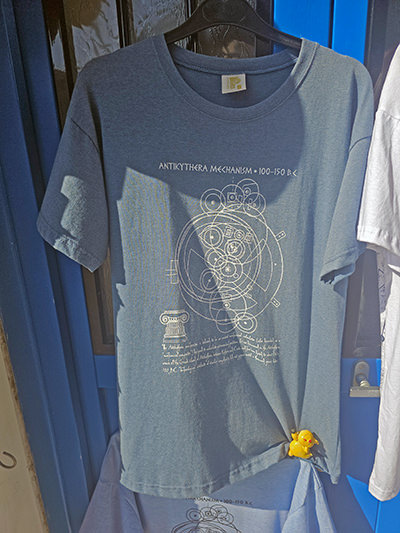
Yet the most valuable shipwreck in this region is the shipwreck of Antikythira, Kythira’s tiny sister island, halfway to Crete. In the 1st century BCE, a Roman-era merchant ship sank there, its contents lost for nearly two millennia until sponge divers stumbled upon it in 1901. Among hundreds of artifacts – ceramics, coins, jewelry – was a corroded bronze lump no bigger than a shoebox. It will turn out to be one of the greatest archeological discoveries of all time – the Antikythera Mechanism, an ancient device capable of predicting solar and lunar eclipses, tracking planetary movements (including that of Venus, Aphrodite’s planet, of course), and even marking the dates of the ancient Olympic Games.
Often called the world’s first analog computer, this masterpiece of Greek engineering and astronomical knowledge is now displayed at the National Archaeological Museum in Athens. But if you’d rather skip the mainland crowds, head to Potamos, Kythira’s largest village. On the ground floor of the Municipal building, the Mechanism of Antikythera Hall houses a working replica you can visit on weekdays from 9 am to 2 pm.
12. Sleep in the Lovebirds’ Nest – The Pigeon House
If you’re going to stay on the island of Aphrodite, you might as well pick somewhere that feels worthy of her blessing. In Potamos, a lively village known for its traditional Sunday market where you can buy everything from Kythira salt to local wine, you’ll find The Pigeon House: a lovingly restored tiny stone home that once served as a peristeronas (dovecote). Today, it’s been reborn as an elegant hideaway that perfectly blends rustic charm with quiet romance.
With thick stone walls and wooden beams, attention to detail in interior decoration, and a garden terrace perfect for slow mornings and starlit evenings, this cute chalet is one of Kythira’s most atmospheric cocoons.
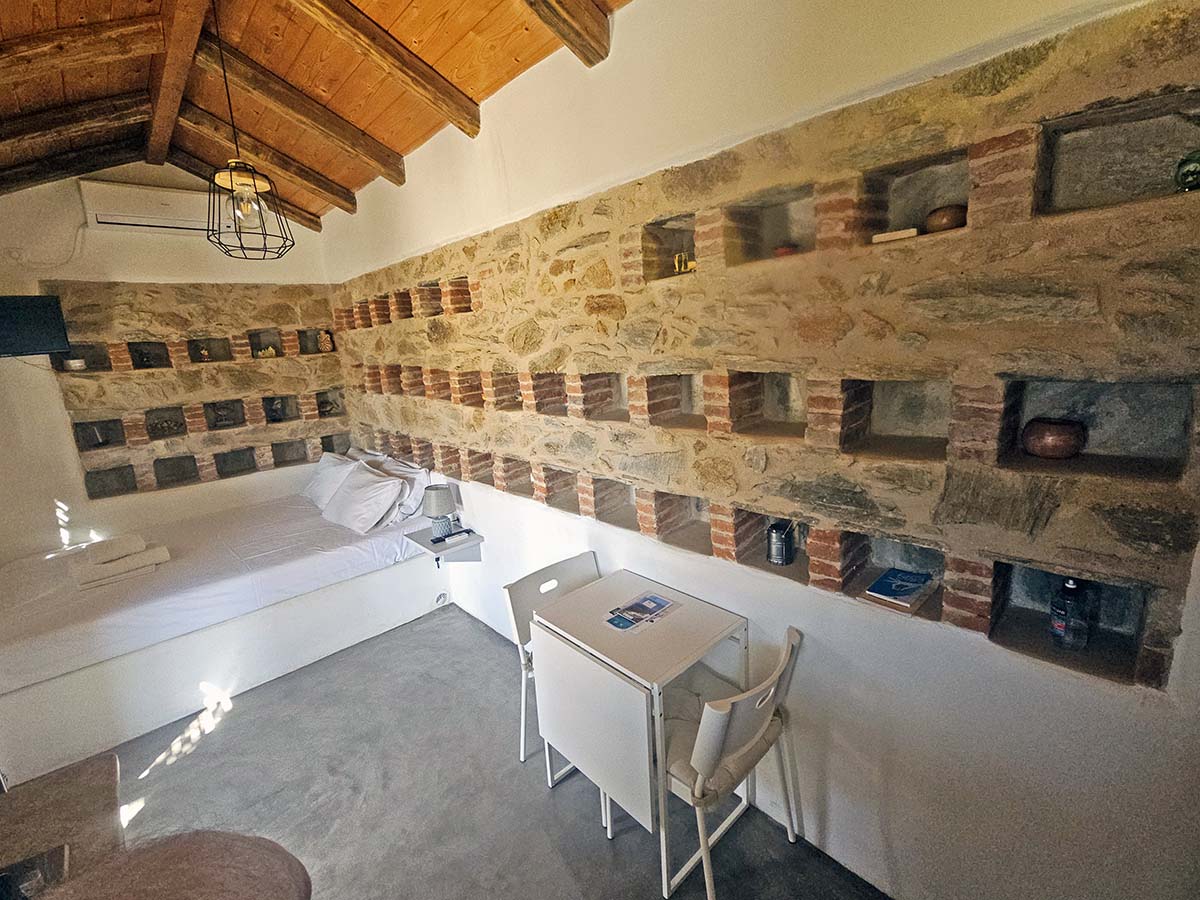
The cottage offers an open-plan space including a sleeping area with a TV, a kitchenette with a small dining table, and a separate bathroom with a walk-in shower. But what makes Pigeon House one of the most unique properties on Kythira Island is the nesting holes still visible in the exposed-brick wall. Once home to actual pigeons, they now cradle little trinkets, adding quirkiness to the property.
If you’re looking for accommodation on Kythira that’s more than just a bed for the night, the Pigeon House is a great choice. It folds the island’s history, quiet rhythms, and modern amenities such as complimentary bicycles into one storybook stay.
Managed by the ever-welcoming Irish host Claire Cremin, The Pigeon House rents from 60 euros in low season to 95 euros in peak season. Check availability here!
Walk inside the Pigeon House in this short YouTube video!
If this cozy little nest gets booked before you can claim it, don’t despair. The same host also manages other lovely stays, including Kamaraki in the traditional medieval village of Aroniadika, where I had the pleasure of spending a few peaceful nights.
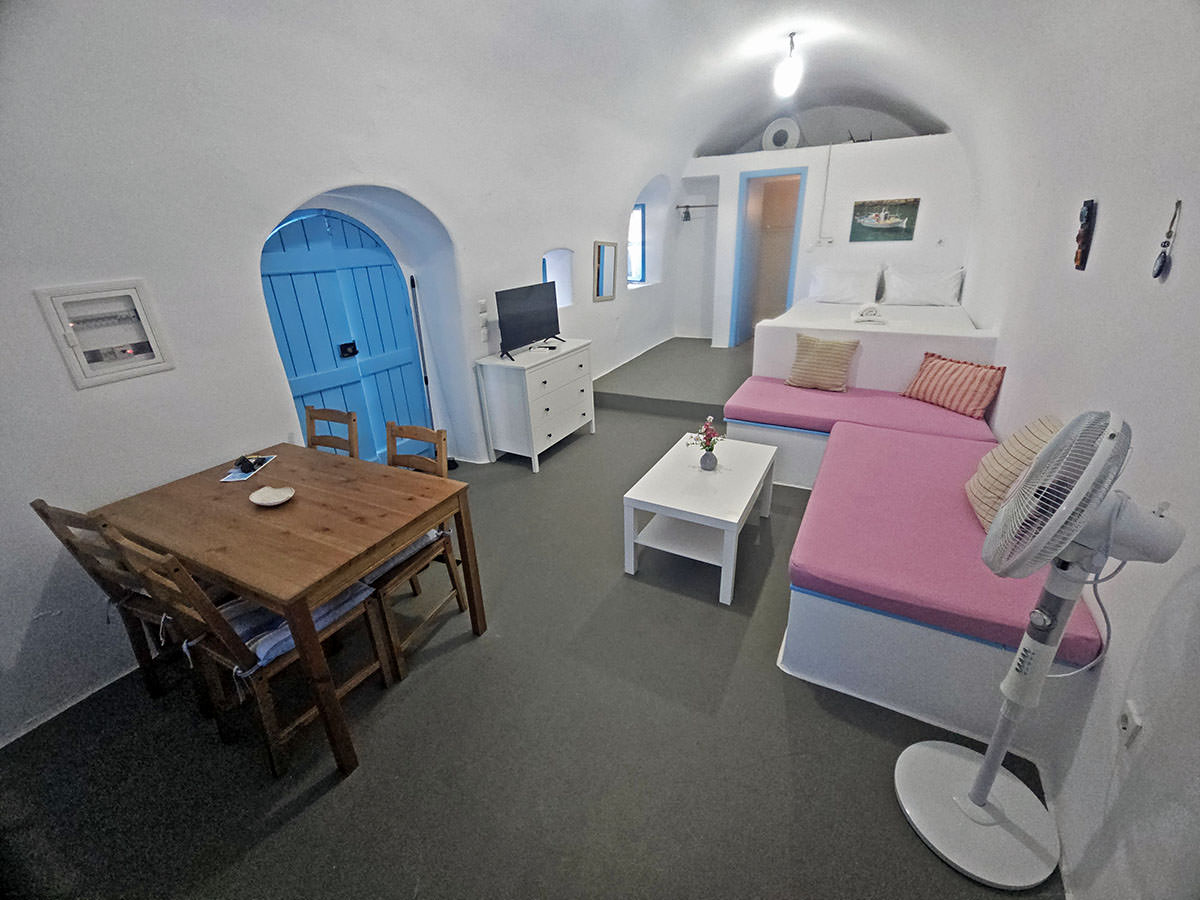
Kamaraki Aroniadika is a one-bedroom apartment designed for couples seeking both simplicity and comfort: a large bed with TV, Wi-Fi, air conditioning, and a shaded terrace under a vine.
While providing a peaceful retreat among the narrow stone alleyways, this property is centrally located, making it a great base for exploring every corner of the island.
And if you crave a taste of Kythira’s sweetest gift, you’re in luck – Aroniadika is home to the Agricultural Beekeeping Cooperative, where the island’s famous thyme honey is produced, one of the most aromatic honeys in the world.
You can book Kamaraki accommodation for 55 euros in low season, or 90 euros in high season. Check the rates for your dates here!
Take a peek inside the Kamaraki Aroniadika on YouTube!
Where to stay on Kythira Island – more ideas
If you’d like to cast your net beyond Potamos and Aroniadika, there’s no shortage of charming places to stay on Kythira, from historic homes in the Old Town to the hotels on the beach.
In Chora Kythira, Margarita Hotel is a delightful option tucked just steps away from the capital’s Central Square. Housed in a restored historic building, yet equipped with all the modern comforts – think mini-bar, electric kettle, and air-conditioning – it’s a stay that balances nostalgia with convenience. See photos and prices here.
Down by the sea in Avlemonas, Kanellis Studios is an exceptional pick. With the Baths of Aphrodite just across the street and rolling hills behind, you’ll be spoiled with views whichever way you turn. The beachfront apartments are fully equipped, providing comfort and independence. Check rates and availability here.
If you prefer the calm of the port town of Diakofti, Eden Kythira is a well-rated beachfront property offering suites and apartments, plus a swimming pool to sweeten the deal. See their offer here. If the first-row sea seat is not your mandatory criterion, consider the siren call of the pet-friendly Sirene Villas nearby.
Finally, for travelers who want to stay in Kythira’s northern reaches, Hidden Retreats Kythira above Platia Ammos offers luxury villas with stunning architecture, outdoor hot tubs, and panoramic views. It’s the type of place you might accidentally (and happily) forget to leave. Check their exceptional reviews and photos here.
How to get to Kythira Island
Floating between the Aegean and Ionian Seas, the island of Kythira sits south of the Peloponnese and north of Crete. You can reach it by air or by sea, depending on your route and travel style.
✈️ By Air
From Athens: Domestic flights from Athens International Airport (ATH) to Kythira Island National Airport (KIT – Alexandros Aristotelous Onassis) take around 45 minutes and run year-round. The airport is located roughly 20 minutes from Chora and 10 minutes from Diakofti Port.
From abroad: In summer, there are occasionally charter flights from select European cities (especially from Italy and the Netherlands) landing directly on Kythira. Otherwise, Athens remains your main connection hub for international arrivals.
🚢 By Ferry
From Neapoli (Laconia): The most common and shortest Kythira Island ferry route, taking about 1 hour and 15 minutes to reach Diakofti, the island’s main port.
From Piraeus (Athens): Longer ferries from Kythira to Athens (about 6–7 hours) operate several times a week. If you’re traveling from Santorini to Kythira, the shortest way would be to connect via Piraeus. Equally, there are no direct flights or ferry routes between Mykonos and Kythira – you’ll need to go to Athens first.
From Crete (Kissamos port, near Chania): Ferries connect Kythira to western Crete in roughly 4 hours.
From Gythio (Mani Peninsula): A scenic ferry route from Gythio to Kythira (around 2-3 hours) is ideal if you’re exploring the southern Peloponnese.
How Many Days to Stay in Kythira
Kythira isn’t the kind of island you rush through. Its magic unfolds slowly. That said, how long you stay depends on what kind of traveler you are.
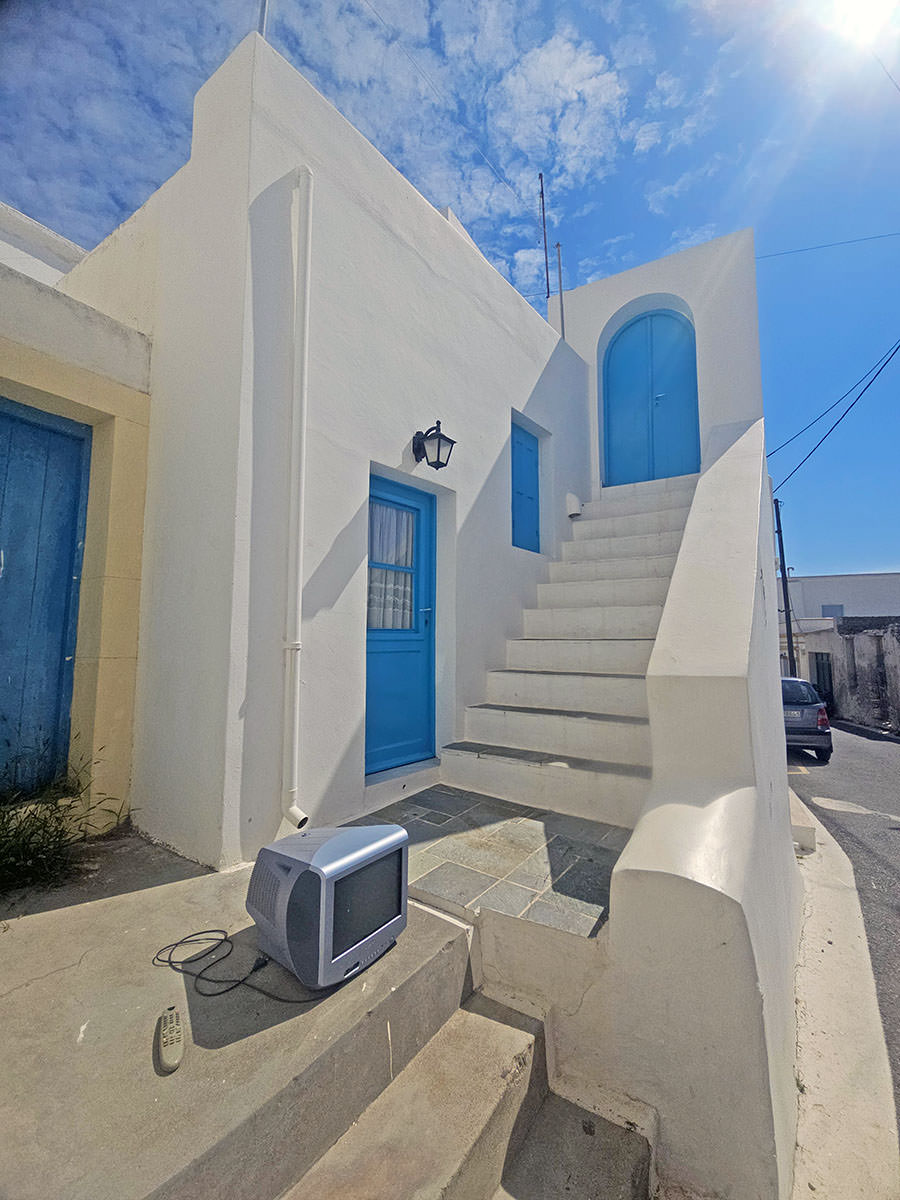
A Long Weekend (3–4 Days)
Just enough to taste Kythira’s contrasts – the Venetian castle above Chora, the twin coves of Kapsali, and a few standout beaches like Kaladi or Fyri Ammos. Perfect for a relaxed escape if you’re flying in from Athens.
Best for: A romantic getaway or a short reset surrounded by sea and myth.
A Full Week (6–8 Days)
The sweet spot for most travelers. A week gives you time to explore both north and south Kythira, hike the Watermills Valley to the waterfalls, discover hidden spots like Limni Beach and the Green Lake, and linger longer in Avlemonas or Mylopotamos without watching the clock.
Best for: Travelers who want to balance beach days, hiking, and village life.
Ten Days or More
If you can, stay longer. Kythira has a way of bending time – and the longer you stay, the more it rewards you. Days stretch, plans soften, and suddenly you’re part of the island’s rhythm. You can wander without purpose, find secret coves, get to know locals, or even hop over to Antikythera on a day ferry.
Best for: Explorers, writers, photographers, and anyone who loves to be off the tourist grid.
When Should You Go to Kythira?
Kythira Island Weather
Kythira sits where the Aegean, Ionian, and Cretan seas meet, and its weather reflects that crossroads – its climate is milder and more balanced than on many Greek islands.
Come in spring or autumn for peace and nature, summer for the classic Greek island glow, and winter if you want Kythira almost entirely to yourself.
🌸 Spring (April–June)
Spring might just be the best time to visit Kythira. The island turns lush and fragrant – hillsides carpeted in wildflowers, olive groves shimmering in new green, and hiking trails like the Valley of the Watermills at their most beautiful.
Temperatures hover between 18°C and 26°C, and the sea slowly warms up for the season.
Best for: Hikers, photographers, and explorers of sleepy villages.
☀️ Summer (July–September)
Summer brings long, golden days and warm nights scented with thyme and sea salt. Expect temperatures between 28°C to 33°C, though the meltemi winds (northern summer winds) often cool the afternoons.
That said, when heat and wind join forces, nature sometimes fights back – Kythira fires in August 2017 and July 2025 scorched about 10% of the island. Yet when skies are clear and seas calm, this is Kythira at its finest, perfect for swimming at Kaladi, Limni, or Fyri Ammos Beach, sailing the coast, or diving into underwater shipwrecks.
Best for: Beach lovers, divers, and anyone chasing sunlight.
🍂 Autumn (October–November)
Autumn feels like a well-kept secret. The crowds are gone, the light turns honey-gold, and villages exhale after summer. Temperatures linger between 20°C and 27°C, ideal for long walks and slow travel. Kythira sea temperature in October can actually be warmer than in June, averaging 23.1°C.
Harvest season brings local festivals, olive picking, and freshly pressed oil.
Best for: Travelers who prefer authenticity over bustle.
🌧️ Winter (December–March)
Winters are mild yet moody – expect wind, rain, and temperatures between 10°C and 17°C. Most restaurants and guesthouses close, but the island’s dramatic coastlines feel even more mythic in solitude.
Best for: Writers, nature lovers, and anyone seeking silence.
Kythira festivals
If you’re still not sure about the best time to visit Kythira, maybe this selection of the most important island festivals can inform your decision.
Feast of Agia Elesa (August 1)
On this day, a solemn pilgrimage is held at the Monastery of Agia Elesa, dedicated to a young martyr from the 4th century, who was whipped, hanged, and beheaded by her own pagan father for converting to Christianity. Locals climb the hill to honor her courage and devotion, with prayers, candles, and songs.
Kythira Wine Festival (Saturday before August 15)
Held in Minata village, Kythira Wine Festival is one of the island’s liveliest summer nights. Expect live music, dancing, and plenty of local wine – a joyful celebration of Kythira’s long winemaking tradition.
Kythira Panigiri (August 15)
The biggest celebration of the summer is centered around the feast day of the Virgin Mary (Panagia). It begins with church services and continues into the night with tsirigotika rhythms – folk dances unique to Kythira – and long tables filled with goat stew, wine, and sweets. The largest gathering is on the central square of Potamos.
Similar panigiria (village festivals) can be found all across the island – in Kalokairines (July 15), Kato Livadi (last Saturday in July), Avlemonas (August 6), Mitata (August 9), Mylapotamos (August 12), Pitsinianika (August 16), and Fratsia (August 17).
Portokalia Festival (last weekend of August)
Named after the orange tree valley, the Portokalia Festival is organized in the village of Karavas. It marks the end of summer with concerts of both popular and local artists, sports games, and local delicacies.
Kalamos Festival (September 15)
On the occasion of Agios Nikitas’ feast day, locals gather in the courtyard of the old school in Kalamos for a night of traditional food, music, and dancing under the stars.
Agia Pelagia Festival (September 23)
The seaside village of Agia Pelagia comes alive with folk music and dancing along its coastal road – a vibrant farewell to summer.
Festival of Panagia Myrtidiotissa (September 24)
The island’s most sacred day honors Panagia Myrtidiotissa, Kythira’s patron saint. Pilgrims gather at the Monastery of Myrtidia, where, in a myrtle bush, the miraculous icon of the Virgin Mary was discovered by a shepherd in the 14th century. It’s a day of reverence, unity, and faith, a fitting finale to Kythira’s festive season.
Is Kythira worth visiting? – Conclusion
Kythira isn’t the kind of island that overwhelms you. It doesn’t shout its beauty – it whispers it. It takes a few days to adjust to its rhythm, to tune into the silence between the cicadas, to notice how the light softens the old stone walls at dusk.
This is the island where Aphrodite is said to have risen from the sea foam. You can still feel something divine in the way its beaches and waters take perfect forms, in the glow of the horizon after sunset, or in the warmth of strangers who greet you like old friends.
Kythira reminds you that travel should be unhurried, genuine, and full of wonder. Just like love
Kythira has a quiet power: it doesn’t seduce you instantly, but once it does, you’ll hardly let it go.
So yes, Kythira is worth a visit. Not because it’s loud or famous, but because it reminds you what love, and travel, should really feel like: unhurried, genuine, and full of wonder.
And when you finally leave, on a ferry across the mythic waters of Aphrodite’s birth, you’ll catch yourself looking back at the sea. Behind all those unfortunate shipwrecks and salty rocks covered in undying flowers, you’ll be half-expecting to see the goddess rising. She might even command you to build a bridge, so you can return to the place you fell in love with, again and again.
Did you like this guide for Kythira Island?
Pin it for later!
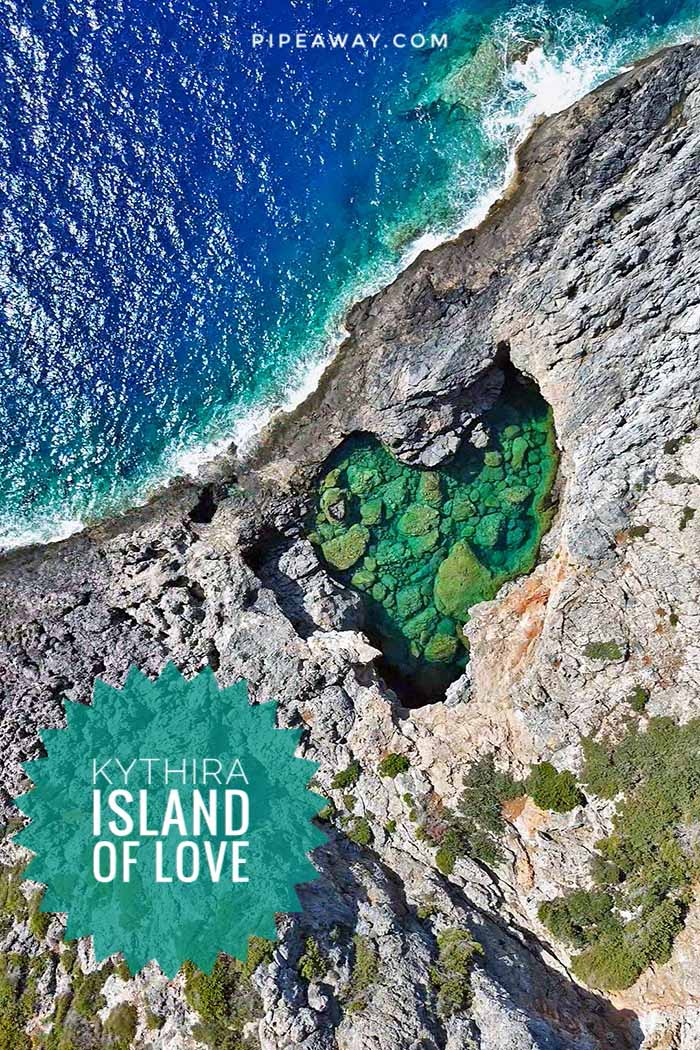
Disclosure: My stay at the Kamaraki in Aroniadika, as well as the rental car from Drakakis, were complimentary, but all opinions are my own. Also, this post may contain affiliate links, meaning if you click on them and make a purchase, Pipeaway may make a small commission, at no additional cost to you. Thank you for supporting our work!

